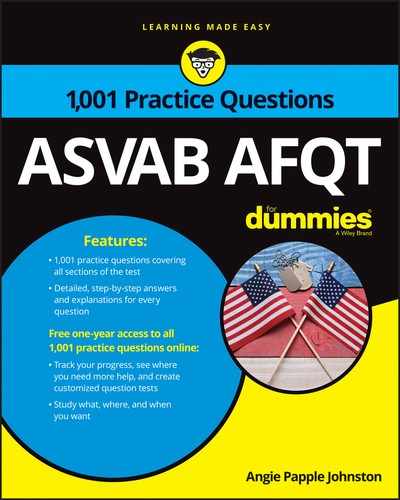Chapter 5
Answers
Word Knowledge
-
A. agreement.
Accord is a noun that means to have a concurrence of opinion.
“About 90 percent of voters were in accord with the candidate’s plan.”
-
A. set up.
Establish is a verb that means to set up, found, or create.
“Will you help me establish a new chapter of the club in Oakland?”
-
C. get.
Obtain is a verb that means to come into possession of.
“You’ll do much better if you obtain a copy of the answer key.”
-
D. bold.
Brazen is an adjective that means excessively bold or brash.
“Steve’s brazen attempt to ruffle his opponent’s feathers didn’t work.”
-
B. useless.
Vain is an adjective that means fruitless, unproductive, or futile.
“Kim tried in vain to stop them, but the papers flew out the window.”
Vain is also an adjective that means excessively proud or conceited (for example, “He’s so vain that he can’t walk past a mirror without stopping to look at himself”).
Don’t confuse vain with vein, which is a tube in your circulatory system that carries blood.
-
A. strength.
Fortitude is a noun that means strength or guts in the face of adversity.
“She had the intestinal fortitude to join the military.”
Strength is a better answer than Choice (B), bravado, because bravado refers to a bold manner or a show of bold actions intended to impress or intimidate; you can be bold or show off without being strong in the face of adversity.
-
B. believable.
Plausible is an adjective that means believable; it describes something that has the appearance of truth or reason.
“The prosecutor outlined a plausible scenario so the jury would convict the defendant.”
-
D. convince.
Persuade is a verb that means to convince someone to do something by advising or urging.
“I tried to persuade my recruiter to let me skip the ASVAB.”
-
C. conversation.
Dialogue is a noun that means a conversation between people.
“Let’s start a dialogue on improving customer service.”
-
B. excused.
Exempt means free from, excused from, or not subject to an obligation to which others or other things are subject.
“I’m exempt from getting my flu shot at work because I already got one at the pharmacy.”
-
A. support.
Buttress is a verb that means to support or hold up. It’s also a noun that refers to something that offers support (flying buttresses are the curved supports you see on the outer walls of a lot of gothic cathedrals).
“After the first wall collapsed, the builder rebuilt it with a buttress.”
-
A. strange.
Bizarre is an adjective that means conspicuously unconventional or unusual.
“Seasoning your chicken with curry and maple syrup creates a bizarre taste.”
-
D. responsible.
Liable is an adjective that means subject to legal action, held legally responsible, or subject to be affected by something.
“The hotel owners were liable for the guest’s fall down the stairs because they failed to repair the railing.”
Libel is a false, harmful statement that appears in writing; if that had been the word in the question, Choice (B) would be the correct answer. Slander is a false, harmful spoken statement.
-
C. hopeful.
Optimistic is an adjective that means expecting the best.
“I’m optimistic that you’ll do well on the Word Knowledge subtest because you’re using this book.”
-
B. change.
Affect is a verb that means to have an effect upon something.
“Don’t let her love of country music affect your friendship.”
-
C. maze.
Labyrinth is a noun that means a complex system of pathways or tunnels in which it’s easy to get lost — like a maze.
“The mouse made its way through the labyrinth and found the cheese six times today.”
-
B. obvious.
Blatant is an adjective that means completely lacking in subtlety; it describes something that’s done openly and unashamedly.
“That’s a blatant lie!”
-
A. movement.
Maneuver is a noun that means a deliberate, coordinated movement to reach a particular goal; typically, a maneuver requires some level of skill.
“The pilots have been practicing that maneuver for months.”
-
A. tell.
Disclose is a verb that means to reveal or make public.
“Owners are required to disclose problems with their homes when potential buyers ask.”
-
D. isolate.
Quarantine is a verb that means to place into isolation (such as for medical reasons).
“If you get sick, we’ll have to quarantine you.”
-
D. skilled.
Adept is an adjective that means extremely skilled.
“Danielle is adept at preventing mistakes from slipping through.”
-
C. retreat.
Recede is a verb that means to pull back, move backward, or retreat.
“We watched the fog recede as the sun came up.”
-
A. changeable.
Volatile is an adjective that means subject to rapid or unexpected change.
“The situation is becoming more volatile as more people arrive on the scene.”
-
D. brave.
Intrepid is an adjective that means brave in the face of danger.
“The intrepid soldiers of the 82nd Airborne Division have no qualms about strapping on a parachute and jumping from a perfectly good airplane.”
-
B. anger.
Wrath is a noun that means vengeful anger or punishment.
“Sarah, afraid of incurring her sister’s wrath, hid the stained shirt.”
-
B. grow.
Proliferate is a verb that means to grow rapidly.
“Stories of the mishap proliferated until the whole school knew about it.”
-
C. abandon.
Vacate is a verb that means to abandon, empty, or move out of something.
“We all need to vacate the building when the alarm sounds.”
-
A. pitiful.
Pathetic is an adjective that means causing or evoking pity, sympathetic sadness, or sorrow.
“The rain-soaked kitten looked so pathetic that I tried to dry her with my jacket.”
-
D. sanctuary.
Refuge is a noun that means a safe place, shelter, or sanctuary.
“The wildlife needed a safe place to go, so the county created a refuge within the park.”
-
B. scrub.
Scour is a verb that means to polish or clean a surface by washing, rubbing, or scrubbing with an abrasive cloth.
“The drill sergeant made us scour the floor before we could go to chow.”
Scour can also mean to thoroughly search something, such as when someone says, “She scoured the crime scene for evidence.”
-
C. dislike.
Aversion is a noun that refers to a feeling of intense dislike.
“She had an aversion to broccoli, but she adored cauliflower.”
-
A. conflict.
Strife is a noun that means bitter conflict, a lack of agreement or harmony, or violent dissension.
“There’s strife within the community over the proposed base closure.”
-
C. sustain.
Nourish is a verb that means to sustain, provide with nourishment, or supply.
“Adding fertilizer to the soil helps nourish your plants.”
-
A. step on.
Tread is a verb that means to put down your foot; you can also use it as a noun when you’re describing the grooved surface of a tire.
“Tread softly, or you’ll wake the guard dog.”
-
D. comfort.
Console is a verb that means to give moral or emotional strength to another person or an animal.
“Parents can sometimes console a crying baby by singing.”
-
B. repartee.
Banter is a noun that means teasing, joking repartee.
“When you aren’t cleaning or training, you’ll have plenty of time for witty banter.”
-
A. believable.
Credible is an adjective that means believable, plausible, or likely to be true.
“Can you provide a credible source for your claims?”
-
B. deteriorate.
Erode is a verb that means to wear down, deteriorate, or decay.
“The stream, which had been running through the mountains for years, caused the rock to erode.”
-
B. create.
Generate is a verb that means to bring into existence or to supply.
“We need to generate awareness on this topic.”
-
D. way.
Mode is a noun that refers to how something is done or how it happens.
“Which mode of learning works best for you?”
-
D. prevent.
Foil is a verb that means to hinder or prevent someone’s efforts, plans, or desires.
“If you make noise, you’ll foil my plan to sneak out.”
-
A. enclosed space.
Chamber is a noun that means an enclosed space; it can also mean a legislative, administrative, or judicial assembly.
“He closed the door to the chamber so he could have privacy.”
-
D. helper.
Aide is a noun that refers to someone who acts as an assistant or helper.
“He didn’t write the speech. His aide did.”
Don’t let Choice (A) throw you off — abet means to aid or help, but the word in the question is aide. The e on the end changes the meaning.
-
A. confuse.
Although stump is a noun meaning the base of a tree left after it’s been chopped down, it’s also a verb that means to confuse, perplex, or confound someone.
“Difficult Arithmetic Reasoning questions always stump me.”
-
B. assert.
Insist is a verb that means to assert one’s position strongly or to be emphatic or resolute in a refusal to compromise.
“I insist that you stop working, sit down, and relax.”
Choice (D) is a close choice, but it’s not the best answer. To demand is to make a request while insisting on immediate attention or obedience, as if the person making the demand had a right to it.
-
A. uninteresting.
Bland is an adjective that means uninteresting or lacking stimulating characteristics; it can also refer to flavorless, tasteless food.
“The beginning of the movie was so bland that I almost didn’t watch the rest of it.”
-
B. lookout.
Sentinel is a noun that refers to a person who keeps watch.
“Give the sentinel the password, and he’ll let you in.”
-
D. cancel.
Repeal is a verb that means to cancel officially.
“The president wanted to repeal the law because he believed it was unconstitutional.”
-
D. work.
Labor is a noun that means any piece of work that is undertaken or attempted, such as a project or task.
“When you build a house, you should be paid fairly for your labor.”
-
A. anomaly.
Aberration is a noun that means a departure from what’s normal or expected.
“We found an aberration in the results, but we don’t need to worry about it.”
-
D. charming.
Winsome is an adjective that means attractive or appealing in appearance or character.
“His talent and winsome smile made him a great choice for the lead role.”
-
A. first.
Initial is an adjective that means existing or occurring at the beginning of something.
“My initial thought was that the house was locked, but then I realized the door was open.”
-
C. fanatical.
Rabid is an adjective that describes extreme or fanatical belief or support of something.
“The rabid zealots couldn’t stand the idea of others not sharing their belief system.”
-
A. movable.
Mobile is an adjective that means able to move freely or easily.
“The team set up a mobile command center that they can use anywhere.”
-
D. request.
Solicit is a verb that means to ask for or try to obtain something.
“Volunteers knocked on every door in the neighborhood to solicit donations.”
-
B. misconception.
Fallacy is a noun that means mistaken belief.
“The notion that everything on the Internet is true is a fallacy.”
Although Choice (A) could be true, it’s not the best choice because misnomer refers to a wrong or inaccurate name or designation, not a belief.
-
C. outer surface.
External is an adjective that refers to the outer surface of an object.
“Power-wash the external part of your home to increase its curb appeal.”
-
B. vehement.
Vociferous is an adjective that describes a person or speech that is vehement or makes a loud, confused noise.
“The vociferous crowd wouldn’t stop shouting, even after the controversial comedian left the stage.”
-
A. change.
Convert is a verb that refers to something that causes a change in form, character, or function.
“It’s easy to convert this rain poncho into a shelter.”
-
D. think.
Consider is a verb that means to think carefully about something.
“The lieutenant had to consider all his options before making a decision.”
-
C. fast.
Prompt is an adjective that means immediate or done without delay.
“I appreciate your prompt reply because we have only two more hours to take action.”
-
A. depravity.
Turpitude is a noun that means depravity, moral corruption, or wickedness.
“You can be barred from U.S. citizenship for moral turpitude.”
-
C. substitute.
Makeshift is an adjective that refers to something that serves as a temporary substitute for something better.
“The soldiers put together a makeshift fighting position, which we call a ‘hasty’ in the military.”
-
B. is composed of.
Comprise is a verb that means to consist of or to be made up of.
“This book comprises 1,001 practice questions.”
-
D. bogus.
Spurious is an adjective that means false or fake.
“The reporter had to sort through both authentic and spurious claims to find the truth.”
-
C. area.
Expanse is a noun that means an area of something (usually land or sea) that presents a continuous surface.
“The humpback whale can travel anywhere within the expanse of ocean between Alaska and Hawaii.”
-
A. menacing.
Fearsome is an adjective that means menacing, frightening, or scary.
“Kids with active imaginations may believe there are fearsome monsters in their bedroom closets.”
-
B. pretentious.
Sophomoric is an adjective that means pretentious or juvenile.
“His antics were sophomoric and, frankly, quite irritating.”
-
D. infuriate.
Exasperate is a verb that means to irritate intensely or to infuriate.
“The rest of the group was exasperated by Liliana’s lack of commitment to the project.”
-
B. shortage.
Scarcity is a noun that describes the state of being in short supply of something or experiencing a shortage of something.
“A scarcity of food on the savannah caused the lion to move his pride closer to the city.”
-
A. withstand.
Resist is a verb that means to withstand the action or effect of something.
“The reinforced walls can resist high winds.”
-
A. fake.
Ersatz is an adjective that means fake or unreal. You can also use it to describe a product that’s made or used as an inferior substitute for something else.
“These ersatz paintings could pass for works by the masters.”
-
D. be a warning.
Portend is a verb that refers to someone or something acting as sign or warning that something big or calamitous is about to happen.
“A common misconception is that green clouds always portend a tornado.”
-
C. understandable.
Lucid is an adjective that means easy to understand.
“The author gives a lucid account of early American history.”
-
B. excluded.
Ostracized is a verb that means excluded from a group by general consent.
“When Patrick and D. J. decided not to follow in their father’s footsteps, the family ostracized them.”
Although Choice (C), parted, is similar, it’s not the best answer because being separated or parted refers to the result of being ostracized.
-
A. tempt.
Allure is a verb that means to attract, charm, or tempt.
“Flowers evolved with bright colors to allure bees to fertilize them.”
-
B. joyful.
Gleeful is an adjective that means triumphantly joyful, happy, or delighted.
“The children’s gleeful laughter made all the adults smile.”
-
A. sedate.
Tranquilize is a verb that means to have a calming or sedative effect on.
“Wildlife officials will have to tranquilize the bear if they see it in a neighborhood.”
-
C. resist.
Oppose is a verb that means to actively resist or refuse to comply with a person or a system.
“Half the community was ready to oppose the school’s reopening.”
-
A. customs.
Mores is a noun that refers to the characteristic customs and conventions of a community. It’s pronounced like morays (the eels).
“Some things that are normal in other countries are against social mores in the U.S.”
-
D. become chafed.
Chap is a verb that means to become chafed, cracked, rough, or sore, most often through exposure to cold weather.
“If you don’t use lip balm, your lips will chap.”
-
B. bossy.
Overbearing is an adjective that means unpleasantly or arrogantly bossy or domineering.
“The older twin was overbearing, while the younger was meek and quiet.”
-
B. fairness.
Equity is a noun that describes the quality of being fair and impartial.
“Fighting for pay equity is a cornerstone of the candidate’s campaign.”
-
A. understated.
Subtle is an adjective that describes a change or distinction that’s delicate and understated.
“The subtle fragrance of flowers drifted through the open window.”
-
C. economic.
Pecuniary is an adjective that means of or relating to money.
“He was held liable for pecuniary damages when the jury found him guilty.”
-
B. impermanent.
Temporary is an adjective that means lasting for a limited period of time.
“The benefits of energy drinks are temporary; they wear off after a few hours.”
-
D. perceptive.
Insightful is an adjective that means being perceptive; it also means having or showing an accurate, deep understanding.
“The professor gave an insightful presentation that left the entire class in awe.”
-
A. without depth.
Superficial is an adjective that means occurring or existing at or on the surface.
“He suffered superficial burns, but he’ll be okay.”
-
C. deliver.
Render is a verb that means to provide, give, furnish, or deliver. In business, people may ask for payment for “services rendered.”
“The jury won’t be gone long before they render a verdict.”
-
B. unchanging.
Constant is an adjective that means occurring continuously over time. It’s also a noun that means a situation or state of affairs that doesn’t change.
“The constant noise became irritating.”
-
A. delegation.
Commission is a noun that refers to a group of people who have been officially charged with a particular responsibility.
“The commission’s main responsibility is to gather information on ASVAB test results.”
-
C. endeavor.
Venture is a noun that means a risky or daring undertaking or endeavor.
“Bravo Company ventured into the city after dark to find hidden caches of weapons.”
-
D. vary.
Range is a verb that means to vary or extend between certain limits.
“The students’ ages range between 15 and 18 years.”
-
A. plan.
Scheme is a noun that means a systematic plan or arrangement.
“The pair came up with a scheme to rob the bank.”
-
C. request.
Plea is a noun that means an urgent, emotional request.
“The king heard the crowd’s collective plea for mercy.”
-
B. post
Stake is a noun that refers to a post with a point at one end. Don’t get stake confused with steak — the former holds up your tent when you’re on field exercises, and the latter is what you dream about while you’re in Basic Combat Training.
“Use a mallet rather than a claw hammer to pound in the stakes.”
-
B. characteristic.
Attribute is a noun that refers to a characteristic inherent in someone or something.
“The dog’s friendliness is his best attribute.”
-
C. impressive.
Awesome is an adjective that means extremely impressive. It’s typically used for something that inspires great admiration, apprehension, or fear.
“The awesome collection on display at the museum leaves visitors speechless.”
-
D. annoy.
Provoke is a verb that means to deliberately annoy someone or make someone angry.
“Don’t provoke your siblings by calling them names.”
-
B. quote.
Cite is a verb that means to quote something as evidence.
“Cite your sources in the bibliography.”
Pay attention to the way things are spelled on the ASVAB; if you were rushing, you may have chosen Choice (D) — but that would be the answer only if the question asked you to define site.
-
A. lectured
Addressed is a verb that means to speak to a person or a group, usually in a formal way.
-
D. examine
Analyze is a verb that means to examine critically.
-
C. racket
Cacophony is a noun that refers to a harsh, discordant mixture of sounds.
-
B. contain
Include is a verb that means to contain or to place in a category, or to make part of a whole set.
-
A. idea
Concept is a noun that means a general notion or idea.
-
B. answer
Solution is a noun that means the state of being solved; it also means an explanation or answer.
-
D. thread
Strand is a noun that means a thread or threadlike part of something.
-
A. logical
Coherent is an adjective that means logical, consistent, or orderly.
-
B. choice
Selection is a noun that means choice; it also means an aggregate of things displayed for someone to choose from.
-
D. commentary
Narrative is a noun that means a commentary, story, or account of events.
-
A. pertinent
Relevant is an adjective that means pertinent or bearing on a certain matter.
-
D. assembly
Rally is a noun that means a get-together or assembly.
-
A. separate
Divide is a verb that means to separate into parts, groups, or sections.
-
B. speed
Velocity is a noun that means the speed of something in a given direction.
-
D. distinguish
Differentiate is a verb that means to mark differently or distinguish.
-
B. current
Draft is a noun that means a current of air in any enclosed space; it can also refer to a drawing or text. Remember that these questions on the ASVAB are also about context — the only answer that makes sense in this context is Choice (B).
-
C. important
Significant is an adjective that means important or of consequence.
-
A. stress
Emphasis is a noun that means special stress or importance put on something.
-
D. mistake
Error is a noun that means a mistake or the state or condition of being wrong.
-
A. passage
Excerpt is a noun that means a part or passage taken from a book, speech, or other text.
-
C. mix
Combine is a verb that means to mix, unite, or join things.
-
B. skillful
Resourceful is an adjective that means able to deal with events skillfully and promptly.
-
D. itemize
Enumerate is a verb that means to mention something separately, as if in counting; it also means to itemize.
-
A. foundational
Underlying is an adjective that means fundamental, basic, or foundational.
-
B. data
Statistics is a noun that means numerical facts or data.
-
C. conform
Assimilate is a verb that means to conform or adjust to the customs of a group, nation, or other entity.
-
C. essential
Crucial is an adjective that means essential or critical.
-
A. materialization
Emergence is a noun that describes the act or process of emerging, materializing, or developing.
-
B. beginning
Genesis is a noun that means beginning or origin.
-
D. uncomplicated
Simple is an adjective that means plain or uncomplicated.
-
C. advice
Counsel is a noun that means advice, opinion, or instruction. Don’t confuse counsel with council, which is a noun that means an assembly of people who get together for consultation, deliberation, or advice.
-
C. authenticate
Corroborate is a verb that means to make more certain, confirm, or authenticate.
-
A. obtain
Achieve is a verb that means to get or obtain through effort.
-
B. compensate
Reimburse is a verb that means to refund, pay back, or compensate.
-
C. environment
Milieu is a noun that means environment or surroundings, particularly of a social or cultural nature.
-
D. nondiscriminatory
Egalitarian is an adjective that means characterized by belief in the equality of all people, especially in politics and economics.
-
A. thin
Narrow is an adjective that means thin, not broad or wide.
-
A. insufficient
Meager is an adjective that means insufficient; it also means deficient in quantity or quality.
-
C. unfavorable
Adverse is an adjective that means unfavorable or opposing one’s interests.
-
D. equivalent
Tantamount is an adjective that means equivalent.
-
B. keep
Retain is a verb that means to keep possession of, to continue to use, or to continue to hold or have.
Make sure you’re paying attention to detail on the ASVAB. Even one letter in a word can change an answer; if you saw retrain instead of retain, you’d pick Choice (A).
-
D. communicate
Convey is a verb that means to communicate or make known. It also means to carry, bring, or transport something, but that definition doesn’t work in this context.
-
B. estimate
Approximate is a verb that means to estimate. Approximate can also be an adjective that means nearly exact but not perfectly accurate or correct.
-
B. plan
Proposal is a noun that means a plan or scheme that someone has put together.
-
C. prejudice
Bias is a noun that means a prejudice or hostile feelings about a social group. It also means a particular inclination, feeling, or opinion, especially if it’s preconceived or unreasoned.
-
A. slide
Slither is a verb that means to slide down or along a surface or to walk or move with a sliding motion.
You’ll encounter questions on the ASVAB that have choices that seem a bit confusing. In this instance, Choice (C), move, seems like a pretty good fit — but it’s your job to find the most correct answer. The word slither does refer to a movement, but it’s a very specific type of movement.
-
A. debatable
Moot is an adjective that means open to discussion or debate.
-
B. unrelated
Irrelevant is an adjective that means not relevant, not applicable, or not pertinent.
-
A. changes
Amendment is a noun that means an alteration that’s made by correction, addition, or deletion.
Choice (C), corrections, comes very close to being the correct answer, but the sentence simply says the editor made amendments to the story; it doesn’t specify whether the changes were corrections, additions, or deletions.
On the ASVAB, you’ll have to choose the most correct answer (which means you won’t always find an exact definition among your choices). In this case, the one that’s most correct is Choice (A).
-
B. aplomb
Equanimity is a noun that refers to aplomb, imperturbable self-possession, or poise.
-
A. peace
Accord is a noun that means proper relationship or harmony.
-
B. argue
Advocate is a verb that means to support or urge by argument.
-
A. catastrophe
Disaster is a noun that describes a sudden event that causes great damage or loss of life.
-
D. trade
Barter is a verb that means to exchange goods or services for other goods or services without using money, or essentially, to trade.
-
B. decode
Decipher is a verb that means to decode or discover the meaning of something that’s difficult to understand.
-
C. enthusiastic
Ardent is an adjective that means enthusiastic or passionate.
-
A. respected
Admire is a verb that means to regard a person, quality, or thing with respect or approval.
-
D. deserted
Desolate is an adjective that means deserted of people, bleak, or dismal.
-
A. strange
Eccentric is an adjective that means unconventional, abnormal, or strange.
-
A. parody
Satire is a noun that refers to the use of irony, exaggeration, humor, or ridicule to criticize something.
-
A. proposition
Suggestion is a noun that means an idea, proposition, or plan that’s put forward for consideration.
-
B. careful
Conscientious is an adjective that means careful, hard-working, and attentive.
-
B. uncertainty
Ambiguity is a noun that means uncertainty or inexactness of meaning.
-
D. condition
Caveat is a noun that means a warning of specific conditions, limitations, or stipulations.
-
A. significant
Dramatic is an adjective that means sudden, striking, or significant.
-
C. honesty
Integrity is a noun that refers to honesty and the quality of having strong moral principles.
-
A. trade ban
Embargo is a noun that means an official ban on trade or commercial activity with a particular country.
-
B. teased
Mock is a verb that means to tease or laugh at in a mean manner.
-
C. statement
Testimony is a noun that means a written or spoken statement.
-
A. language
Jargon is a noun that refers to special words and expressions used by a certain group of people that can be difficult for others to understand.
-
C. fairness
Justice is a noun that means fair behavior or treatment.
-
D. wide
Broad is an adjective that means wide.
-
C. contempt
Scorn is a noun that means contempt. It also describes the feeling or belief that someone or something is worthless or despicable.
-
D. beneficial
Advantageous is an adjective that means beneficial.
-
D. crack
Crevice is a noun that means a narrow opening or fissure.
-
A. mystery
Enigma is a noun that means a person or thing that is mysterious, difficult to understand, or puzzling.
-
B. credulous
Gullible is an adjective that means credulous or easily persuaded to believe something.
-
B. impediment
Hindrance is a noun that refers to a thing that provides resistance, delay, or obstruction to something or someone.
-
A. lucky
Fortunate is an adjective that means favored, lucky, or prosperous.
-
B. intimidating
Formidable is an adjective that means intimidating or inspiring fear or respect though impressive size, power, or intensity.
-
D. worried
Anxious is an adjective that means experiencing worry, nervousness, or unease.
-
A. discourage
Deter is a verb that means to discourage someone from doing something, usually by instilling doubt or fear.
-
B. barrier
Obstruction is a noun that means an obstacle, barrier, or blockage.
-
D. enthusiasm
Zeal is a noun that means great energy or enthusiasm.
-
C. estrange
Alienate is a verb that means to cause someone to feel estranged or isolated.
-
B. scold
Reprimand is a verb that means to rebuke or scold.
-
A. unimportant
Trivial is an adjective that means of little value or importance.
-
D. differentiate
Distinguish is a verb that means to recognize something as different.
-
B. skilled
Adept is an adjective that means very skilled or proficient at something.
-
C. loud
Strident is an adjective that means loud, harsh, and raucous.
-
A. tolerate
Abide is a verb that means to tolerate, obey, or observe.
-
D. genuine
Authentic is an adjective that means genuine or of undisputed origin.
-
B. results
Consequence is a noun that means a result or effect of a certain action or condition.
-
B. succinct
Concise is an adjective that means succinct, or brief but comprehensive.
-
A. disquiet
Trepidation is a noun that means a feeling of disquiet, fear, or agitation about something that might happen.
-
B. increased
Supplemented is a verb that means to add an extra amount to something.
-
C. responsibility
Onus is a noun that means responsibility or duty.
-
C. opulent
Lavish is an adjective that means sumptuously rich, opulent, or luxurious.
-
C. loyalty
Allegiance is a noun that means loyalty or commitment to a group or cause.
-
B. insatiable
Voracious is an adjective that means wanting or devouring great quantities of food.
-
C. destroy.
Construct is a verb that means to build.
-
A. surplus.
Deficiency is a noun that means a lack or shortage.
-
C. approve.
Vilify is a verb that means to speak or write about in a disparaging, abusive way.
-
B. fruitful.
Barren is an adjective that means infertile, fruitless, or unproductive.
-
B. bore.
Fascinate is a verb that means to draw attention and interest.
-
C. combine.
Dissect is a verb that means to cut up or take apart.
-
C. guess.
Quantify is a verb that means to express or measure the precise quantity of something.
-
C. overflowing.
Vacant is an adjective that means empty, unoccupied, or unfilled.
-
A. keep.
Abdicate is a verb that means to fail to fulfill or undertake a duty or responsibility.
-
C. rush.
Delay is a verb that means to make someone or something late or slow; it also means to postpone or defer an action.
-
A. deny.
Sanction is a verb that means to give official permission or approval for an action.
-
A. valueless.
Worthy is an adjective that means deserving of effort, attention, or respect.
-
B. lazy.
Energetic is an adjective that means showing or involving great activity.
-
D. bottom.
Pinnacle is a noun that refers to a high, pointed piece of rock, a peak, or a crest.
-
B. condemn.
Approve is a verb that means to agree that something is satisfactory, good, or worthy.
-
A. doubt.
Confidence is a noun that means belief in oneself or something else.
-
A. adroit.
Ungainly is an adjective that means awkward or clumsy. (And just for the record, adroit is an adjective that means clever or skillful with hands or mind.)
-
D. straighten.
Twirl is a verb that means to turn around circularly or spin.
-
C. accord.
Strife is a noun that means struggle or battle.
-
D. obey.
Revolt is a verb that means to rise in rebellion.
-
B. disorganize.
Align is a verb that means to place or arrange things in a straight line.
-
A. calm.
Furor is a noun that means excitement, anger, or disturbance.
-
B. enlighten.
Bewilder is a verb that means to confuse or baffle.
-
D. advantage.
Detriment is a noun that means disadvantage.
-
B. large.
Miniature is an adjective that means tiny.
-
D. enlarge.
Depreciate is a verb that means to lose value or diminish in value over time.
-
C. individual.
Clique is a noun that refers to a small group of people who have shared interests or other common features.
-
A. elated.
Dejected is an adjective that means sad, depressed, or dispirited.
-
B. mettle.
Cowardice is a noun that means lack of bravery, courageous behavior, or valor.
-
D. destroy.
Mend is a verb that means to correct, improve, or fix.
-
C. quiet.
Peal is a noun that means chime, clanging, or ringing.
-
C. ignorance.
Cognizance is a noun that means knowledge, comprehension, or awareness.
-
A. coarseness.
Tact is a noun that means sensitivity in dealing with others or difficult issues.
-
A. approve.
Criticize is a verb that means to disapprove or judge as bad.
-
C. irrelevant.
Germane is an adjective that means appropriate or relevant.
-
D. common.
Renowned is an adjective that means famous, distinguished, or illustrious.
-
B. plan.
Fluke is a noun that means chance occurrence.
-
A. consistent.
Incongruous is an adjective that means not in harmony or out of place.
-
A. airy.
Bulky is an adjective that means taking up a lot of space, large, or unwieldy.
-
C. dehydrate.
Drench is a verb that means to wet thoroughly.
-
B. flexible.
Stubborn is an adjective that means unyielding, difficult to move, or willful.
-
D. adulthood.
Adolescence is a noun that refers to the period during which a young person develops from a child into an adult.
-
A. abnormal.
Ordinary is an adjective that means common, regular, or average.
-
D. unprofitable.
Lucrative is an adjective that means producing a great deal of profit.
-
D. breakable.
Impregnable is an adjective that means unyielding.
-
B. conclusion.
Introduction is a noun that refers to a beginning, establishment, or initiation; it’s the act of introducing something.
-
C. interest.
Apathy is a noun that means lack of interest, concern, or enthusiasm.
-
A. temporary.
Enduring is an adjective that means continuing or long-lasting.
-
C. genuine.
Ersatz is an adjective that means artificial, synthetic, or fake.
-
A. satisfied.
Ravenous is an adjective that means very hungry or voracious.
Paragraph Comprehension
-
B. “Defining Power”
Because the passage deals with the concept of power — what it means, ways it can be used, and the goals of exercising power — “Defining Power” would be a good title.
The passage doesn’t have anything to do with famous powerful leaders, and it addresses more than just the uses of power, so Choices (A) and (C) are incorrect. The passage doesn’t refer to effecting change with power, either, so Choice (D) can’t be right.
Many of the questions on the ASVAB require you to choose the answer that’s most correct, as this one does.
-
C. whether it will be used wisely and well.
Although some of the other answers are mentioned in the passage, the passage explicitly says, “The central issue of power in leadership is not ‘Will it be used?’ but rather ‘Will it be used wisely and well?’”
-
A. every culture develops its own values.
Although many cultures do share at least one thing in common, be careful with ASVAB answer choices that say “all,” such as Choice (B). There’s nothing in this passage that supports the statement that all cultures share some commonality. Choice (C) is also unrelated to the passage; it asks you to jump to a conclusion on your own. Choice (D) isn’t mentioned in the passage, either, and it’s an all-or-nothing answer, which you should always be wary of on the ASVAB. That leaves Choice (A) as the best interpretation of this passage.
-
D. the differences between delayed and instant gratification.
The first sentence of the passage describes its main idea: “Most of the fruits of your labors will not be immediate, which will contrast starkly and unfavorably with much of your day-to-day life.” The passage continues to discuss how much instant gratification people in Western society experience, but it does so to contrast it with the delayed gratification of working toward a goal.
-
C. always present in a population.
In the second sentence, the passage says, “Some are endemic (always present in a population).”
The passage doesn’t say that endemic diseases are surprise illnesses, Choice (A); that would be more appropriate if the question asked you to define epidemic diseases. Although some endemic diseases are easily controllable, and many have been eradicated, nothing in the passage suggests that either Choice (B) or Choice (D) is correct.
-
A. in the past, people who hired dog trainers felt guilty.
The first and last sentences in the passage tell you that Choice (A) is correct. The biggest tipoffs are the phrases these days and used to be. The last sentence says, “No guilty feelings involved,” and the rest of the information in the passage supports the idea that hiring dog trainers for basic obedience is relatively new.
-
B. One side would fail miserably.
The passage says that civil liberty and martial law “cannot endure together” and that “in the conflict, one or the other must perish.” It doesn’t say anything about people dying — just the ideas of martial law and civil liberty.
There’s nothing in the passage that supports Choices (C) and (D), which say that martial law would be inevitable and that the government would fall.
-
B. why military commanders lay siege to certain areas.
Although the passage touches on the information in Choices (A) and (D), it’s really describing the reasons certain areas are besieged; they’re strategically valuable, they overlook supply routes, or they’re sources of minerals or diamonds.
Nothing in the passage discusses Choice (A), (C), or (D).
-
D. both A and B.
The passage says that Margaret’s “chief trouble was poverty” and that she “tried not to be envious or discontented.”
-
A. out of place.
The passage begins by telling readers that the dry-goods stores weren’t in the same part of the city as Jo was in, and it closes by indicating that men wondered how she got there.
Although the passage mentions bales of hay, it doesn’t say that Jo was shopping for them. It doesn’t say that Jo was meeting a friend or late for an appointment, either, which makes Choice (A) the only correct choice.
-
A. communicates quickly and efficiently.
The passage describes the similarities between the nervous system and a country’s telephone system or the Internet. It also says that the nervous system “allows any part of the body to be in contact with any other part of the body within a fraction of a second,” which makes Choice (A) the correct choice. Although it’s not directly stated in the passage, it’s the only one that’s clearly implied.
-
D. waiting for a storm to pass.
Although Celia may be scared of thunder as well as cold and lonely, the passage describes her waiting for the storm to pass so she can continue her journey. There’s nothing in the passage that says she’s hiding in an abandoned shed, so Choice (A) isn’t the correct choice, either.
-
D. All of the above
The passage lists what an entity needed to be legally recognized as a state under the 1933 Montevideo Convention on the Rights and Duties of States, which included the following:
- A defined territory
- A permanent population
- A government
- A capacity to enter into relations with other states
-
B. “Emotional and Physical Symptoms of Stress.”
The passage describes some of the emotional and physical symptoms of stress, making Choice (B) the correct choice.
Although it’s true that stress is different for everyone, the passage doesn’t support Choice (A) because that title doesn’t reflect the passage as a whole. The paragraph doesn’t mention why stress is bad for your body, Choice (C), or anything about eating disorders, Choice (D), so neither of those is correct, either.
-
C. gunshots.
The passage gives you several clues that tell you reports means gunshots. First, it says “reports which certainly did not issue from the car where the duellists were.” That means shots could be expected from the car carrying people dueling with guns, but gunshots coming from elsewhere were unexpected. The passage also says, “The reports continued in front and the whole length of the train. Cries of terror proceeded from the interior of the cars.”
-
B. wounded during a conflict.
The paragraph says, “The Jezail bullet which I had brought back in one of my limbs as a relic of my Afghan campaign throbbed with dull persistence,” which means he was wounded during a conflict.
The passage doesn’t say that he’s exhausted, physically weak, or careless, making Choice (B) the only correct choice.
-
A. how industries appeal to our senses.
The passage describes several industries — movies, television, food, and perfume — that appeal to human senses.
Choice (B) is incorrect because the passage doesn’t say anything about why smell and TV don’t go hand-in-hand, and Choice (C) is incorrect because the passage discusses more than just the food industry.
You might’ve picked Choice (D) if you didn’t read past the first sentence. When you’re taking the ASVAB, make sure you read the passages so you understand them. You can always go back to skim the passage if the answer doesn’t jump out at you right away.
-
B. Theodore Roosevelt’s cousin.
The passage is about Franklin Delano Roosevelt, Theodore Roosevelt’s fifth cousin. It says, “as his cousin (and then President) Theodore Roosevelt had been before him.”
Although these events did happen at Harvard University, nothing in the passage says that. The passage also says that Roosevelt was cut from the football team because he was too thin, so Choice (D) is likely wrong.
-
C. descent through maternal and paternal lines.
The passage says that cognatic descent “allows people to track their relationships to the families of each parent,” which means it shows connections through the paternal (father’s) side and through the maternal (mother’s) side.
-
C. a church and a cemetery.
The passage says that medieval villages survive throughout Europe and that they featured “a cluster of homes and farmland grouped around a church and a cemetery.”
-
D. a replacement for antiquated living arrangements.
The passage begins by saying, “Unlike the scattered settlements people lived in before the Early Middle Ages,” which tells you that you’re about to read contrasting information. It also says, “The village essentially replaced the old, rural settlements,” which makes Choice (D) the correct answer.
-
B. form of currency.
The passage doesn’t explicitly say that the Byzantine besant was a form of currency, but you can infer that it was because the passage tells you it was no longer satisfactory after European trade took off. The passage also tells you that “the West now reverted to the minting of gold coins that Charlemagne had abandoned.”
-
D. larger than 25 percent of the size of Mars.
The last sentence in the passage gives you the answer: “Because of its large size (at least more massive than one-fourth of Mars), the projectile is expected to have been differentiated.”
-
A. necessary to deal with the complexities of the modern workplace.
The author says that management-based regulation is coming “from the growing complexity of the organizational environments,” which refers to modern workplaces.
Although management-based regulation has been used to address public policy problems, such as terrorist attacks, the passage doesn’t say that it’s one of the best solutions. The passage doesn’t say anything about new societies or the regulation of industries in general, either, which leaves Choice (A) as the correct choice.
-
D. Both B and C are correct.
The passage says that modern theory suggests jurors should be “active” learners, which includes asking questions to ensure they understand and organizing new material.
-
A. Zeus forbids other gods from taking part in the battle at Troy.
The passage lists a number of mythological Greek gods and says that they all participated in the battle at Troy, despite the fact that Zeus forbade it.
-
C. “Remedies for Bug Bites and Stings.”
The passage describes a couple of remedies for bug bites and stings, which include tobacco and meat tenderizer, and says that you can find commercially available remedies as well.
-
D. used to travel.
Because the passage says, “my parents gave up entirely their wandering life and fixed themselves in their native country,” you can assume that they used to travel.
-
A. About 1,000
The passage says, “NASA currently considers about a thousand asteroids ranging in size from basketballs to mountains to be potentially hazardous.”
-
B. wipe out all human life on Earth.
The last sentence in the passage describes the impact and its resulting dust as “an event that would cripple agriculture to the point that humanity may starve before the dust settled.”
-
C. 400 nanometers.
The passage describes the different wavelengths at which people see — or sense — colors. It says that we see red at 750 nanometers, green at 500 nanometers, and violet at 400 nanometers.
Tip: It’s a good idea to read the question before you read the passage while you’re taking the Paragraph Comprehension subtest. That way, you’ll know what you’re looking for. The passages and questions will appear on the same screen when you take the CAT-ASVAB, and they’ll be right in front of you if you’re taking the paper version.
-
B. bodily postures.
The passage compares human communication to communication between other species, but it clearly says that human language conveys more (and more subtle) information. Therefore, Choice (A) applies only to humans. Choice (C) also applies only to human language.
Choice (B), bodily postures, is the only choice that broadly applies to animal communication.
-
D. separation of mothers and their babies prevents them from developing a bond.
The passage describes the custom of removing infants from their mothers. It says it inevitably results in the hindrance of the “development of the child’s affection toward its mother” and blunts and destroys “the natural affection of the mother for the child.”
-
A. Both were subject to criminal penalties.
The passage says, “A white man discovered riding in a car reserved for blacks faced the same criminal penalties as did Plessy.” (This passage is about the 1896 Supreme Court case Plessy v. Ferguson, in which the justices upheld the “separate but equal” doctrine.) Both black and white people faced criminal penalties for mingling in places that were supposed to remain segregated under the law.
-
C. they caused companies to lose money.
The second sentence in the passage states why companies didn’t like Jim Crow laws: “They cost money that ate into the profits.”
Although segregation laws certainly caused customers inconvenience, nothing in the passage says that’s the reason companies didn’t like the laws. The passage mentions railroad companies, but there’s nothing that says Jim Crow laws targeted railroad companies or that white people had to buy more expensive tickets.
-
D. all of the above.
The passage tells you that the Hippocratic Oath isn’t an explicit part of psychological training, but it says that it applies to physicians and healers. Therefore, Choice (D) is the correct choice.
-
A. treat anyone who comes to them for help.
The Hippocratic Oath lists several things healthcare providers must do, and the passage says “they will treat anyone who comes seeking their aid.”
The passage specifically says, “They will not give a deadly drug if the patient requests it,” which makes Choice (B) incorrect. It also says that healthcare providers will keep information about doctor-patient relationships confidential, but it doesn’t say that providers are required to keep detailed records on their patients.
-
B. wanted to become tougher.
The passage starts with “I commenced by inuring my body to hardship.” Because the person in the passage wants to become used to hardship, including cold, famine, thirst, and a lack of sleep, it’s reasonable to assume that he or she wanted to become tougher.
The passage doesn’t support Choice (A). The person studied “physical science” (not physics), which makes Choice (C) incorrect. The passage also draws a contrast between the speaker and “common sailors,” so Choice (D) can’t be correct, either.
-
A. “Speech Patterns of Schizophrenic Patients.”
The passage describes the occasional speech patterns of people with schizophrenia. It’s not as broadly focused as Choice (B), and it doesn’t even touch on Choice (C). Choice (D) is incorrect because the passage isn’t a self-diagnostic tool; it just outlines some of the speech patterns people with schizophrenia have.
-
B. most likely went off nearly three hours before the man woke up.
The passage says that the man set his alarm clock for 4:00, but he didn’t wake up until 6:45. “It certainly must have rung,” the man reasons.
According to the passage, the alarm clock was quite loud and makes a “furniture-rattling noise,” so Choice (C) can’t be correct. Neither can Choice (D), because the man was questioning whether he could’ve slept nearly three hours after the alarm was supposed to have sounded.
-
A. the sea was rough and loud near the shore.
Choice (B) isn’t correct — piscatory means of, relating to, or dependent on fish or fishing, and sick fish do not smell good. Choice (C) doesn’t appear anywhere in the passage. Although the passage says the sea was rough and loud, it doesn’t say that was because of a storm; the passage simply describes a rocky beach, which means Choice (D) is also incorrect.
-
B. got up early.
The passage says, “It was rare for him to be up after ten at night, and he had invariably breakfasted and gone out before I rose in the morning.” It’s safe to assume that he got up early. The passage doesn’t support any of the other answers.
-
D. searching for his enemies.
The passage says, “He travelled from town to town through the United States in quest of his enemies.”
Choice (A) is incorrect because the man “eked out by such employment as he could pick up.” Choice (B) is incorrect because nothing in the passage supports the idea that he was acting as a private detective. And Choice (C) is incorrect because the passage says “with the small competence he possessed,” which means he wasn’t very competent.
-
D. all of the above.
The passage describes a man with no ears (“but of ears of any kind or character there was not a semblance to be discovered upon any portion of his head”). It also says the man was old and overweight (“his chin and cheeks, although wrinkled with age, were broad, puffy, and double”).
-
B. 30 or 40 years
The passage says, “Thirty or forty years ago, before losses and chancery suits came upon it, it was a thriving place; but now it is a desolate island indeed.”
Many of the questions you encounter on the ASVAB require you to find facts. In many cases, it’s a good idea to skim the paragraph, look at the answer choices, and choose the right one so you can move on quickly.
-
B. Fleeing a fire.
“I turned my head to look at the hillside I was leaving” suggests that the person was fleeing, and “Thick streamers of black smoke shot with threads of red fire were driving up into the still air” suggests a fire.
Nothing in the passage says that the person is lighting the fire or that he or she is putting it out.
-
A. reads a medical book and believes he or she has most of the diseases it describes.
The passage says, “I plodded conscientiously through the twenty-six letters, and the only malady I could conclude I had not got was housemaid’s knee.” The speaker believes he or she has everything from ague to St. Vitus’s Dance, based on the symptoms in the book.
-
C. housemaid’s knee.
The passage describes a list of illnesses, but the last sentence says, “The only malady I could conclude I had not got was housemaid’s knee.”
Make sure you pay attention to detail when you take the ASVAB — this question asks what illness the author does not have.
-
B. He died before the child was born.
The passage says, “My father’s eyes had closed upon the light of this world six months, when mine opened on it.” Nothing in the passage supports Choice (A) or Choice (C), and Choice (D) is incorrect because the passage does say what happened to the child’s father.
-
B. Four
You’ll run into several “fact-finding” paragraph comprehension questions on the ASVAB, so if you can, read the question and then skim the paragraph for the answer. This passage lists four states as having branches of the Pacific Railroad: Iowa, Kansas, Colorado, and Oregon.
-
C. celebrities.
The passage says, “Today we accord movie star status to many of our leaders.” It goes on to describe leaders as cultural icons and role models and points out that the U.S. president is one of the most photographed people in the world. That means it’s reasonable to say that we view many of our leaders as celebrities, Choice (C).
-
A. Martin Luther King, Jr.
The passage says that Martin Luther King, Jr., organized a city-wide bus boycott when he was 26 years old, just after Rosa Parks was arrested and fined.
-
B. he had a love of learning.
The passage says, “Abraham Lincoln’s youthful love of learning freed him from his father’s fate as a poor farmer.”
Although the passage says he read quite a bit, it doesn’t say that his father taught him; that makes Choice (A) incorrect. Lincoln did study Euclidean geometry, but the passage doesn’t attribute his successful career to his skills with angles and theorems, so Choice (C) is wrong. The passage doesn’t say that Lincoln didn’t enjoy farming, so Choice (D) is incorrect as well.
-
D. the selection of Merino sheep for breeding.
The passage says that selection of Merino sheep is actually a trade for some people in Saxony, and it describes the process of selection these men use.
-
B. May 14
The passage describes the events of Friday, May 24, but it also says, “Ten days before, German armored columns had broken out of the Ardennes forest and started an almost unopposed drive across the center of France.”
Make sure you’re paying attention to detail when you take the ASVAB. Some questions are designed to help the military determine whether you’re capable of following instructions!
-
B. The German military
The passage describes how “German armored columns had broken out of the Ardennes forest and started an almost unopposed drive across the center of France.” It immediately goes on to say, “French counter-attacks from the south had been turned back with ease,” which means that the French military was attempting to attack the German military.
-
C. “The Mural”
This passage describes a mural that a man is painting. Although it does tell you what the people in the mural are wearing and what the people in the mural are doing with the weeds, the passage doesn’t say what you should wear in a garden or what to do with weeds, which makes Choices (A) and (D) incorrect. The passage doesn’t contain instructions on how to paint a garden, which makes Choice (B) incorrect, too.
-
C. Gold prospectors
The passage says that “men, groping in the Arctic darkness, had found a yellow metal” and that “thousands of men were rushing into the Northland.” It goes on to say that the men rushing into the Northland wanted strong, sturdy dogs with plenty of fur.
-
B. skepticism.
Skepticism is the theme throughout the passage. It’s about a man who wouldn’t believe anything he didn’t see to be true and who doubted many things until he had proof.
-
B. teacher.
The passage begins with “when school hours were over,” which is the first clue about the person’s identity. The last sentence says, “Indeed, it behooved him to keep on good terms with his pupils.” Teachers have students, and pupils is synonymous with students, which makes Choice (B) the correct answer.
-
D. eats bugs throughout the day.
The passage says that seeds and “tiny insects that live among the grass furnish meals at all hours,” which makes Choice (D) the correct one.
Although the passage does say the bird sings in the mornings and evenings, it doesn’t say it sings all day; that makes Choice (B) incorrect. Nothing in the passage says the bird is close to starving, Choice (C), or that the bird eats only in the morning, Choice (A).
-
A. Darnley was a manipulative person.
The passage says, “Under this brilliant exterior Darnely hid utter insignificance, dubious courage, and a fickle and churlish character.” The key in this sentence is the word hid, which implies that Darnley didn’t want Mary to know what he was really like.
-
B. has just heard bad news.
The passage says, “At these words she grew frightfully pale,” and it continues to describe the actions of a person who’s visibly distraught. Because it says “at these words,” you can assume that she has just heard bad news.
-
B. to detect changes in the air.
The passage says, “Excepting for the purpose of detecting disturbance in the air, there is no need of candles as the two holes in the roof supply sufficient light.”
That means the candles weren’t used to provide light, Choice (A), nor were they used to warm the ice cave, Choice (C).
-
B. bluebirds will go extinct.
The passage says, “I feared the tribe of bluebirds were on the verge of extinction,” which makes Choice (B) the correct answer.
-
C. Lack of vegetables
The passage says that Martin’s men had scurvy, which was caused by “the habitual use of salt pork and beans, added to the total absence of vegetable diet.” Choice (A) is wrong because scurvy is the name of the disease, not the cause of it.
-
B. irritable.
If you didn’t already know what choleric meant (it means bad-tempered or irritable), you could infer its meaning from the clues in the passage. The passage describes throwing a conductor from his seat, breaking someone’s ribs, and catching someone by the collar over incidents that don’t warrant such severe responses.
-
D. “Shortcomings That Identify Bad Leaders”
This passage lists a number of reasons some people are poor leaders. It’s not just about dictators or tyrannical leaders, which makes Choices (A) and (B) incorrect. Choice (C) is also incorrect because although some of the leaders the passage describes would certainly resemble monsters, the first sentence says, “Leaders can simply be guilty of making an honest mistake.”
-
A. A castle
The passage says, “The soldiers defending the castle of Trezzo abandoned it and beat a retreat,” which makes Choice (A) correct. The Adda River and the village of San Gervasio are points used by the Austrian Army. Although the soldiers who fled Trezzo were running from the Austrian Army, they abandoned their posts at the castle.
-
B. power can be used in a positive way.
The passage says, “Power need not be coercive, dictatorial, or punitive. It can be used in a non-coercive manner.”
-
D. “Dissociation Defined”
The first sentence in the passage says, “Dissociation can be defined …” which lays out the theme. The passage isn’t about all the functions of personality, Choice (A), nor does it say that dissociation is a personality disorder, Choice (B). Finally, although a sense of déjà vu is mentioned as a symptom, the passage doesn’t describe it as a personality disorder, Choice (C).
-
D. All of the above
Many questions in the Paragraph Comprehension subtest of the ASVAB require you to go on a fact-finding mission. It’s often helpful to skim the paragraph, read the question, and return to the paragraph to find the answers.
-
A. in the winter.
This passage does take place during the winter, Choice (A), which you can tell because it mentions Christmas and “blue faces and chattering teeth.” Nothing in the passage supports Choice (B) or (C), so Choice (D) is also incorrect.
-
B. shopping etiquette.
The passage contains a list of things you should and shouldn’t do while you’re shopping.
-
A. Henry IV cared about his subjects.
The passage says that Henry IV “was remembered for his uncommon concern for his subjects’ welfare.” Although it does mention 12 assassination attempts, the passage doesn’t support Choice (B), nor does it suggest that he was popular throughout his reign or that he ruled all of Europe.
-
D. how to impress natives while traveling.
The passage describes several situations that give travelers an opportunity to impress the natives by conforming to their customs. It also says that someone who is disdainful of foreign customs “will not convince the natives of his vast superiority”; rather, he’ll do nothing but show the locals that “he is an ill-bred idiot.”
-
C. the New Deal.
The passage says, “Known collectively as the New Deal” and subsequently lists the programs that fell under it.
-
A. Diouna is a commune.
The first sentence says, “As a rural commune” in describing Diouna. Then the passage describes its size and population. The passage never says that Diouna is a city, Choice (B), or that it’s located inside the city of Ségou, Choice (C), but it does say that it’s part of the Ségou Region.
-
B. the Caixa de Rotllan.
The passage describes the Caixa de Rotllan, a historic monument in France. Although it mentions the stones, as well as geology, archaeology, and architecture, the overall passage is about the building.
-
A. can be published in newspapers.
The only statement the passage supports is Choice (A), which says that position papers can be published in newspapers.
Although a position paper could outline a company’s history and could be used to change someone’s mind, that’s not what the passage says. When you take the ASVAB, remember that the military wants you to pay attention to what they’re asking; don’t answer any more than what the question asks.
-
C. you could kill your trees through improper pruning.
The first sentence in the passage says that improper pruning can cause “extensive damage and sometimes, tree death.”
-
B. Socrates’s beliefs on political control.
In the passage, Plato suggests that “the central problem of politics is to organize the state so as to place control in the hands of individuals.” However, the passage also says, “Using Socrates as the main interlocutor in the dialogue and presumably as his spokesman,” which means that you’re reading about the ideas of Socrates rather than Plato. Although both men may have believed the same things, the passage’s main theme is the expression of Socrates’s beliefs.
-
D. Both A and B are correct.
The passage says that the “end” task of a leader is to make him- or herself “irrelevant or unnecessary” by making “everyone a leader of his or her own job or unit.”
The passage doesn’t say anything about commanding large numbers of people; however, good leaders often do work their way through the ranks (especially in the military) and end up being in charge of larger groups.
-
C. Verführer.
There are quite a few foreign terms in this passage, so keeping them straight can be tough. The first sentence refers to “other forms of leadership” and says that the “new leadership of Germany, the Verführer, was self-derived self-defined, self-justifying, and completely and terrifyingly authoritarian.”
-
D. Both A and B are correct.
The passage says that Bilberry goats look “unlike any other found in the United Kingdom because each goat has a shaggy coat and large horns.”
-
D. “Social Traits of the Kinglet”
The passage describes the social traits of kinglets, saying that they are friendly toward other birds and typically join other species’ flocks.
-
C. a hospital train.
The passage doesn’t directly say that it’s about painting a hospital train, but it does mention “huge red crosses on white squares” and “the number of the ward in figures a foot long at each end.” Together, these two clues tell you that the speaker in the passage is describing painting a hospital train.
-
B. a radio show producer.
The passage says, “The radio show’s producer, who often appeared on-air as ‘The Beaver,’” which tells you that Choice (B) is correct. Nothing in the passage says that “The Beaver” was a main character or that he was famous. Choice (C) may be true, but the passage doesn’t explicitly state it; because “radio show producer” is explicitly stated, Choice (B) is the most correct answer.
-
A. is the gatekeeper of character.
The passage says that conscience is character’s “inner counterpart” — not its opposite — and that it’s the “part of us that makes judgments and evaluations about when, how, and with whom that value should or should not be applied.”
-
B. is from an industrialized nation and lives in an urban area.
The passage lists several characteristics that increase a person’s chances for an unknown experience. One is being from an industrialized nation, and another is living in an urban area. Choice (B) is the only answer that has two characteristics that appear in the list given in the passage. (If you’re curious, this passage comes from a book chapter on schizophrenia.)
-
D. globalization.
The passage describes a distinction between globalization and something else. It mentions mobility and friction as well as an anthropologist, but the main theme is globalization. The passage uses friction as a metaphor for globalization, but it’s not the dominant idea the passage describes.
-
C. uranium is radioactive.
The passage says, “Uranium and thorium are radioactive.” Nothing in the passage supports Choice (A), (B), or (D).
-
D. both A and B are correct.
The passage supports Choice (A) by saying, “Typically, local entrepreneurs are more connected to the community (after all, they live here, too).” It also supports Choice (B) because it highlights several reasons people should work with local businesses. However, nothing in the passage supports Choice (C), which leaves Choice (D) as the correct answer.
-
B. fewer people travel the road than did before.
The passage implies that few people travel the road anymore because it says the rooms were created “for the entertainment of a much greater company than ever appeared now upon the deserted highroad.” It also says that the road “had been an old coaching road,” and that “that, of course, was all over now.”
-
D. boys are naturally loud.
The question asks you about the passage, regardless of whether you think boys are louder than girls in the real world. The passage says, “Frank was watching the door, in a very unnatural sort of quietness for a boy,” which suggests boys are naturally loud.
-
D. Fall
The passage says, “The effect in autumn, when all those warm tints which, by the alchemy of nature, bring beauty out of the chilly frost and unlovely decay—was as if all the colors in the rainbow had been poured forth,” which means that it’s describing a house during the fall.
-
B. “The Transfer of Energy”
The main theme of this passage is the transfer of energy, Choice (B). Although it does mention experiments, the passage isn’t really about specific experiments; that makes Choice (A) incorrect. The passage also mentions the way particles gain energy, Choice (C), and the fact that energy cannot be created, Choice (D). However, the best title for this passage is “The Transfer of Energy” because it covers the main idea.
-
B. it can be difficult to identify birds.
The passage says that you shouldn’t expect to identify every new bird on your first try, because some are “shy or obscurely marked, or probably both.” It also says that some birds look so similar to others (and have such similar habits) that it’s tough to tell them apart.
-
D. predatory trading practices.
Halfway through the passage, the author mentions the second film. It says that Stone indicts “self-centered, predatory trading practices that can take the entire world to the brink of a complete economic meltdown.” Choice (B) isn’t the best answer because it’s too broad.
-
B. The world could face an economic meltdown.
According to the passage, the “high-stake players” who engage in “self-centered, predatory trading practices” could take the world “to the brink of a complete economic meltdown.”
-
A. Reading a playwright’s autobiography
The passage does touch on Nancy’s mother’s volunteer work, Choice (B), but it doesn’t say that was why Nancy chose to act in local theater. The passage doesn’t say anything about the community Nancy grew up in, Choice (C), and Choice (D) is clearly incorrect.
Watch for ASVAB questions that deal in absolutes. All or none is a tall order, so be sure that you’ve evaluated each choice carefully before settling on an answer like that.
-
B. MAPP was formed in 1965.
The passage says, “NERC and all of its subordinate councils were formed in 1965” after it tells you that MAPP was one of eight councils that fell under NERC.
Acronyms may be confusing, but you’ll learn to love them in the military. You’ll eat in the DFAC (dining facility), and you’ll probably drive your POV (privately owned vehicle) around your post or base … and that’s just the beginning.
-
B. the Bronze Age existed by 1500 BCE.
The passage says that the Yueshi culture “flourished between 1900 BCE and 1500 BCE in the Shandong region of China, began in the Late Neolithic Period and lasted through the early Bronze Age.” That tells you that the Bronze Age certainly existed by 1500 BCE. The passage doesn’t support any of the other answers.
-
A. were winding rather than straight.
The passage discusses two types of roads: The first were built for the Romans, and the second were built for the people of the Middle Ages. The second type of roads — those built during the Middle Ages — were “meandering earthen roads.”
-
D. roads were designed for civilians during the Middle Ages.
The passage contrasts two types of roads: those built by the Romans, which were paved and straight, and those built for the men and women of the Middle Ages, which wouldn’t be very suitable for military purposes. Therefore, Choice (D) is the correct answer.
-
A. in the Stephen Mather Wilderness.
The first sentence tells you that Black Peak is located in the Stephen Mather Wilderness and the North Cascades National Park, which makes Choice (A) correct.
The figures are flipped in Choices (B) and (C); the actual elevation is 8,970 feet, and the prominence is 3,450 feet. The passage also says that Black Peak is non-volcanic, which makes Choice (D) incorrect.
-
C. Aetius
The passage says that Attila, the leader of the Huns, was defeated by Aetius and forced to withdraw.
-
C. many thioketones dimerize.
The passage says, “However, thiobenzophenone doesn’t dimerize to form rings and polymers like most other thioketones do.” That means it’s safe to assume that many thioketones dimerize.
-
B. spoke multiple languages.
Although the passage doesn’t directly say that Cassiodorus spoke multiple languages, it does say that after his retirement, “Cassiodorus translated several copies of Greek works and made copies of Latin works for educational purposes.”
-
D. 580 CE.
BCE means “before the Common Era,” and CE refers to the “Common Era.” BCE is the same era as BC (Before Christ), and CE is the same era as AD (Anno Domini).
When you see a time period in which the first year is lower than the last, as in 490–580 (which is a 90-year period), you know that the time is CE. If the first year is higher than the last, as in 580–490 (which is a 110-year period, as the Common Era begins in year 1), the time is BCE. The abbreviation ca. means circa, which you can translate to “around.”
Looking at the dates, you can see that Cassiodorus died in approximately 580 CE, which makes Choice (D) correct.
-
C. a decline in agriculture.
The passage says, “Roads fell into disrepair, along with workshops, warehouses and irrigation systems, and agriculture declined,” which makes Choice (C) correct.
Many people moved to the country, which makes Choice (A) the wrong pick; towns lost those people, which makes Choice (B) incorrect as well.
-
A. why Florence Nightingale was asked to go somewhere.
The passage describes what made Florence Nightingale the person chosen to go assist the injured during war, such as her commitment to helping others and the way people and animals trusted her.
Make sure you pay attention to detail on the ASVAB. Choice (D) is almost correct, but it says “how Florence Nightingale helped during the war,” not why she helped during the war.
-
C. good with animals.
The passage doesn’t support any of the answer choices except Choice (C). It doesn’t say she was a doctor, Choice (A), or that she was sickly, Choice (B). It does say, “All the animals around her home liked her, because they knew that she would not hurt them.”
-
D. “How Cotton Goods Were Manufactured Prior to 1760.”
The passage explains how, before 1760, a spinner would obtain raw cotton and turn it into yarn or thread, so Choice (D) is the best answer for the question.
This passage doesn’t say what cotton goods were used for before 1760, which makes Choice (A) incorrect. Although it mentions who manufactured cotton goods, that’s not what the passage is about; that makes Choice (B) incorrect. Choice (C) is incorrect because of the word after. The passage is about the period of time before 1760.
-
B. India
The passage says that Columbus set out to find India, but instead, he found the Americas.
-
B. natural barriers can protect a nation.
The passage says, “Natural barriers […] are often political frontiers exerting protecting or isolating influence.”
-
D. an awakening.
The word awakening means an act or moment of becoming suddenly aware of something, and according to the passage, that’s exactly what happened during the Renaissance. The passage says, “It meant rebirth, a new life” and “The man of affairs, with his broader sympathies, his keener vision, his more varied interests, and his love of liberty, was coming into prominence.” Both of those quotes describe an awakening.
-
B. most people don’t understand real silence and darkness.
The author describes the silence he experienced as “audible” and the darkness he experienced as “tangible.” Those are strong words to describe silence and darkness, which suggests that most people don’t understand the depth of either.
-
D. 527 competitors participated in 230 events.
The passage says that 527 competitors participated in 230 events, which were part of 27 different sports.
-
A. modern technology can put old theories and hypotheses to rest.
The last sentence in the passage says, “Because of great technological advancement, which has fostered many new discoveries and theories, scientists today believe that antimatter comets are unlikely to exist at all.”
Nothing in the passage suggests Choice (B) is correct. In fact, the passage says just the opposite. The passage doesn’t support Choice (C), either, because it says that technological advancements have made scientists doubt the existence of antimatter comets. Choice (D) is incorrect because the passage highlights how modern technology has helped scientists.
-
D. both A and B are correct.
The passage says, “Durham University gives Palatinate awards to athletes and former athletes,” which shows you that Choice (A) is correct. It also goes on to describe three awards: the Full Palatinate, the Half Palatinate, and the Honorary Palatinate, which makes Choice (B) correct.
Choice (C) is incorrect because the passage says that the “Honorary Palatinate awards recognize former Durham University students who have moved on to compete in the field of sport.”
-
B. the technology to combine movies and sound didn’t exist yet.
The passage says that technological constraints prevented the combination of sound and film “until the late 1920s, when Audion amplifier tubes and Vitaphone systems became available,” which means that the invention of these items made it possible.
-
B. it is possible to terminate your agreement to preserve natural landmarks.
The last sentence in the passage says, “Either party can terminate the agreement upon notifying the other party,” which makes Choice (B) the correct answer.
Choice (A) is incorrect because the passage contrasts the NNLP with Section 106 of the National Historic Preservation Act of 1966. Choice (C) is incorrect because the program applies to both biological and geological features, and Choice (D) is incorrect because the passage says, “The program encourages people to participate voluntarily.”
-
B. the boy traveled around the United Kingdom.
The passage says, “As a boy, I travelled the greater part of the United Kingdom,” which tells you that Choice (B) is correct. Nothing in the passage says the boy is going to sell a horse, that he bought basket-ware at Loughton (he brought it to Loughton, according to the passage), or that he purchased his first horse at the Epping Fair. Nothing in the passage supports Choice (A), (C), or (D).
-
C. receiving a pony as a gift.
The passage says, “My first business transaction consisted of receiving a present of a pony.”
-
D. both B and C are correct.
The passage says, “The squalid children were not there, but in their stead appeared a bevy of handsome damsels,” which tells you that the beautiful women replaced the dirty children who had been there before. The passage also describes the women’s clothing as bright and attractive when it says that they were “attired in robes of the brightest hues, scarlet, pink, and yellow.”
Choice (A) is incorrect because although the passage says the setting had the “sybaritic elegance of a Turkish divan,” it doesn’t say anything about being in Turkey.
-
B. daffodils and tulips bloom in April in New York.
The passage says that when “April comes whirling along the cleared path of the year […] daffodils and tulips are blooming riotously on the street-corners.”
-
D. the complexity of Turgenev’s art.
The passage says, “His art is highly complex,” but there’s more to it than that. The entire piece describes harmony and how Turgenev “is never too forcible, and never too clever.” It also says that Turgenev’s art is so complex “that we can see only its body, never the mechanism of its body.”
When you’re taking the ASVAB, it’s often a good idea to skim a passage, read the question, and then find the answer within the passage through closer reading.
-
D. a touchdown is worth six points.
The passage says, “A field goal earns the team three points, which is three fewer than they’d earn for a touchdown.” That means a touchdown is worth six points. (Note: After a touchdown, the team gets a chance to score an extra point.)
That’s the opposite of Choice (A), and Choice (B) is incorrect because the passage says, “Even if a team doesn’t make it into the end zone to make a touchdown, they can exercise the option of kicking the ball between the goal posts in what’s known as a field goal.” Choice (C) is incorrect because the passage says teams can “exercise the option,” which means they have a choice.
-
B. recess always ended when the boys were having the most fun.
The passage says the teachers never rang the bell to call the boys in from recess “until just that particular instant when the fun in the schoolyard was at its highest, and the boys least wanted to come in.”
-
A. “What Is Psephology?”
The passage defines psephology and mentions its uses, so Choice (A) is the most correct answer.
Choices (B), (C), and (D) are mentioned in the passage, but none of them encompass the main theme.
-
B. 160 fish families make up about 41 percent of all perciforms.
The passage says that “nearly 41 percent of all bony fish fall into this order. About 160 fish families are perciforms.”
Choice (A) is incorrect because the passage says that perciforms began to appear and diversify during the Late Cretaceous Period. Choice (B) is incorrect because the passage doesn’t say marlin have finished evolving. Choice (D) is incorrect because the question says, “Based on this passage.” Although it may be true that entire fish families became extinct before the end of the Upper Cretaceous Period, there’s nothing to support that statement in the passage. That’s why it’s so important that you pay attention to detail when you’re taking the ASVAB.
-
A. Greuze studied in Rome.
The passage says Greuze “was enabled to fulfill his ambition of visiting Rome, where he pursued his studies for a considerable period.”
Although Lyons is mentioned in the passage, Choice (B) is incorrect. It says that Greuze studied in Lyons, “not very far from his native town.” Choice (C) is incorrect because the passage says, “His first studies were made in Lyons, a great manufacturing center”; it doesn’t say that he studied manufacturing. The passage also says that “he developed the inclination and taste for art which later made him one of the first of French painters.” That sentence also makes Choice (D) incorrect.
-
D. children grow into independent, free-thinking adults.
The author of the passage describes several things parents do to try to influence the adults their children will become, but his final question, “But will they do so?” shows that he realizes kids don’t always follow the paths their parents want them to follow.
-
C. “JIDO.”
The passage describes the Joint Improvised-Threat Defeat Organization, which is also known by the acronym JIDO. Therefore, the best title for this passage is Choice (C), “JIDO.”
-
A. it has been cold for several months.
The passage says, “Before me and on each side were the snow-capped mountains, still white as they had been for six months past,” which makes Choice (A) the best answer.
Nothing in the passage supports Choice (B), and the passage says the exact opposite of Choice (C): “fringed along their sides by a massive belt of timber.” The passage doesn’t say that the traveler minds the weather or that he’s waiting for spring, either, which makes Choice (D) incorrect.
-
A. was poor.
The passage says, “He was no longer impecunious, but carried with him fifty dollars in counterfeit bills.” Taking that sentence apart shows you that impecunious means Barclay didn’t have much (or any) money, but now, he has $50 in counterfeit bills.
-
D. you can bring a letter from your doctor in lieu of tuberculosis test results.
The passage says that you can bring “valid tuberculosis test results or a letter from your family’s physician stating that your child is low-risk.” The word or suggests you can bring the letter instead of actual test results.
Nothing in the passage supports Choice (A), (B), or (C).
-
B. it took more than 10 years to complete the Appalachian Trail.
The passage says that the Appalachian Trail was “completed in 1937 after more than a decade of hard work,” which means that it took more than 10 years.
The passage lists the organizations that manage the trail, but it doesn’t say whether they’re public or private (and in case you didn’t know, the National Park Service and the U.S. Forest Service are both public). That makes Choice (A) incorrect. The passage also says, “Approximately 2 million people hike the Appalachian Trail every year.” Make sure you’re paying attention to detail; the passage says millions of people hike the trail each year, not each month. Choice (D) is incorrect because the passage says that the Appalachian Trail is “the longest hiking-only trail in the world,” not the only long-distance hiking trail.
-
D. all of the above are correct.
The passage describes a woman who didn’t want to take on laundry work because she was “well brought up and educated,” Choice (B). It also says, “I would rather do that than see my children suffer,” which makes Choice (C) correct. Choice (A) is also correct, because the passage says, “I have wanted for nothing.”
-
B. a hotel.
The passage describes a hotel. First, the passage explains that the building is made of brick and has “an air of quiet elegance,” and it compares the building to “other prominent hotels.” The other locations mentioned in the passage — Jay Gould’s house and the Catholic Cathedral — are in the passage only to describe the hotel’s location.
-
C. Tom
The passage says, “sometimes Tom Little, Dick’s brother,” which means Choice (C) is correct.
If you weren’t sure which was the correct answer, notice that the first sentence of the passage says, “A number of us had formed the habit of drifting into Dick Little’s flat in Chelsea,” which tells you that both men have the same last name.
-
B. pearls from freshwater fisheries have less luster than natural sea pearls.
The passage says that Unio and Anodonta are two freshwater varieties of mussel but that they produce pearls with less luster (and that are more opaque) than sea pearls. Because of this, the fisheries in the Welsh and Scotch rivers are “falling into disuse.”
-
A. the butcher fired Abe for theft.
The passage describes the fact that the butcher accused Abe of stealing $0.75 and continues to say that the butcher threatened Abe (not the other way around, as Choice (C) suggests).
Nothing in the passage says that Abe lived with the butcher, Choice (B), or that he got another job, Choice (D).
-
D. there are more than just visible organisms on the surface of the ocean.
The passage says that many people notice jellyfish on the ocean’s surface but most don’t notice the minute organisms, such as foraminifera, radiolara, and diatoms.
-
B. sunlight doesn’t reach the bottom of the ocean.
The first sentence in the passage says, “No external rays reach the bottom of the sea.” That means sunlight can’t reach those depths. The little light that researchers do find comes from the animals that live there.
-
C. produce their own light.
The passage mentions phosphorescence, which refers to light being emitted without combustion or heat — but even if you didn’t know that, you could figure it out by reading the whole passage. The passage says, “What light there is must be supplied by the phosphorescent organs of the animals themselves” and “It may be that this emission of light is much greater at a low temperature.” Both quotes are clues that the fish that live on the bottom of the ocean produce their own light.
-
C. wrote the first book of American literature.
The last sentence in the passage says that Captain John Smith “was the writer of the first book in American literature.”
-
D. did not write continuously.
The passage says that Roger Williams’s writings “were produced spasmodically and in clusters, amid long spaces of silence.” That means he wasn’t continuously writing.
Nothing in the passage supports Choice (A) or (B), and the passage doesn’t say that Williams published dozens of books, Choice (C), only that “his writings are numerous.”
-
A. Molitor and Yount both had 190 hits that season.
The passage says, “Paul Molitor, the Brewers’ third baseman, had 190 hits that season, as did center-fielder Robin Yount.” The key is the phrase as did; that tells you that Yount did the same thing that Molitor did.
Choice (B) is incorrect because Gantner had fewer base hits than Molitor did; the passage says Gantner had 149, while Molitor had 190. Choice (C) is incorrect because the passage says Molitor was the Brewers’ third baseman. Choice (D) is incorrect because Yount had 190 hits (Gantner was the one with 149 hits).
-
B. Scientists have found a 12.7 billion-year-old galaxy.
The passage refers to the 16 background galaxies by saying, “One is about 12.7 billion years old, according to the scientists on the project.”
Nothing in the passage supports Choice (A), and Choice (C) is incorrect because the passage tells you that Frontier Fields is a three-year program. Choice (D) is also incorrect; although the passage mentions 17 galaxies (one is Abell S1063, and there are 16 background galaxies), nothing in the passage says that these are the only galaxies scientists have discovered.
-
B. prone to earthquakes.
The passage says that Colombia is “part of the Ring of Fire, which is a region especially prone to earthquakes and volcanic eruptions.”
The passage doesn’t say that Colombia is a democracy, Choice (A), or that it’s governed by a king or queen, Choice (C). Although part of Colombia is located in the Amazon Rainforest region, nothing in the passage tells you that most of the country is located there.
-
A. regretted the way they had treated the woman.
The passage says the men “were cursing ourselves for blockheads, chewing the sharp cud of repentance, and trying in a hundred sheepish, clumsy fashions to make amends,” which means they were sorry for the way they had previously treated the woman.
The passage doesn’t say that they verbally apologized to her, that they continued to be impolite, or that they were happy with the way they had treated her; in fact, it says they became very polite toward her.
-
B. the Smithsonian Institution’s beginnings.
The passage describes the Smithsonian Institution’s earliest days and the specimens that filled the United States National Museum in 1846.
-
C. The northeast entrance
The passage says to use “the northeast entrance to purchase subway tickets in the mezzanine.”
-
C. Decreased blood pressure
The question asks which is not a physical symptom of anxiety; make sure you’re paying attention to detail when you’re taking the real ASVAB. Decreased blood pressure isn’t mentioned in the passage, so Choice (C) is correct.
-
D. None of the above are correct.
The question asks you which of the answers isn’t a problem with dyslexia. The passage says that difficulty with each of the choices — comprehension, spelling, and pronunciation — can be caused by dyslexia, which means Choice (D) is the only correct answer.
-
C. people should not use tobacco.
You can assume the author of this passage believes people should not use tobacco, because he describes it with words such as “sicken” and “nauseous.” Nothing in the passage supports the other answers.
-
D. good leaders are both intellectual and artistically inclined.
The passage says, “the intellectual qualities of originally minded organizational leaders overlap with those of artistically inclined personalities” and that the modern environment “rewards leaders who are sensitive to issues of design and to the aesthetic dimensions of products or organizational life.” That makes Choice (D) the most correct answer.
-
C. cater to cultural desires.
The passage says “the emergence of new industries catering to cultural desires” is what rewards certain types of leaders.
-
A. parents are required to send their children to school.
The passage says, “Education is compulsory,” which means it’s required. It also says, “In our country parents incur a fine who do not send their children to school.” (Note: The real is the currency of Brazil.)
-
B. penguins’ weight.
The passage describes penguins as “fat,” but it also discusses when they become thin. That makes Choice (B), penguins’ weight, the correct answer.
The passage mentions the other answers, but the main theme stays true to penguins’ weight.
-
B. A prison cell
The passage says that the furniture is primitive but “better than that of some of the other cells.” It also says, “On the bed is a brown rug with the word ‘Prison’ written on it,” so you can surmise that the whole passage is about one prison cell.
-
C. is a reaction to being in prison.
The passage doesn’t directly say it, but there are clues that “the six o’clock sickness” is a reaction that new inmates have as a result of being locked in prison. The passage says, “It attacks all newcomers, and none escape it” and that it comes on “when night begins to close in, and the prison settles into silence till the morning.”
Choice (A) is incorrect because the “illness” occurs in the evening. Choice (B) is incorrect because the passage implies that it’s psychological, not viral. Choice (D) is incorrect because the passage doesn’t say anything about inmates eating bad food for dinner.
-
A. are given drugs to allay the symptoms.
The passage says, “When it comes on, the prisoners are given a cachet of quinine from the prison pharmacy.”
Although the passage mentions walking in the courtyard, it says that “the six o’clock sickness” comes on after the inmates have walked and when night begins to settle in. That makes Choice (B) incorrect. Choice (C) is incorrect because the passage says, “It is an attack of a kind of malarial fever, a shivering fit and a violent headache with a feeling of lassitude and nausea afterwards.” That means it has the same physical symptoms, not that it is malaria. The passage doesn’t say that inmates go to the hospital; it says that they’re treated with quinine from the prison pharmacy, which means Choice (D) is incorrect.
-
C. the best singers come from Italy and Australia.
Although it may not be true, the author of this passage clearly believes that the climate in Italy and Australia contribute to those countries’ ability to produce the world’s best singers.
-
B. The dangers of an international convention in the wrong hands
The passage says, “In the hands of such a nation an international convention is not merely idle and impotent; [it] becomes positively dangerous.” That means in the wrong hands, an international convention won’t function the way it was designed to function.
-
A. reporting on atrocities should encourage people to prevent them in the future.
The passage says, “Reports of atrocities can serve no useful purpose unless they move men to reflect no less resolutely than deeply upon what is to be done to deliver Europe from the scourge of their repetition.” That sentence means that the author believes people should learn from the past and take preventive measures so history (at least the worst parts of it) does not repeat itself.
-
D. both B and C are correct.
The passage says, “Self-consciousness often does more to mar a good voice than anything else.” It also says that people sing pleasantly when they believe nobody is listening, but when they’re performing publicly, their singing is “indifferent or even unpleasant.”
-
A. listening to music can help relieve stress.
The author of this passage says, “I believe that it is within the power of an artist to actually lessen, or, at any rate, to temporarily relieve, the cares and worries of which each member of an audience has a share.”
Nothing in the passage says audience members have a responsibility to listen to a song’s words, Choice (B), or that all songs should have a meaning and message, Choice (C). The passage doesn’t say that songs should never be confusing, either, Choice (D).
-
A. “Positive and Negative Anxiety.”
The passage discusses positive and negative types of anxiety, describing the benefits and drawbacks of certain amounts.
Although the passage does mention that some types of anxiety give you an “energy boost” and that many people experience anxiety before big events, the titles in Choices (B) and (C) don’t cover the main idea of the passage. Choice (D) is incorrect because that would imply that the passage presents only the benefits of anxiety (and suggests that all anxiety is good for you).
-
D. artifacts.
The passage discusses the actual objects archaeologists study, which are artifacts.
-
B. has a sense of urgency to finish the garment.
The passage says Martha “sat at her sewing machine, stitching away for dear life.” Because she’s been working on the same thing for several hours (“her husband, coming in after some hours of absence and finding her, apparently, precisely where he had left her”), you can infer that she has a sense of urgency to finish her task.
-
C. The presence of a sword means the site had been disturbed.
The passage says, “Some accidental disturbance of the layers of his cave must have happened.” The passage compares finding a beer bottle and a sword as if they’re similarly out of place; the archaeologist wouldn’t be happy to find either.
-
D. 20 years
The passage says, “Suppose we say that twenty years will make an average generation.”
-
B. temperatures in northern China were warmer during the time when Peking Man lived.
The passage says, “It’s much too cold and dry in north China for all these animals to live there today,” which means you can assume that temperatures were warmer during Peking Man’s time.
The passage doesn’t say that Peking Man killed all the animals himself, and it doesn’t mention vegetation, Choice (A). It doesn’t say that anyone contributed to Peking Man’s food stores, Choice (C). Finally, the passage doesn’t say what Peking Man actually did with the animals whose remains were found in his cave, Choice (D).
-
C. can’t be killed by antibiotics.
The passage says, “Unfortunately, the overuse of antibiotics has led to the emergence of antibiotic-resistant bacteria (bacteria that antibiotics can’t kill).”
-
B. Abbevillian core-biface tools were made by beating stones against a stone anvil.
The passage says, “The deep chip-scars of the earlier Abbevillian core-biface came from beating the tool against a stone anvil.”
-
A. nonsense.
The passage says that the author mentioned the “unlucky number” of passengers and says, “When I called this fact to my wife’s attention she laughed at me.” The author’s wife said that they “were living in the twentieth century and should have outgrown such silly superstitions.”
-
A. culture.
The passage discusses how culture is passed down through generations and notes that people learn it as they grow.
-
D. was destroyed twice by fire.
The passage mentions two times that Brough Castle was destroyed by fire: once in 1521 and again in 1666.
The year 1092 is part of the 11th century, which makes Choice (A) incorrect. Even if you didn’t know that, though, you’d find the correct answer by carefully reading through all your choices. Although Brough Castle is a tourist destination, you wouldn’t know that by reading the passage; that makes Choice (B) incorrect. Choice (C) is also incorrect, because the battle that destroyed the castle took place in 1174.
-
D. need to be prepared for transitions.
The passage says that “thrown among a rude mass of young creatures, [the children] were compelled unexpectedly to suffer everything from the vulgar, bad, and even base, since they lacked both weapons and skill to protect themselves,” which makes Choice (D) correct.
Choice (A) is incorrect because the passage doesn’t say children can adapt to anything. Choice (B) is also incorrect because the passage doesn’t say kids learn only from their environments. Choice (C) is wrong because the passage doesn’t say that children in general should be sent out with weapons.
-
A. dogs that have mobility problems can use wheelchairs.
The passage describes wheelchairs that are “designed to help pets with mobility problems.”
-
C. extend their power.
The passage says, “The Russians, bent on extending their power on the Black Sea,” which tells you that Choice (C) is correct.
-
A. beautiful.
The passage says that the magnolia tree “has been widely cultivated for its ornamental value.” It also says, “No other tree excels it in the combined beauty of leaves and flowers.”
Nothing in the passage supports Choice (B), (C), or (D).
-
D. education on forest conservation.
The passage says, “The Texas Forestry Association is a statewide, nonprofit agency concerned primarily with the educational phase of forest conservation.”
-
A. experience in court helps attorneys claim professional expertise.
The passage says, “For the most part, a trial lawyer needs experience in court to claim professional expertise.”
Nothing in the passage says that witnesses are important or that they don’t persuade juries, Choice (B), or that legal rules are the main component in a trial, Choice (C). Finally, Choice (D) is incorrect because the passage doesn’t say that officials are always familiar with the rules of evidence.
When you take the ASVAB, be careful about choosing answers that say “never” or “always.” Most correct answers don’t deal in absolutes!
-
B. Respiratory problems
The passage says, “The resulting fumes can cause respiratory problems for people and pets, the buildup of carbon monoxide, or other dangerous health hazards.”
-
B. quickly promoted in rank.
The passage says, “His advance had been rapid, and some of his more enthusiastic friends were already hinting at a commission in sight for him in the time to come,” which means he’s been quickly promoted.
Nothing in the passage says that Ned Strong was younger than his friend, Herc Taylor, Choice (A), or that he was handsome, Choice (C). The passage says that Ned’s friends were enthusiastic but not that he was, Choice (D).
-
D. Skeletons
The passage says, “We found the mortal remains of their former inhabitants,” which means that they found human remains.
-
B. More than a week
The passage says, “When the Continental war was going on, the news from the field of battle was generally eight or nine days old.”
When you’re taking the ASVAB, try to skim the passages and read the question before you start hunting for answers. You have 22 minutes to answer 11 questions on the CAT-ASVAB, or you have 13 minutes to answer 15 questions on the paper version of the test. Pace yourself and adjust your answering speed based on how much time is left on the clock. (Most people have plenty of time to answer all the questions.)
-
D. Both A and B are correct.
The passage describes an electric eye by saying it’s “a type of photodetector in wide use.” Additionally, the passage says, “They’re also used as highway vehicle counters, alarm systems and more.”
-
D. Start chemical reactions.
The passage says that olfactory receptors “start a cascade of chemical reactions in our bodies that create a nerve impulse,” which makes Choice (D) the correct answer.
-
B. never left England.
The first sentence in the passage tells you that Jane Austen is “most thoroughly English.” The second sentence says, “She never went abroad,” which means she never left England.
Choice (A) is incorrect because the passage says she had a “shrewd gift of observation.” Choice (C) is also incorrect because the passage tells you, “She cannot be conceived as writing of any but the sweet villages and the provincial towns of her native country,” and her native country was England. Choice (D) is incorrect because the passage compares Jane Austen’s experiences with those of the Brontës; it doesn’t say that they traveled together.
-
B. “Public Libraries Are a Necessity.”
The passage says that millions of youth “find in the public library the only open door through which they catch glimpses of opportunity beyond their own immediate domain.” It also says, “Instances are plentiful where ‘the chance encounter with a book has marked the awakening of a life,’” which means Choice (B) is correct.
Choice (A) is partly correct — you can’t have a library without books. On the ASVAB, you’ll have to choose between answers that are possibly correct to find the one that’s most correct, and in this case, the passage’s main theme is why public libraries are necessary.
-
C. means you performed as well as or better than 93 percent of the original reference group.
The passage says, “For example, if you get an AFQT score of 93, it means you performed as well as (or better than) 93 percent of the people tested from the original reference group.”
-
C. people with less money could not afford to go to dances and balls.
The passage says that the man “had apparently enough money to allow his daughters the privileges of gentlewomen” despite living simply, which tells you that people with less money couldn’t afford the “privileges of gentlewomen” listed (which includes going to dances and balls, as well as visiting their brothers “for weeks at a time”).
-
A. Gordie Howe was nicknamed “Mr. Hockey.”
The passage says Howe “earned the nickname ‘Mr. Hockey.’” That means Choice (A) is correct.
Choice (B) is incorrect because although Gretzky broke many of Howe’s records, the passage says, “Nobody has been able to touch his records for most games and seasons played.” Choice (C) is incorrect because the passage says, “He spent his first 25 seasons with the Detroit Red Wings.” That tells you he continued to play after leaving the Red Wings. Choice (D) is also incorrect. The first sentence reads, “Some might argue that Gordie Howe was the best hockey player in the history of the sport.” It doesn’t say that he was certainly the best player of all time.
-
C. 1932.
The passage lists the team’s name changes as taking place in 1926 (when they were the Detroit Cougars), 1930 (when they became the Detroit Falcons), and 1932 (“the team adopted its current name”).
Many of the Paragraph Comprehension questions on the ASVAB ask you to hunt for facts, which is yet another reason to skim the passage, read the question, and go back into the passage to find the answer.
-
A. had at least two floors.
The passage says, “The entire second floor of the building was consumed by flames; the first floor suffered significant water damage.” That doesn’t tell you exactly how many floors the hotel had, but it does let you know that it had at least two.
-
D. The third planet from the Sun.
The passage says, “The third planet from the Sun is our home,” which makes Choice (D) the correct answer.
-
D. All of the above are correct.
The passage says that spacecraft have “landed on the Moon, Mars, Titan and an asteroid.”
-
A. “Uses of Anthropology.”
The passage describes two uses for anthropology: biology and culture.
Choice (B) is incorrect because although the passage mentions genetically engineering food crops, that’s not its main theme. The same goes for Choice (C) — the passage mentions cultural knowledge, but it’s not the main theme. Choice (D) is also incorrect because the passage is about more than biological uses of anthropology.
-
A. classified his collection by similarities.
The passage says, “Wurm organized the objects in his museum — not according to age, but by how much they resembled one another,” which makes Choice (A) the correct answer.
-
D. an important cultural tradition.
The passage tells you that the feast and dances of Kivgiq are “reminders of an ancient code, an ancient way of life that was important to get right because it kept people alive.”
-
C. eats larvae.
The passage says that the aye-aye “climbs through trees by moonlight listening for larvae beneath tree bark” and that when it hears them, “it uses a thin, elongated finger to scoop the meal out of the bark.”
-
B. takes time and energy.
The passage says, “Training your dog takes weeks (or more), and you’ll have to put a lot of energy into it,” which makes Choice (B) the only correct answer.
-
B. when a living organism died.
The passage explains how scientists observe radioactive decay to find out how long it has been since a living organism died. The passage says, “When a life form stops ingesting 14C (when it, you know, dies), no new 14C enters the body, and the 14C in the body begins to radioactively decay into 14N.”
Choice (A) is incorrect because although 14C “floats freely in the atmosphere,” that’s not what scientists determine by looking at radioactive decay. Choice (C) is incorrect because the passage says, “After about 5,600 years, only half of the original 14C remains because the rest has decayed into 14N,” which is something scientists already know. Choice (D) is also incorrect because nothing in the passage says scientists are trying to determine when atmospheric conditions changed.
-
B. the differences between delayed and instant gratification.
The passage starts with, “You can’t expect to see results immediately, which is a big change (and usually not a welcome one) from the way most of us live in the U.S.” That sentence outlines the passage’s main theme, and the passage continues to describe how most people in Western society are used to instant gratification.
-
C. nobody could feel it spinning.
The passage says, “Since no one experienced any of the sensations that would be expected if Earth was continually spinning, it seemed logical to believe that it was the heavens which were in motion around Earth.” That makes Choice (C) the only correct answer.
-
D. training your dog can mitigate bad behaviors.
The passage outlines a number of activities dogs can be taught to perform that will replace “undesirable behaviors,” such as barking at strangers, jumping on guests, or begging at the dining room table.
-
B. was used during the Middle Ages.
The passage says, “The encyclopedia was a favorite among scholars during the Middle Ages.”
-
A. a cluster of signs and symptoms.
The passage says, “A cluster of signs and symptoms is called a syndrome.”
-
C. psychiatrists use more than one method to diagnose mental disorders.
The passage says, “Psychiatrists and clinical psychologists use recognizable syndromes as the primary basis for classifying and diagnosing mental disorders.” The key word there is primary; that tells you that this isn’t the only method psychiatrists and psychologists use to diagnose their patients.
-
C. interactions shape our moods and actions.
The last sentence in the passage says, “The way in which we interact with others such as our friends, parents, siblings, and coworkers affects our moods and much of what we do.”
Nothing in the passage supports Choice (A), (B), or (D).
-
A. “How to Illustrate Parallax.”
The passage describes how to illustrate the geometric method called parallax: by closing one eye while keeping the other open.
-
C. Tom doesn’t want to whitewash the fence.
The passage says, “He surveyed the fence, and all gladness left him and a deep melancholy settled down upon his spirit.” It continues to describe the size of the fence and says that Tom “compared the insignificant whitewashed streak with the far-reaching continent of unwhitewashed fence, and sat down on a tree-box discouraged.” This comparison suggests that he’s dreading the work.
-
B. he was a bad influence.
The passage says, “Huckleberry was cordially hated and dreaded by all the mothers of the town, because he was idle and lawless and vulgar and bad.”
-
B. people celebrated the winter solstice.
The passage says, “The winter solstice, when the days began to get longer was cause for celebration.”
-
A. make observations.
The passage says, “First, the scientist makes observations,” which means Choice (A) is the correct answer.
(Scientists don’t form and test a hypothesis until after they’ve made observations. Furthermore, hypotheses are refuted or supported, never proven.)
-
C. experiments can support or disprove a hypothesis.
The passage says, “To test her hypothesis, she performs experiments to see whether her predictions are correct.” That means the scientist’s predictions may — or may not — be correct; the experiments will help tell either way.
You may have heard a hypothesis referred to as an “educated guess,” but remember, Paragraph Comprehension questions on the ASVAB ask you only about the passage you’ve just read (not your own experience). Nothing in the passage says that scientists call guessing a “hypothesis.”
-
A. not all written records of history are completely true.
The passage says, “The use of propaganda, the convenient omission of inconvenient facts from state records, and the wholesale creation of ‘facts’ are nothing new.” That tells you that not all written records are completely true.
-
D. all of the above.
The passage says that language is a system of information transmission that humans use through “sound (speech), by gesture (body language), and in other visual ways such as writing.”
-
D. Both A and C are correct.
The passage says that once hydrogen is depleted, the first red giant phase ends abruptly. That means Choice (B) is incorrect, because the question asks about the result of hydrogen deficiency.
Choices (A) and (C) are correct — which makes Choice (D) the right answer — because the passage says that “the intense heat and pressure initiate nuclear reactions that use helium as fuel. In this process, three helium atoms are fused to create one carbon atom.”
-
C. Dry, black soil
The passage says that dark surfaces have a low reflectivity and “heat up more quickly than lighter, more reflective surfaces, such as ice sheets.” Because dark surfaces heat more quickly and reflect the least, Choice (C) is correct.
-
B. a watercraft.
The subject of this passage is the “craft” mentioned in the first sentence. The passage, referring to the watercraft as “she,” describes the way it moves in the waves of the ocean.
-
D. Honesty
The passage says that outstanding leaders “recognize the value of honest communication as an essential expression of respect for others and for themselves.” It continues to say that honesty isn’t “just the best policy”; it’s a commitment that all leaders should make.
-
C. cold currents move toward the equator.
The passage says, “Cold currents moving from high latitudes towards the equator tend to cool nearby coastal areas.” Although this doesn’t fully explain the answer, the rest of the passage does. It says, “Clouds and rain are rare. As a result, places such as southern California, northern Chile and south western Africa experience desert conditions.”
Choice (B) is incorrect because although the passage says fog is very common, that’s not the reason northern Chile experiences desert conditions.
-
A. gravitational pull.
The passage says, “The tides are caused by the combined effects of the gravitational pull of the moon and the sun,” which makes Choice (A) the correct answer.
Choice (B) is incorrect because the passage says the tides are caused by gravitational pull of the moon and the sun — not by the moon and the sun themselves. Choice (C) is incorrect because the passage tells you the sun has a role to play in the tides, as well, and Choice (D) is incorrect because oceanic bulges aren’t the cause of the tides; they’re the result.
-
B. Sustainable farming
The passage lists several causes of global warming, including the increased use of fossil fuels, Choice (A); urbanization, Choice (C); and the clearing of forests, Choice (D). The only answer the passage doesn’t mention is sustainable farming, Choice (B).
Make sure you’re paying attention to detail on the ASVAB. This question asks you which practice is not a cause of global warming, and you’ll see plenty of questions like it when you take the test at MEPS.
-
D. The haka was originally a pre-war dance.
The passage says, “Originally, haka were performed by soldiers to intimidate the opposition while demonstrating courage and strength.”
-
A. something changed drastically within that 3,000-year period.
The passage explains that the people in the Danube River valley were “highly mobile foragers who left only short-lived campsites for archaeologists to discover” about 10,000 years ago; it then says, “by about 7,000 years ago, they were a rather sedentary people, living in riverside villages that you would normally associate with farming people.” The passage doesn’t tell you what happened, only that something changed during that time, which makes Choice (A) the correct answer.
-
B. how to draw an ellipse.
The passage describes how you can draw an ellipse, which makes Choice (B) the correct answer.
Although the passage does mention pencils, pins, and strings — Choices (A) and (D) — as well as how to change the shape of an ellipse, Choice (C), the main theme of the passage is simply how to draw one.
-
A. continue to follow their moral compasses.
The passage says that stress can cause followers to “lose their moral bearings and to succumb to questionable values or policies,” while “great leaders stay on course.”
Although Choice (B) may be true, that’s not what the passage says; the passage only mentions losing “their most committed followers,” not thousands. Choice (C) is incorrect because the passage says, “When others are ready to capitulate or bend, such leaders can appear stubborn and inflexible.” That doesn’t mean that great leaders are rarely flexible; it means that their commitment to the goal remains strong. Nothing in the passage supports Choice (D).
-
D. Both A and C are correct.
The passage says that the Army’s Special Forces wear green berets and specialize in unconventional warfare. Nothing in the passage supports Choice (B).
When you’re taking the ASVAB, make sure you read all your answer choices. If you’d stopped at Choice (A) on this question, you would’ve gotten the answer wrong.
-
A. wrote laws and created a financial system.
The passage says, “Charlemagne decreed rules affecting the major fields of government” that “affected everywhere and everybody.” It also says that he established “a monetary system based on a silver coin, the denier.”
-
D. philosophy is too complex for ordinary people.
The passage says, “The ordinary man is not made for such knowledge,” which means he believes that philosophy is too complex for “the ordinary man” to understand.
The rest of the passage supports Choice (D), as well, when it says, “Those who say that there are truths which must be hidden from the people, need not be alarmed; the people do not read; they work six days of the week, and on the seventh go to the inn.”
-
C. there are multiple theories about how life began on Earth.
The passage describes four theories about how life began on Earth.
-
B. methane and carbon dioxide.
The first sentence in the passage says “possibly in a chemical ‘soup’ enriched by early atmospheric gases such as methane and carbon dioxide,” which makes Choice (B) the correct answer.
-
A. Galileo
The passage says that “Galileo became the first person in history to see the phases of Venus.”
-
C. broken rock.
The passage says, “Beneath the crater floor is a lens-shaped body of breccia — rock that has been broken and pulverized by the shock wave.” That means Choice (C) is the correct answer.
-
B. you should remove the wax from the heat when it reaches 150°F.
The passage describes the process of melting wax over a burner before it says, “At 150°F, remove the double-boiler from the saucepan and pour the wax into your molds.” That means you can assume that you should remove the wax from its heat source at that time, making Choice (B) the correct answer.
-
A. great leaders can be self-indulgent.
The passage says that deep selflessness does not require total self-abnegation (abnegation is self-denial). Even if you didn’t know that, you could assume that Choice (A) is correct because the passage says, “A deeply selfless leader may exhibit forms of self-regard, or even self-indulgence.”
-
B. “Lathe Faceplates.”
The passage describes what a lathe faceplate is and explains how to use one, which makes Choice (B) the correct answer. The other answers are too specific to describe the passage’s main idea.
-
D. moral courage is an essential human quality.
The passage says that moral courage is “a critical human quality that serves as a necessary precondition for all other forms of human conduct.”
-
B. 1953
The passage says, “He joined J&J in 1953,” making Choice (B) the right answer.
Sometimes ASVAB questions really send you on fact-finding missions. When that happens, skim the passage to find the information you need; you’ll save time that you may need to spend on more difficult questions.
-
D. all of the above.
The passage says that Lincoln had “a well-muscled physique,” which makes Choice (C) correct. It continues to say that Lincoln was affable (friendly and good-natured) and popular and that “he was the company’s champion wrestler.” That means all the answer choices are correct, making Choice (D) the right answer.
-
A. Lincoln was a good fighter.
The passage describes Lincoln as a strong and well-muscled man, and it says, “Lincoln could hold his own against boys and men alike.” It also says that “he was the company’s champion wrestler.”
-
B. you can find refractory elements in the inner regions of the nebula.
The passage begins with “More refractory elements condense in the warm, inner regions of the nebula,” which makes Choice (B) the correct one.
Choice (A) is incorrect because the passage doesn’t say the two elements mix to create gas. Choice (C) is also incorrect because the passage isn’t discussing ice. Choice (D) is incorrect because the passage describes turbulence and drag as two distinct reasons the particles swirl around the disk at different rates.
-
D. All of the above
The passage says, “Rosa Parks’ courageous decision to act by not acting, by not getting up, and her subsequent arrest and conviction on charges of disorderly conduct proved to be the ‘tipping point’ for race relations.” The key word in that sentence is and; that tells you that all three of those events worked together and were the “tipping point.”
Mathematics Knowledge
-
A.

To add fractions, simplify and rewrite one or both fractions to ensure that the denominator is the same. Add the numerators and write the answer over the denominator. Don’t forget to keep the value of the fraction the same; you may need to multiply the numerator over one or both denominators.
You can reduce the first fraction before you look for common denominators:

Follow the steps to add fractions by finding the lowest common denominator. In this case, it’s 18:

Now add the fractions in their new forms:

-
B.

To subtract fractions, simplify and find the lowest common denominator. In this case, the lowest common denominator is 20. Make the denominators the same, remembering to keep the value of the fraction the same:

When you have the appropriate fractions, subtract the numerators, remembering that the denominator must stay the same:

-
A.

Before working with mixed fractions, convert them into improper fractions:

To multiply fractions, multiply the first numerator by the second; then multiply the first denominator by the second. Cross-cancel before you multiply to save time and eliminate the need to reduce the fraction:

Convert the fraction back into a mixed number:

-
D.

Before multiplying complex fractions, factor the numerator and the denominator:

You can cancel out
 because it appears in the numerator and the denominator. After you cancel, you have simpler fractions to work with:
because it appears in the numerator and the denominator. After you cancel, you have simpler fractions to work with: 
Perform multiplication and simplify:

-
C.

To reduce a fraction to its lowest terms, it’s often helpful to expand the numerator and denominator so you can keep track of the exponents:

Reduce by a common constant factor of 3 (divide the 9 and the 3 by 3) and cancel out the variables that correspond in the numerator and denominator:

You can remove one x from the top and one from the bottom; you can also remove one y from the top and one from the bottom:

-
D.

Get rid of the radicals in the denominator and simplify the expression. First, you need to multiply the top and bottom by the conjugate of the denominator; the conjugate is the same expression with the opposite sign between the terms, so the conjugate of
 is
is  :
: 
Multiply and then simplify the expression:

Factor the expression (remember, you need 3 times the square root of 7) to simplify:

-
A. 2
This type of question is really asking you, “What number did we raise to the 5th power to reach 32?” To solve it quickly, use algebra, letting n equal the number raised to the 5th power:

On the ASVAB, it’s often easy to “plug and play” with the answers. Because you know how to solve the expression, and because you probably know that
 , you could determine this answer without much work.
, you could determine this answer without much work. -
C.

By finding the lowest common denominator in each set of fractions, you can tell which fractions are equal. In Choice (C), the lowest common denominator is 9. Keep the value of the fractions the same:

The two fractions in Choice (C) aren’t equal; all of the other fractions are equal.
-
C.

When you’re adding fractions, you need to find a common denominator. The lowest common denominator for 3 and 4 is 12. Convert all the fractions while keeping their values the same:

Add your new fractions, and remember that the denominator stays the same; you only need to add the numerators:

Simplify the fraction:

-
B.

To divide fractions, you need to flip the fraction you want to divide by; then use the standard multiplication rules to work out the problem and simplify it as much as possible:

-
A. 50
Calculating percentages is simple. Convert the percent to a decimal:

Then multiply the given number (in this case, it’s 200) by the decimal:

If you’re already familiar with percentage and fraction conversions, you may have recognized that
 . In that case, you could’ve arrived at the answer by dividing 200 by 4.
. In that case, you could’ve arrived at the answer by dividing 200 by 4.Remember, you’ll only be allowed scratch paper and a pencil when you’re taking the ASVAB.
-
B. 625
To determine a whole number when you know a part and a percent, you can use a proportion; let x equal the whole. The proportion looks like this:

Plug in the numbers you know:

Cancel out the zeros in the fraction to make the problem a bit easier:

(Remember, though, you can’t cancel out zeros on the other side of the equals sign.)
Divide both sides by 4 to isolate x:

You can check your work by putting the variable in the original equation and making sure the fractions are equal:

-
D. 40
To find a part of a whole when you only know the numbers, you can look at the problem as if it’s a fraction. Let x equal the percent you’re trying to find:

Cross-multiply:

Divide each side by 20 to solve for x:

You don’t have to follow an algebraic route to get the correct answer, though. If you phrase the question, “What is 8 out of 20?” you can visualize that in mathematical terms:

Perform division to get the answer, and then convert the decimal into a percent:

-
D. 4
Use the standard proportion, filling in what you already know:

Reduce the fraction to make the numbers easier to work with:

Even if the fraction isn’t in its lowest terms, the numbers will be less complicated.
Remember that on the ASVAB, one answer may be wildly out of place — like Choice (A) is here — and you can rule that one out right away.
-
C. 600
Set up a proportion, letting x represent the unknown number:

Reduce the fraction so the problem is easier to work with:

-
C. 39.6
Convert 33% into the decimal 0.33. Multiply 120 by 0.33 to arrive at the answer, which is 39.6.
-
D. 82.5
You can convert 55% into a decimal (0.55) and multiply it by 150 to arrive at the answer, which is 82.5, or you can use a proportion where x equals the number you need to find:

Cross-multiply:

Divide each side by 100 to isolate x:

You can’t use a calculator on the ASVAB, so figure out which method of finding percentages is easiest for you before you take the test.
-
A. 26.66
Let x equal the part of 310 you need to find:

Cross-multiply and isolate the variable by dividing both sides by 100:

Another method is to multiply 310 by 0.086 (that’s the percent converted into a decimal):

-
C. 25
Let x represent the unknown quantity in a proportion:

Factor a 7 out of the fraction, and then factor out the 2 to simplify:

-
B.

Multiply 989 by 0.125:

To convert that into a fraction, take the 0.625 and put it over 1,000; then reduce:
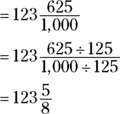
You can automatically rule out Choices (A) and (D) because you paid attention to detail (right?) when the question clearly told you to convert the answer into a fraction.
-
D. Both B and C
You can express this ratio in one of three ways:

Note that because the question asks for the ratio of ducks to geese, the elements of the ratio are expressed with ducks first. If the question had asked for the ratio of geese to ducks, you’d switch the order of elements in the ratio.
-
B.

To express the ratio as a fraction, you’d write:

Using what you know of fractions, simplify
 to
to  .
.Although Choices (A), (C), and (D) express the same ratio in different numbers, they’re incorrect because the question asks you to simplify the fraction. Many of the questions on the ASVAB require you to pay attention to detail, so make sure you read before you answer!
-
B. 36
One way to solve this problem is to use your scratch paper to scribble out a ratio table. Your ratio table should look like something this:

Based on your ratio table, you know that

Note that the ratio table shows you that
 . Write these ratios as fractions and set up a proportion, replacing the variable a with 60 — the value the problem gives you:
. Write these ratios as fractions and set up a proportion, replacing the variable a with 60 — the value the problem gives you: 
You don’t need to figure out the rest of the values. It would take up your valuable time, and you have only 20 minutes to answer 16 questions on the computerized ASVAB.
-
A. 27:38, 26:42
Order matters when you’re writing ratios. The first ratio is Group A, where the number of males is mentioned first. The correct ratio for Group A is
 .
.The second ratio represents Group B, in which females are mentioned first. You have to reverse the order to follow the directions. The ratio for Group B is
 .
. -
D. 90:120
You can automatically rule out Choice (A), because 7 feet, 6 inches is 7.5 feet, not 7.6 feet. Choice (B) is incorrect because the measurements aren’t in the same units; the height is in feet, whereas the length is in inches. Choice (C) is incorrect because 7 feet, 6 inches translates to 90 inches. That leaves only one possible correct answer, Choice (D).
-
C. 1,500
Based on the ratios you have, you can determine the value of x without worrying about the other variables. You know that

Cross-multiply:

Divide both sides by 7 to isolate x:

Note: You can also use mental math when solving ratio problems. Look at
 and consider the fraction on the right. Think, “What times 7 gives me 70?” The answer is 10, so to get x, multiply 150 (on the left) by 10 to get 1,500.
and consider the fraction on the right. Think, “What times 7 gives me 70?” The answer is 10, so to get x, multiply 150 (on the left) by 10 to get 1,500. -
A. 10 feet
One hundred centimeters equals 1 meter, so start by converting those (unless you know that 1 centimeter equals 0.0328084 feet; in that case, you’re all set to become a military astrophysicist). You can express the ratio this way, with x representing the number of unknown meters:

Cross-multiply:

Divide both sides by 100 to isolate x:

Now you’ll have to rely on your knowledge of feet versus meters (and it’s good to have, because the military measures everything in meters rather than feet).
One meter is approximately 3.28 feet, so for a tricky problem like this one, it’s best to round that number to 3.3. Before you convert 2.9785 meters into feet by multiplying, round that number up to 3:

Here’s another way: If you’re fortunate enough to remember that 2.54 centimeters equals 1 inch, use your rounding skills to make the problem easier.
Round 297.85 up to 300 and 2.54 down to 2.5; then divide 300 by 2.5:

Divide that answer by 12 (remember, there are 12 inches in a foot):

-
B. 1,280 cm
Because 1 meter equals 100 centimeters, you can do this problem the quick way (multiply 12.8 by 100, which equals 1,280) or the not-so-quick way, which looks like this:

Cross-multiply to find the value of x:

-
A.

A ratio is a statement that shows how two numbers compare. In this case, there are a total of 20 dogs. One of them has three legs. Therefore, one out of 20 dogs has three legs, which you can express as
 .
.(For the record, you can also express this ratio by writing
 or 1 to 20.)
or 1 to 20.) -
D. 0.43
It’s easiest to solve problems when you’re working with like terms. Convert
 into 0.2 so you’re not working with fractions.
into 0.2 so you’re not working with fractions.Write an equation to find x:

Cross-multiply:

Divide both sides of the equation to isolate x:

-
C.

Scientific notation is a simple way to deal with long numbers. The best way to find a number’s scientific notation is to put a decimal point after the first digit and count the number of places from the decimal point to the end of the number.
In this case, you put a decimal point after the 7 and before the three zeros: 7.000. Because there are three zeros to the right of your new decimal placement, the exponent needs to be 3.
-
A.

Because the original number is less than 1, you need to move the decimal point to the right in order to place it to the right of the first digit. You move the decimal point one place, making the exponent –1.
-
B.

You need to put a decimal point after the numeral 6, leaving six zeros following the decimal. You express 6,000,000 in scientific notation by writing
 .
. -
A.

Multiply the numeric parts of the problem:

Multiply the powers of ten by adding the exponents:

Write the answer as the product of the two numbers:

The first number isn’t between 1 and 10, which means you need to move the decimal point one place to the left and add 1 to the exponent to arrive at
 .
. -
D. 0.854345
The exponent is –3, which tells you that you need to move the decimal point three places to the left (a positive exponent tells you to move the decimal to the right).
-
C. 7
 is the number that gives n when it’s multiplied by itself. In this case, 7 multiplied by 7 is 49; that means the square root of 49 is 7 (or –7, because –7 multiplied by –7 is also 49).
is the number that gives n when it’s multiplied by itself. In this case, 7 multiplied by 7 is 49; that means the square root of 49 is 7 (or –7, because –7 multiplied by –7 is also 49). -
A.

To simplify, apply the exponent rule, which is
 :
: 
-
D. 15
First evaluate the expression inside the square root symbol by filling in the value of x:

Find
 by determining that
by determining that 
-
C.

Both radicals are cube roots, so multiply the radicands. Because
 , you get
, you get 
Factor and simplify, and look for perfect cubes to make it easier:

Rewrite the numbers and variables as the product of radicals so you continue to work with like terms:

Solve what you can and simplify:

-
B. 7
To solve this problem, you need to find the cube root of 343. You can express the problem this way:

If you’re not quite sure how to work out a problem but you can get the answer by trying out your options, give it a shot! For this question, you can ignore Choice (A) (just a glance tells you that
 is far greater than 343).
is far greater than 343). -
A. 3
Isolate a:

With simple algebra problems, plugging in the answer choices is often faster than working through all the math. (You’ll still want to understand the math, though, because you’ll find plenty of more complicated problems on the test.)
-
A. 4
Adding matrices only requires you to add corresponding elements. Look at the first number in the matrix on the left and then the first number in the center matrix (they’re 3 and 6, respectively);
 , which is the first number in the matrix on the right.
, which is the first number in the matrix on the right.To solve for x, express your equation as a simple addition problem, and then solve:

-
B. –35
Isolate x:

Check your work by inserting –35 in the original equation:

-
D. 12
Remember that
 , so you can simplify the problem before you isolate x:
, so you can simplify the problem before you isolate x: 
-
C.

Put all the variables on the same side of the equation by subtracting 11a from both sides:

Factor out a and divide both sides by
 :
: 
-
B. y = –3x + 6
The formula for slope-intercept form is
 , with m representing the slope and b representing the y-intercept. Isolate y:
, with m representing the slope and b representing the y-intercept. Isolate y: 
-
A. 5
Isolate x by dividing both sides by 17:

-
B.

When you’re searching for roots, the number above the radical is called the index. The problem asks you to find the fourth root of 239, which is expressed as
 . Next, insert the equals symbol, and express “log to the base of a” as
. Next, insert the equals symbol, and express “log to the base of a” as  . The value you want to find is the product of x and y, which refers to multiplication and belongs in parentheses beside the base. Therefore, your expression needs to look like this:
. The value you want to find is the product of x and y, which refers to multiplication and belongs in parentheses beside the base. Therefore, your expression needs to look like this: 
-
C. –9
Isolate x:
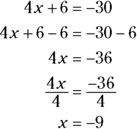
-
C. –14
Use the distributive property to simplify the equation:

Put the variables on the same side of the equation and solve:

-
A. 3
The goal with this type of problem — in which there’s a variable on both sides of the equation — is to put the variables on the same side. Start by using the addition property of equality, which tells you that adding the same number to each side of an equation gives you an equivalent equation.

Combine like terms:

Isolate x by dividing both sides by 3:

-
C. 8.5
Use the addition property of equality to put both variables on the same side. Then combine like terms and isolate x:
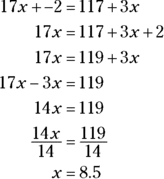
-
B. 6
Simplify both sides of the equation by distributing:

Subtract 134x from both sides, and then isolate x to solve:
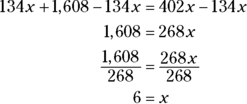
You don’t always have to work through all the math. If you’re not confident in your ability to do the calculations correctly, start plugging in answer choices until you hit the right one.
-
D. 9x14y10
To simplify expressions that contain exponents, raise everything in the parentheses by the exponent outside the parentheses. Technically, you’ll apply the exponent rule, which says
 . In this case,
. In this case, 
-
B. 4y5 + 9y4 + 7x3 – 2y2 – 8y + 32
Writing a polynomial in standard form requires you to organize the expression with the highest exponent first and subsequent exponents in descending order. Remember, the constant (the number with no variable) always goes last. The given expression is

Rank the terms in descending order by exponent:

-
D. 4x6 + 4x – 12
Simplify by adding like terms, including exponents:

Combine all the terms:

On the ASVAB, ruling out answers that are clearly wrong can pay off — especially if you have to resort to guessing. You can tell that Choice (C) is wrong because there are two like terms that aren’t combined: 16x and 4x. If you’re guessing, you now have 1 in 3 odds of getting the right answer.
-
A. 294
Because this equation has only a variable in the numerator a fraction, multiply both sides of the equation by 7:

-
D. y = x – 3
The formula for slope-intercept form is
 , so combine like terms and isolate y:
, so combine like terms and isolate y: 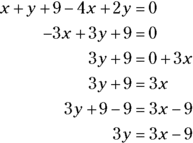
Simplify the equation by dividing each term by 3:

-
A.

Remember that
 and
and  , which translates to
, which translates to 
Subtract 9 from both sides of the first inequality, and then subtract 9 from both sides of the second inequality, solving both for c:

You can now combine the ranges to arrive at the answer:

-
A. (6x + 7x)(6x – 7y)
When you factor, keep in mind that
 .
.That tells you when you have squares, the roots of those squares (which are given in the problem) can be factored out. In this problem,

-
C. –23
Put the variables on the same side of the equation:

Isolate x by dividing both sides of the equation by –2:

-
C. (4x – 3y)(16x2 + 12xy + 9y2)
Factor using the algebraic property
 :
: 
The idea is to find the cube roots and then refine the expression:

Plug in 4x for all a’s and 3y for all b’s in the formula.
If you’re not sure how to factor cubed exponents, you may not want to spend much time trying to solve problems such as this one. (You have 20 minutes to answer 16 questions, so you can spend an average of just over a minute on each.)
-
A.

Multiply the fractions:

Factor the binomials:

Cancel out the common factors:

Finally, use the distributive property to multiply
 through the remaining binomial
through the remaining binomial  :
: 
-
C.

Solve the inequality by subtracting 6 from both sides; then reverse the inequality when you divide both sides by –4 to isolate x:

-
D.

Solve the inequality first:

To graph this inequality, draw a shaded circle at –1 and shade the line pointing to the left to show all numbers less than or equal to 1 on the number line.
-
C. –17
Reduce the fraction on the left:

Subtract 17 from both sides:

Multiply both sides by 2 to isolate x:

-
A. y = 4x – 4
Use slope-intercept form,
 , where m represents slope and b represents the y-intercept. You know that
, where m represents slope and b represents the y-intercept. You know that  ,
,  , and
, and  . Insert all the values you know and solve for b:
. Insert all the values you know and solve for b: 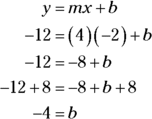
Now you know the values you need to create the line equation, so use
 :
: 
-
D.

Apply the exponent rule, which says
 . Multiply the exponents, beginning with the innermost parentheses:
. Multiply the exponents, beginning with the innermost parentheses: 
Move on to the outer exponent:

-
B. 110
Replace the variables with the given numbers and solve for c:

-
D. 6
Isolate the x term by subtracting 4 from both sides:

To isolate x, multiply both sides by
 , the multiplicative inverse of
, the multiplicative inverse of  (the number you can multiply your fraction by to get 1). Then simplify:
(the number you can multiply your fraction by to get 1). Then simplify: 
-
C.

Factor the numerator and denominator:

Cancel out all the factors you can to reduce the fraction to its lowest terms:

-
A. a + (b + c)
According to the associative property of addition,
 . It doesn’t matter which two factors you combine first, because you’ll get the same answer either way.
. It doesn’t matter which two factors you combine first, because you’ll get the same answer either way. -
A. 4y
Pay close attention to detail — this problem is asking you to solve for x. That means your answer can (and should) have the other variable (y) in it. Subtract 4x from both sides:

Because you need to solve for x, flip the equation (most people like the variable they’re solving for on the left) and divide both sides by 2:

-
C.

Simplify the equation:

Add 4x to both sides, and then subtract 7 from both sides. Divide both sides by 9 to isolate x:
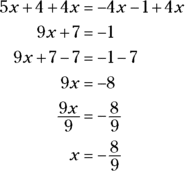
-
D. All of the above
Each answer is true if a and b are equal. The choices show the addition, subtraction, and multiplication properties of equality.
-
B. 3
Subtract 38 from both sides; then divide both sides by 475.5 to isolate a:

-
C. 3x2 + 30x + 63
Distribute the terms in parentheses using FOIL, or the formula
 :
: 
-
D.

Group the real and imaginary parts of the complex number, because
 . Then simplify:
. Then simplify: 
-
C. 1
Plug in the numbers you know and simplify:

-
B. 6 or –6
Evaluate the expressions in the parentheses first:

Find the square root:

-
B. 3
Combine like terms:

Divide both sides by 30 to isolate c:

-
B. 72x5 – x –2
Multiply the numbers 12 and 6, and then apply the exponent rule, which is
 (to multiply powers that have the same base, add their exponents):
(to multiply powers that have the same base, add their exponents): 
That’s as much as you can simplify.
-
D. 2
Multiply the binomials, remembering that i2 = -1:

-
B.

Simplify and apply the log rule that says
 :
: 
Rewrite the 4 in parentheses in power-base form:

Apply the log rule again and multiply the whole numbers:

-
A. x5
Remove the parentheses because
 . Apply the exponent rule, which says
. Apply the exponent rule, which says  :
: 
-
B. 2
Multiply both sides by x, and then multiply both sides by
 (the multiplicative inverse of
(the multiplicative inverse of  ):
): 
-
B.

The division property of equality says that if
 and
and  , then
, then  .
.Choice (A) can’t be right, because the problem tells you that
 . That means the value of a is the exact same value as b, so look at it this way: a times a divided by c would have to equal one-half of the value of c times a. The equation would look like this:
. That means the value of a is the exact same value as b, so look at it this way: a times a divided by c would have to equal one-half of the value of c times a. The equation would look like this: 
Let
 and
and  to find out what happens (remember, the question says
to find out what happens (remember, the question says  ):
): 
You know that
 doesn’t equal 1, so the equation doesn’t work. It’s impossible (and it makes Choice (C) wrong, too).
doesn’t equal 1, so the equation doesn’t work. It’s impossible (and it makes Choice (C) wrong, too).Be careful when you see ASVAB questions that deal in absolutes, such as Choice (D). Although sometimes they’ll be correct, nearly every problem you encounter on the ASVAB has a solution.
-
A. 9
Refine:

Add 2 to both sides and subtract 3x from both sides to isolate the x term:

Divide both sides by –1 (or just drop the negative sign):

-
B. x = 4 and y = 1
When you solve a system, it’s given that x is the same in both equations; so is y.
One approach is to isolate one variable in one equation by solving
 :
: 
Replace x in the first equation with
 :
: 
Because
 , you can substitute 1 for y in the original equation to find x:
, you can substitute 1 for y in the original equation to find x: 
-
B. 6
Simplify the equation:

Divide both sides by 1,204 to isolate y:

Instead of spending your time doing long division, try scratching off answers that most likely don’t make any sense — such as Choices (C) and (D), which would result in numbers far too great for this problem — and substituting your remaining answer choices for y.
-
B. 3
Rewrite 64 as a power of 4 and put it in the equation:

Flip the sides of the equation and apply the log power rule, which says
 . In other words, bring the 3 down and put it in front of the log:
. In other words, bring the 3 down and put it in front of the log: 
Apply the log rule that says
 — that is, replace
— that is, replace  with 1:
with 1: 
Another approach is to change the log to exponential form:

Rewrite 64 as a power with a base of 4:

The bases are the same, so the exponents must be equal. Therefore,
 .
. -
A.

First use the slope formula, which says
 for the points
for the points  and
and  :
: 
Find the y-intercept using slope-intercept form
 . You can use either set of points:
. You can use either set of points: 
Fill in the values of m and b in the slope-intercept form of an equation:

-
C. |a + bi| = |a + bi2|
Make sure you’re reading the questions thoroughly; this one asks you which answer is not true. Choice (C) is an incorrect statement because
 .
. -
D. 6b + 5
Multiply the factors in the expression:

Combine like terms:

-
B. y = 50x + 32
Use slope-intercept form, which says
 , where m is the slope and b represents the y-intercept, and insert the values you are given:
, where m is the slope and b represents the y-intercept, and insert the values you are given:  .
. -
C.

Simplify both sides and solve for x:
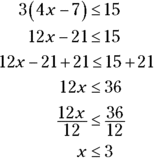
As shown on a graph,
 looks like this:
looks like this: 
-
A. 30
You already know what the variables are, so put them into the formula:
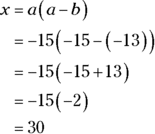
-
A. 58
Work with the numbers you know, filling in the values of a, b, and x:

-
B. {3, 0}
Because this problem deals with absolute value, you know that
 or
or  . Solve the first possibility for x:
. Solve the first possibility for x: 
Then solve the other possibility for x:
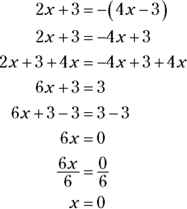
-
A. 2, 3, 5
A prime number is a whole number that’s greater than 1 and can be divided evenly only by 1 or itself.
Choice (B) is wrong because the number 9 can be divided evenly by 1, 3, and 9. Choice (C) is incorrect because the 4 is divisible by 1, 2, and 4, and 6 is divisible by 1, 2, 3, and 6. Choice (D) is incorrect because 6 is divisible by 1, 2, 3, and 6, while 9 is divisible by 1, 3, and 9.
-
D. 2
Isolate x by subtracting 6 from both sides of the equation and dividing both sides by 2:
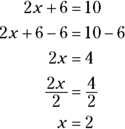
-
A. 10
The greatest common factor is the greatest number that divides evenly into a set of numbers. In this case, 10 is the greatest number that divides evenly into both 10 and 100.
-
D. 5
In some cases, choosing an answer and seeing whether it works is faster than working out the problem. If you want to solve this problem using algebra rather than the guess-and-check strategy, first get a p term by itself on one side of the equation. Then divide to find p.

-
B. –60
Substitute 3 for x in the equation:

-
B. –1
Isolate x:

-
C. 2
Combine like terms and isolate the variable:

-
D. All of the above
simplify the equation and isolate x to solve:

You don’t need to go any further than that. This equation is an identity because the numbers on both sides are identical. All real numbers are solutions.
-
A. 1
Apply the factorial rule,
 :
: 
Another way to use the factorial rule is to multiply n by the next lower number, then the next, and so on until you reach 1. In this case, n is 3: Multiply 3 by 2, and then multiply that number by 1 to reach 6.
-
C. x10
Remove the parentheses and combine the terms:

Apply the exponent rule, which says
 . Remember that each x that doesn’t have a written exponent actually has an exponent of 1:
. Remember that each x that doesn’t have a written exponent actually has an exponent of 1: 
-
A. 2
First evaluate the terms with exponents:

Replace those values in the equation, and then isolate x to solve:

-
B.

Apply the exponent rule, which says
 , and simplify:
, and simplify: 
Remember that
 , and apply that rule to
, and apply that rule to  ,
,  , and
, and  :
: 
Combine the variables to find the solution:

-
C.

Solve this simple inequality the same way you’d solve an equation with only one variable:

Don’t forget to simplify the fraction. Sometimes not seeing the answer you’ve arrived at in the choices can throw you off — but you can avoid reworking the problem if you make sure you’re thorough.
-
C. (–3, 4)
Solve this system by using the elimination method. Multiply each factor in the second equation by –1 and then add the equations:

The solution is
 , which you can solve normally:
, which you can solve normally: 
Put y into the simplest equation (although either equation will work) to solve for x:

Express your answer as
 . In this case, the answer is
. In this case, the answer is  .
. -
B. 8
Combine like terms before you solve:

-
A. 15x3 + x + 7
Combine all the like terms:

-
D. 14x17 + 3
Combine like terms to simplify:

-
A.

Substitute the numbers for the variables:

This equation doesn’t factor, so use the quadratic formula. For an equation of the form
 ,
,  :
: 
-
A. y = 4x – 2
The slope-intercept form for an equation of a line is
 , with m representing slope and b representing the y-intercept. Use the values given in the problem and solve for b:
, with m representing slope and b representing the y-intercept. Use the values given in the problem and solve for b: 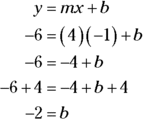
Because you know the value of b, you can write the equation for the line:

It always pays to save time on the ASVAB, so you can quickly rule out Choice (B) and Choice (D) because the slopes of those lines will be 6 or -6 when the problem tells you it needs to be 4.
-
B. y = 2x
You need to find the equation of a line without being given the slope. To find the slope, m, use the formula
 , where
, where  and
and  are the given points on the line:
are the given points on the line: 
Put the values you know into the equation
 , where m represents the slope and x and y are the coordinates of one of the given points. Then, solve for b:
, where m represents the slope and x and y are the coordinates of one of the given points. Then, solve for b: 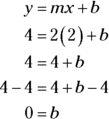
It doesn’t matter which set of points you choose; the answer will be the same:

You know all the values you need to create an equation in the form
 . Fill in the values of m and b:
. Fill in the values of m and b: 
-
D. (x – 2)(x – 3)
First, write out the two binomials with an x as the first term of each:

Next, insert negative signs in each binominal, because when there’s a positive sign in front of the constant term (here, 6), then the signs in the binomials have to match each other. The middle term in the given expression is negative, so the signs in the binomials must both be negative.

Then think of two numbers that multiply to get 6 but add to get 5. The only two numbers that work are 3 and 2:

Last, you can check your work by distributing (or using the FOIL method):

Because you have the original expression, you know you factored correctly.
-
B.

The easiest way to solve this problem is to notice the 1 on the right and recall that any number to the 0 power equals 1. Therefore, you can set the exponent on the left equal to 0 and solve for x:

If you don’t recall this property, you can take the natural log of both sides of the given equation. Then use
 to bring down the exponent on the left:
to bring down the exponent on the left: 
Because
 , you can write
, you can write 
Distribute and move one term to the right side:
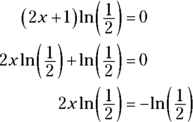
Divide both sides by
 and solve for x:
and solve for x: 
On the ASVAB, you may encounter questions that have “Both A and B” or “Neither A nor B” options. If you aren’t sure how to solve the problem, try to rule out one or more options using what you do know. It’s okay to guess on the ASVAB, but don’t let panic make you rush and guess on a series of questions you might be able to solve. (The CAT-ASVAB is designed to penalize you for mismanaging your time.)
-
A.

Solve by subtracting 35 from each side and isolating x:

You could write this as a mixed number, but it’s not necessary in this case because your answer appears among your choices. Don’t waste time on unnecessary steps.
-
A. 3(x – 2)
Find a common factor between the two terms; that’s a number that can be divided out of each term and moved up front. In this case, the greatest common factor is 3. Move the 3 to the front and divide 3x and –6 by 3:

-
D.

Combine like terms, and then isolate y:

-
A.

Use the logarithm rules to simplify this equation:

Now solve as usual:

If you have no idea how to solve a problem, it’s okay to guess. Some of the questions on the ASVAB are extremely difficult. When you answer a hard question correctly, the system will adjust and give you another difficult question to find out whether you had a lucky guess or you’re extremely talented in the math department.
-
B. 6
Set up your equation so you can isolate x:
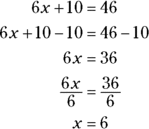
-
A.

You can automatically rule out Choices (B) and (C), because you know that this problem has two possible solutions. Absolute value simply refers to a number’s distance from 0 on the number line.
Solve this as you would any other equation by isolating x. The two equations you need to solve for are
 and
and  . Here’s the first version:
. Here’s the first version: 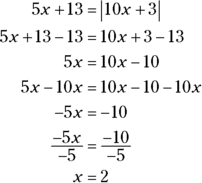
Solve for the other value:

-
D. x < 3
Solve each inequality separately. Here’s the first one:

And here’s the second:

Therefore,
 and
and  . Combine the ranges to arrive at the answer, which is
. Combine the ranges to arrive at the answer, which is  .
. -
B.

The square bracket indicates that the value of 3 is closed (you do include it in your interval). You always use a parenthesis with the infinity symbol, because the answer can never equal infinity.
-
A. 7
Combine like terms, and then isolate b:

-
D. 5
Isolate x:

-
B. 36
First solve for x:

Now that you know the value of x, find 6x:

Don’t let simple things trip you up on the test; make sure you read the whole question before settling on an answer.
-
B. x = y
Isolate the variable terms. Get all the x terms on one side of the equation and all the y terms on the other:

-
D.

The a terms are the same, and the problem involves only addition, so combine like terms:

-
C. 3
Isolate x:

If you can solve a problem just by looking at it, you don’t have to work through the math.
-
A. 2
Isolate x:

-
B. 3
Combine like terms and isolate c:
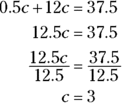
-
C.

Simplify:

-
C.

A coefficient is a number or symbol multiplied by a variable; the base (sometimes also called a radix) is a digit or letters that represent numbers. An exponent tells you how many times to multiply the number (the base) by itself.
-
A. 3
Substitute 2 for b in the equation, and then solve:
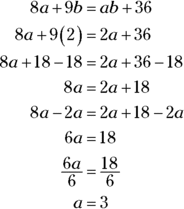
-
C.

Use inverse operations on both sides of the equation to solve:

-
B. 3x2 – 11x – 4 = 0
A quadratic equation has an x2 term. When the equation is in standard form, both sides equal 0. Put all the terms on the same side, set the other side equal to 0, and combine like terms:

-
D. x = 3, x = 5
Factoring is the simplest way to solve this quadratic equation, so factor
 to
to  , because at least one factor must always be equal to zero. Solve each set of terms:
, because at least one factor must always be equal to zero. Solve each set of terms:
The solutions are
 and
and  .
. -
B. x = –6, x = 9
Whether you solve this (or any) quadratic equation by factoring, completing the square, or using the quadratic formula, you’re going to get the same answers. That means when you encounter a question that tells you how to solve a problem, you don’t necessarily have to do it. You should do what’s easiest for you.
To solve for x by factoring, work out the problem this way:

Set each factor equal to 0 and solve:

The solutions are
 and
and  .
. -
A. x = 0, x = 3
A quadratic equation’s standard form is
 . Although this equation shows only two terms,
. Although this equation shows only two terms,  and
and  , it’s still quadratic because there’s an x2 term (you can assume
, it’s still quadratic because there’s an x2 term (you can assume  ).
).Solve this quadratic equation by factoring:

Set each factor equal to 0; then solve:

The solutions are
 and
and  .
. -
A.

Subtract
 from both sides of the equation:
from both sides of the equation:
Using the quadratic equation formula, which tells you that the solutions are
 , fill in what you know:
, fill in what you know: 
-
D. x = 3, x = 4
This quadratic equation is already factored for you. Because it’s already factored, use the zero factor principle to set the factors equal to 0:

Solve the equations as you normally would to determine that
 or
or  .
. -
A. x = –2, x = –3
Solve by factoring:

Use the zero factor principle to solve each set of terms. Set each factor equal to 0 and solve for x:

-
C.

Factor


Use the zero factor principle on the terms within the parentheses. Set each factor equal to 0 and solve for x:

The solutions are
 and
and  .
. -
D.

You can solve this problem by factoring, completing the square, or using the quadratic formula. The quadratic formula for equations in the form of
 looks like this:
looks like this: 
The variables you need are already in the problem:
 ,
,  , and
, and  . Enter these values into the quadratic formula and solve for x:
. Enter these values into the quadratic formula and solve for x:
Now find both values of x, adding 13 in one case and subtracting 13 in the other:

-
B. right angle.
The box at the intersection denotes that you’re dealing with a right angle. Parallel lines run in the same direction at the same angles, but they never intersect. Transversal lines are those that pass through two lines in the same plane at two distinct points. Complementary angles are two angles that have a sum of 90°.
-
B. 36 cm
Use the Pythagorean theorem, which says
 , to find the length of the third side:
, to find the length of the third side: 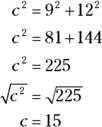
The length of side c is 15 centimeters, so add that to the other two sides to find the perimeter:

The triangle’s perimeter is 36 centimeters.
-
D.

Complementary angles add up to 90°, so two angles that meet at a corner of a rectangle are complementary. Line DB, which you can express as
 , divides the rectangle; you know that the angles that form
, divides the rectangle; you know that the angles that form  are complementary, as are the angles that form
are complementary, as are the angles that form  .
.To express which angles are complementary, write the points with the vertex (the actual location of the angle) in the middle:
 and
and  are one set of complementary angles (and this pair of angles is listed in the choices). Another pair of complementary angles,
are one set of complementary angles (and this pair of angles is listed in the choices). Another pair of complementary angles,  and
and  , isn’t listed.
, isn’t listed. -
D. 56.25 m2
Use the formula to find the area of a trapezoid to solve:
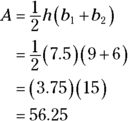
-
C. complementary
You’re dealing with a right angle, which is always 90°. Two angles that add up to 90° must be complementary.
-
D. equilateral
A polygon in which all the sides are the same length is equilateral.
-
A. 72 sq. ft
The formula for the area of a rectangle is
 , with A representing area, l representing length, and w representing width. Remember that area is measured in square feet.
, with A representing area, l representing length, and w representing width. Remember that area is measured in square feet. 
-
D. V = s3
The formula for the volume of a cube is
 , where s is the length of a side or edge. If you aren’t sure about the answer to a geometry question on the ASVAB, rule out obvious no-go answers (that’s a little more military terminology for you).
, where s is the length of a side or edge. If you aren’t sure about the answer to a geometry question on the ASVAB, rule out obvious no-go answers (that’s a little more military terminology for you).In this case,
 will find you the volume of a sphere,
will find you the volume of a sphere,  leads you to the surface area of a cube, and
leads you to the surface area of a cube, and  is the formula for the area of a circle. If you knew even one of those, you’d increase your chances of getting the answer right on the real test.
is the formula for the area of a circle. If you knew even one of those, you’d increase your chances of getting the answer right on the real test. -
C. a2 + b2 = c2
The Pythagorean theorem says that
 , where a and b are legs of a right triangle and c is the hypotenuse. Typically, you use this theorem to find an unknown length of the side of a right triangle.
, where a and b are legs of a right triangle and c is the hypotenuse. Typically, you use this theorem to find an unknown length of the side of a right triangle. -
B. 12 cm
Use the Pythagorean theorem, which says
 , where a and b are legs of a right triangle and c is the hypotenuse:
, where a and b are legs of a right triangle and c is the hypotenuse: 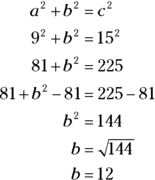
-
D. 50°
L1 and L2 are parallel and are cut by the transversal L3. Therefore, all the large angles you see are congruent to each other, and all the small angles you see are congruent to each other.
Angles that form a straight line form a linear pair and must add up to 180° (they’re supplementary). One large angle is 130°. That means its supplement, which corresponds to angle x, must be 50°.
-
D. 50.6 ft2
To find the area of a sector of a circle, use the formula
 , with n representing the central angle. You’re essentially multiplying the area of the full circle
, with n representing the central angle. You’re essentially multiplying the area of the full circle  by the fraction of the circle covered by the sector
by the fraction of the circle covered by the sector  :
: 
Multiply and then simplify the fraction:

Pi is approximately 3.14, so fill in that value and solve:

-
B. 25 sq. in.
The formula for finding the area of a square is
 , with A representing area and s representing the length of a side. In a square, all the sides are the same length — and although this figure is missing some labels (and one is even labeled with a variable), the problem tells you it’s a square.
, with A representing area and s representing the length of a side. In a square, all the sides are the same length — and although this figure is missing some labels (and one is even labeled with a variable), the problem tells you it’s a square.In this case, the area is

-
C. 26°
A straight line (which you know you have because you’re looking at a right triangle) has a straight angle of 180°. Therefore, you know that
 . Solve for x:
. Solve for x: 
-
D. 130°
Angles around a point always add up to 360°. The diagram shows the measurements of all the angles except b, so you can solve this problem in a couple of ways. You can use algebra:

You can also subtract the angles you know from 360 to find what’s left over, which is b:

-
A. 16 ft
The formula for perimeter of a square is
 , with P representing perimeter and s representing the length of a side. In this case,
, with P representing perimeter and s representing the length of a side. In this case, 
-
D. 96 square yards
The formula to find the surface area of a prism is
 , where B represents the area of the base, P represents the perimeter of the base, and h represents the height of the prism.
, where B represents the area of the base, P represents the perimeter of the base, and h represents the height of the prism.First find the area of the triangular base using
 , where b represents the triangle’s base and h represents its height:
, where b represents the triangle’s base and h represents its height: 
Find its perimeter by adding the length of each leg:

The base’s area is 24 square yards, the base’s perimeter is 24 yards, and the prism’s height is 2 yards, so plug that information into the formula for the surface area of a prism:

The surface area of the prism is 96 square yards.
-
B. 16°
The sum of all angles in a triangle is 180°, so fill in the values you know using
 and let x represent the angle you don’t know (note that angle A is a right angle, so it’s 90°):
and let x represent the angle you don’t know (note that angle A is a right angle, so it’s 90°): 
-
A. It has only one dimension.
A line has only one dimension, and that’s length. It has no width, and it continues forever in two directions (it’s infinite). Lines don’t stop at points, or they become line segments; they carry on forever (much like a ruck march during basic training seems to do).
-
A. 1,050 ft2
The formula for finding the area of a rectangle is
 , with l representing length and w representing width. You have two rectangles here, so find the area of each and add them together.
, with l representing length and w representing width. You have two rectangles here, so find the area of each and add them together.Rectangle 1:

Rectangle 2:

The area of Rectangle 1 plus the area of Rectangle 2 equals 1,050 square feet.
Area is measured in square feet, so the answer is 1,050 square feet; you can also express it as 1,050 sq. ft and 1,050 ft2.
-
D. 146 ft
To find the perimeter, find the sum of the length of each side:

You know that side a is 27 feet, side b is 30 feet (and so is side c), sides d and e are each 16 feet, and side f is 15 feet. Sides g and h are unknown, but because side a is 27 feet and side f is 15 feet, you can deduce that, together, they measure 12 feet.
Add everything you know:

Another approach is to imagine shifting the lines to make a rectangle. In this figure, the rectangle’s width is 27 feet, and its length is
 feet:
feet:
Add the lengths of each side to find the perimeter, and you get the same answer:

-
C. 1,050 mm2
Before you can determine the area of this polygon, you need to know its perimeter. That’s because the formula for the area of a regular polygon is
 , with a representing the apothem and p representing the perimeter. Because all sides are equal, you can simply add the lengths of the sides or multiply the length by the number of sides to get the perimeter:
, with a representing the apothem and p representing the perimeter. Because all sides are equal, you can simply add the lengths of the sides or multiply the length by the number of sides to get the perimeter:
Now use what you know in the area formula:
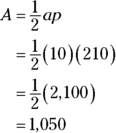
-
A. 10
The triangle has two congruent sides (that’s what the hash marks represent). That means the two sides are equal. Set their values equal to each other and solve for x:

-
B. 60°
In a triangle, the three interior angles always add up to 180°. Because the figure shows you that two of the angles measure 60°, the remaining angle must also equal 60° so the angles add up to 180°.
This problem is even simpler than that, though. The triangle has three congruent sides, which means the corresponding angles are congruent as well.
-
A. 35°
Two of the angles are included in the figure. Let x represent the measure of angle C:

All the angles inside a triangle must add up to 180°, so write an equation and solve it:

-
B. x = 35°, y = 95°, z = 50°
Supplementary angles together make a straight angle with a measurement of 180°. Find the missing measurements:

The interior angles of a triangle always equal 180°, so find z next using
 and
and  :
: 
-
A. 72°
A straight line or segment has a straight angle — one that equals 180°. That means the sum of angle y and the angles labeled in the figure must equal 180°:

-
A.

Write the label using the three letters on the shape that define the angle, with the letter of the vertex (where the angle actually is) in the middle.
You could also label this angle
 or
or  if you wanted to, but they aren’t answer choices.
if you wanted to, but they aren’t answer choices. -
C. Acute
The angle is acute because it measures less than 90°. Remember:
- Acute angles measure less than 90°.
- Right angles measure exactly 90°.
- Obtuse angles measure more than 90° but less than 180°.
- Straight angles measure exactly 180°.
-
D. 75 ft
The formula for the perimeter of a rectangle is
 (or
(or  ), with P representing perimeter, l representing length, and w representing width. In this case:
), with P representing perimeter, l representing length, and w representing width. In this case: 
-
A. 70°
The interior angles of a triangle always add up to 180°, so you know that the missing angle in
 must be x in
must be x in  :
: 
The missing angle, x, is 48°. Because the angles are marked as congruent (that’s what the hash mark is for at angle x), you know that
 is 48°. Also, the angles are vertical angles, which are always congruent.
is 48°. Also, the angles are vertical angles, which are always congruent.Run through the math again now that you know two angles in
 , remembering that all the angles in a triangle add up to 180°:
, remembering that all the angles in a triangle add up to 180°: 
-
B. 230°
The reflex angle (the one that measures more than 180°) must combine with the obtuse angle in this figure to make a full circle, which measures 360°. Let x represent the measure of the angle you don’t know. Then you can express the problem as an equation:

-
C.

The interior angles of a triangle always add up to 180°, and two angles that add up to 90° are complementary. The figure depicts a right triangle, so you know that the remaining two angles (aside from the right angle, which is marked) must add up to 90°. Therefore, angles A and C are complementary.
-
A. 165 sq. in.
The formula to find the area of a triangle is
 , with b representing the length of the base and h representing the height. Given what you know, replace the variables and solve:
, with b representing the length of the base and h representing the height. Given what you know, replace the variables and solve: 
-
B. 324 m2
Don’t get tangled up in extra information on the ASVAB. You don’t need to know the lengths of the sides to find the answer to this problem; you only need the base and the height, which are 36 meters and 18 meters, respectively.
The formula for the area of a triangle is
 or
or  , so use what you know to solve the problem:
, so use what you know to solve the problem: 
-
D.

The formula to solve for the radius of a circle is
 , with C representing the circle’s circumference (the distance around the outside of a circle). If you don’t have this formula memorized, you can start with the circumference formula and solve for r:
, with C representing the circle’s circumference (the distance around the outside of a circle). If you don’t have this formula memorized, you can start with the circumference formula and solve for r: 
-
A. 28.26 in.2
The formula for the area of a circle is
 , and you know that the circle’s radius is 3 inches. Work out the solution, noting that pi is approximately 3.14:
, and you know that the circle’s radius is 3 inches. Work out the solution, noting that pi is approximately 3.14: 
-
B.

The formula for the area of a circle is
 , so create your own equation using the information you already have:
, so create your own equation using the information you already have: 
-
A. P = 2(l + w)
In the formula
 , l represents length and w represents width. You can also express the formula as
, l represents length and w represents width. You can also express the formula as  .
.The other answer choices refer to different shapes:
 is the formula for finding the perimeter of a triangle.
is the formula for finding the perimeter of a triangle. is the formula for finding the perimeter of a parallelogram.
is the formula for finding the perimeter of a parallelogram. is the formula for the perimeter of a trapezoid.
is the formula for the perimeter of a trapezoid.
-
B. 78.5 in.2
The formula to find the area of a circle is
 . The radius is half the diameter. According to the figure, the diameter is 10 inches; half of that is 5 inches. Pi is approximately equal to 3.14. Put the values you know into the formula:
. The radius is half the diameter. According to the figure, the diameter is 10 inches; half of that is 5 inches. Pi is approximately equal to 3.14. Put the values you know into the formula: 
-
A. 79 cm
The formula to solve for diameter is
 . To find the radius when you know the diameter, divide the diameter by 2:
. To find the radius when you know the diameter, divide the diameter by 2: 
-
D. 62.8 meters
To find the circumference of a circle, you need to know the radius. In this instance, it’s 10 meters.
The formula for circumference is
 , with r representing the radius. Pi is approximately equal to 3.14. Put what you know into the formula and solve:
, with r representing the radius. Pi is approximately equal to 3.14. Put what you know into the formula and solve: 
-
B. 49 cm
To find the perimeter of an irregular shape (this is actually three rectangles), add the lengths of all its sides:

-
C.

First, notice that the answer choices are in terms of pi. That means you won’t have to multiply by 3.14.
The formula to find the circumference of a circle is
 . Because you know the diameter is 210 feet, the radius is 105 feet. Use what you know in the formula:
. Because you know the diameter is 210 feet, the radius is 105 feet. Use what you know in the formula:
You can solve the problem more quickly using an alternate formula for the circumference,
 , where d is the diameter. Mentally insert
, where d is the diameter. Mentally insert  in for d, and you get
in for d, and you get  .
. -
A.

The answers are in terms of pi, so you won’t need to divide by 3.14.
Use the formula for area,
 , to determine the radius:
, to determine the radius:
Remember that for
 the solutions are
the solutions are  and
and  . Because you can’t have a negative radius, disregard
. Because you can’t have a negative radius, disregard  . That means
. That means  .
. -
A. 17.4 m
All the sides in the hexagon are equal in length, so to find the perimeter, multiply the length of one side by 6 (the number of sides in a hexagon). The formula and the solution look like this:

-
C. 27 cubic inches
The formula for volume in a cube is
 with s representing the length of an edge. You know that the length of s is 3 inches. Put what you know into the formula:
with s representing the length of an edge. You know that the length of s is 3 inches. Put what you know into the formula: 
-
D. 240 cm2
Find the area of a parallelogram by using
 , with b representing the base and h representing the height:
, with b representing the base and h representing the height: 
-
A. 3,375 cubic feet
Use the cube volume formula, which is
 , to solve this problem:
, to solve this problem: 
-
B. 500 cm3
The formula for the volume of a pyramid is
 , where B is the area of the pyramid’s base and h is the pyramid’s height. You’re dealing with a right square pyramid, so the base is a square. Because a square has an area of
, where B is the area of the pyramid’s base and h is the pyramid’s height. You’re dealing with a right square pyramid, so the base is a square. Because a square has an area of  (where s is the length of one side of the base), you can write the formula as
(where s is the length of one side of the base), you can write the formula as  . Replace the variables with the numbers you know:
. Replace the variables with the numbers you know: 
-
A. 960 mm3
The formula for volume of a right rectangular prism is
 , with l representing length, w representing width, and h representing height:
, with l representing length, w representing width, and h representing height: 
-
B. Scalene
A triangle with no equal angles and no equal sides is a scalene triangle.
-
C. 360°.
The interior angles of a quadrilateral always add up to 360°, whether you’re dealing with a square, a rhombus, a rectangle, a trapezoid, or another quadrilateral.
-
B. 216 cubic feet
To find the volume of a cube, use the formula
 , with s representing the length of a side:
, with s representing the length of a side:
Note that you can express units of volume with an exponent or by using the term cubic. In this case, you can use 216 ft3 or 216 cubic feet.
-
B. 7,850 cm3
This multi-step problem gives you all the information you need. Because the formula to find the volume of a cylinder is
 , with B representing the area of the base and h representing height, you need to find the area of the base of the cylinder to solve it. However, because the base is a circle and you know the radius is 10 cm, you can find the base area using
, with B representing the area of the base and h representing height, you need to find the area of the base of the cylinder to solve it. However, because the base is a circle and you know the radius is 10 cm, you can find the base area using  (note that pi is approximately 3.14):
(note that pi is approximately 3.14):
Now that you know the area of the base, use the formula for the volume of a cylinder:

-
C.

To find the circumference of (the distance around) a circle, use the formula
 , with r representing the circle’s radius. Note: Because the diameter is twice the radius, another version of the formula is
, with r representing the circle’s radius. Note: Because the diameter is twice the radius, another version of the formula is  .
. -
A. 18.84 meters
The formula for the circumference of a circle is
 . The radius in the figure is 3 meters, so plug in what you know. You can use 3.14 as an approximation of pi:
. The radius in the figure is 3 meters, so plug in what you know. You can use 3.14 as an approximation of pi: 
-
A. 4,069.44 ft3
The formula for the volume of a right circular cone is
 . First replace the B with the formula for the area of circle because a cone has a circle for its base:
. First replace the B with the formula for the area of circle because a cone has a circle for its base:
Next, replace the variables with the measurements in the diagram:
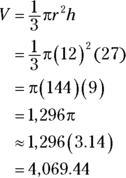
-
D. 3,750 cubic inches
To find the volume of a pyramid, you need to know the height and the area of the base. Use the values on the diagram to find the area of the base:

Now that you have the area of the base, use the formula for the volume of a square pyramid, which is
 , with B representing the area of the base and h representing the height of the pyramid:
, with B representing the area of the base and h representing the height of the pyramid: 
-
B. 24 units
To find the diameter of this circle, work backward. The formula to find the area of a circle is
 , so put the information you know in the equation:
, so put the information you know in the equation: 
Cancel out what you can and then solve:

You know the radius, and the diameter is two times the radius:

-
A.

The formula for the area of a triangle is
 . The problem gives you only one leg and the hypotenuse, though, so you need to use the Pythagorean theorem
. The problem gives you only one leg and the hypotenuse, though, so you need to use the Pythagorean theorem  to figure out how long the base is. If it helps, look at it this way:
to figure out how long the base is. If it helps, look at it this way: 
Substitute the values you know to determine the base:

Now you can find the area:

-
B. Quadrilateral
A quadrilateral is a four-sided polygon with four angles. Some of the most common quadrilaterals are parallelograms, rectangles, squares, and trapezoids.
-
A. Lines a and c
Parallel lines are lines in a plane that don’t meet; they never intersect or touch each other.
-
D. 16 in.2
Attention to detail is important on the ASVAB. Notice that the question asks only for the area of the shaded region, which is a rectangle. You can immediately discount the answer choices that involve pi and cube roots, because they definitely don’t have anything to do with the area of a rectangle.
You can find the area with
 , where w represents width and l represents length:
, where w represents width and l represents length: 
-
B. 1,000 cm2
The formula to find the area of a parallelogram is
 , with b representing the length of the base and h representing the height. Replace the variables with what you know:
, with b representing the length of the base and h representing the height. Replace the variables with what you know: 
-
B. 45°
In a parallelogram, opposite angles are congruent. Angle d is 45° because it’s opposite the 45° angle in the diagram. Angle c is 115° because it’s opposite the 115° angle in the diagram.
-
D. reflex angle.
A reflex angle is one that’s greater than 180°. An acute angle is one that’s less than 90°, a straight angle is a straight line that measures exactly 180°, and an obtuse angle is one that’s greater than 90° but less than 180°.
-
B. (2, 4), (7, 7)
When you’re reading a graph, the x-coordinate is always expressed first in an ordered pair
 . The x-coordinate is where the point lies on the x-axis, and the y-coordinate is where the point lies on the y-axis.
. The x-coordinate is where the point lies on the x-axis, and the y-coordinate is where the point lies on the y-axis. -
A. 90°
There are 360° in a circle, so this becomes an algebra problem as soon as you identify the angle you need to calculate.


-
D. 22.5 in.2
The formula for finding the area of a kite is
 , with p representing the shortest diagonal of the kite and q representing the longest diagonal. Remember, though, that they’re interchangeable. Input the values you know:
, with p representing the shortest diagonal of the kite and q representing the longest diagonal. Remember, though, that they’re interchangeable. Input the values you know: 
-
C. 43.2°
The angles in a circle add up to 360°, so when you identify the percent of the region you need to work with, you can use algebra to find the angle. Here, you need 12% of 360°:

-
A. 67 m
It doesn’t matter what irregular shape you’re dealing with when you find perimeter. You simply add the lengths of the sides:

-
D. 78 m2
One approach is to divide the figure into three rectangles and then add the areas together to find the total area.

Use the formula
 , with l representing length and w representing width, to find the area of each rectangle. The first rectangle is 6 m by 9 m:
, with l representing length and w representing width, to find the area of each rectangle. The first rectangle is 6 m by 9 m: 
The second rectangle is 3 m by 2 m (which is
 ):
): 
And the third rectangle is 2 m by 9 m:

Add the areas to get the total:

Another option is to calculate the area as if you were dealing with just one, whole rectangle and then subtract the missing part:

The whole area is

The area of the missing rectangle is

Subtract:

-
C. 45°
Ignore line z; it’s only there to distract you.
Vertical angles are always congruent, so you know that
 and
and  .
.Further proof is that line x is a straight line, and every straight line has a straight angle — it’s 180°. Any line that crosses line x will have angles that add up to 180°. Because one angle on line x measures 135°, the other angle must measure 45°.
-
D. Both A and B
When two lines are parallel and another line intersects them, the angles created on the intersecting line are equal to each other on both lines; here, the acute angles are all congruent to each other, and the obtuse angles are all congruent to each other. Another way to say this: Two lines cut by transversal create congruent corresponding angles.
-
D. 81.96 m2
Find the area of the rectangle by using the formula
 , with l representing length and w representing width:
, with l representing length and w representing width:
The units on the figure are in centimeters, but the answers are presented in square meters, so remember that 100 cm is equal to 1 m. A square meter equals 100 cm × 100 cm = 10,000 cm2, so you need to divide by 10,000; therefore, the answer is 81.96 m2. Attention to detail is incredibly important on the ASVAB.
-
D. congruent and obtuse.
The angles have the same measurement (110°), so they’re definitely congruent. Their measurement of 110° makes them obtuse as well. An obtuse angle is one that measures between 90° and 180°.
-
A. Right
When you see a half-box tucked into an angle, you know it’s a right angle. A right angle’s measurement is always 90°.
An acute angle is one that measures less than 90°, a straight angle measures exactly 180° (it’s a straight line), and a reflex angle measures more than 180° but less than 360°.
-
C. 2,826 cm2
The formula to find the surface area of a square is
 , so use the values you know to solve the problem:
, so use the values you know to solve the problem: 
-
B. c, d, e, h
When two parallel lines are crossed by a transversal (a third line), the angles between the parallel lines are considered interior angles. The angles created outside the parallel lines are exterior angles.
-
C. 137°
There’s a straight line running through the circle (you can tell because the two angles below the line are complementary — together, they add up to 180°), and the measurement of angles on a straight line must equal 180°. One angle on that line measures 43°, so subtract 43 from 180 to find the measurement of angle x:

-
D. 864 in.3
The volume formula for a rectangular prism is
 , with w representing width, h representing height, and l representing length:
, with w representing width, h representing height, and l representing length: 
-
B. 108°
The interior angles of a pentagon add up to 540°, but you don’t need to know this to solve this problem. All you need to know is that the sides are of equal length; because of that, all the angles are equal.
-
B. 678.24 m2
The formula to find the surface area of a right cylinder is
 — that is, the circumference of a base times the height, plus the areas of the two circular bases. Put in the values you know:
— that is, the circumference of a base times the height, plus the areas of the two circular bases. Put in the values you know: 
-
D. 180°
All the interior angles in a triangle add up to 180°.
-
B. 120°
All the sides in
 are congruent, so you know it’s an equilateral triangle and that all the angles are equal. Each angle must be 60°.
are congruent, so you know it’s an equilateral triangle and that all the angles are equal. Each angle must be 60°.You know that
 creates a straight angle measuring 180°. Because the angles in
creates a straight angle measuring 180°. Because the angles in  all equal 60°,
all equal 60°,  is 60°. To find
is 60°. To find  , subtract 60° from 180°:
, subtract 60° from 180°: 
-
A. Isosceles
An isosceles triangle has two congruent sides (sides that are the same length) and two congruent angles (angles that have the same measurement).
An obtuse triangle has one angle that measures more than 90°, a right triangle has one angle that measures exactly 90°, and in an equilateral triangle, each angle has a measure of exactly 60°.
-
D. 25°
The lines are parallel, which means they must be straight. A straight line has an angle of 180°, so subtract 155 from 180 to find the measurement for angle a:

-
C. 13 cm
Use the Pythagorean theorem to find the hypotenuse, c, of the triangle:

-
B. 289 in.2
The base of the right square pyramid has 17-inch sides, and the formula for the area of a square is
 , with s representing the length of one side.
, with s representing the length of one side.
Don’t worry about the height of the pyramid; you don’t need it to find the area of the base. (You’ll find many problems with distracting elements on the ASVAB, so just make sure you read the question thoroughly and understand what it’s asking before you dive into the work.)
-
D. 50°
Because this is a parallelogram, angles C and Z are supplementary and their angles add up to 180°. That means angle C must be 50°.
-
D. 60 ft2
The easiest way to find the area of a kite is to use the formula
 , with p representing one diagonal and q representing the other:
, with p representing one diagonal and q representing the other: 
If you have a tough time remembering all the formulas you need, use the standard method for finding the area of all irregular quadrilaterals: Divide it into triangles, find each triangle’s area, and add them all together. In this case, you can break the quadrilateral into two triangles:

Find the area of one triangle using the formula
 . Because the sides are the same length on each triangle, you only need to calculate one. Here’s the area of
. Because the sides are the same length on each triangle, you only need to calculate one. Here’s the area of  , which has a base of 10 (CO) and a height of 6 (half of MB):
, which has a base of 10 (CO) and a height of 6 (half of MB):
Don’t forget to double the answer so you have the area for the entire quadrilateral (you’re adding the areas of
 and
and  ). Your answer is 60 square feet.
). Your answer is 60 square feet. -
C. 75 ft2
First find the area of the entire square; then find the area of the unshaded region. Large square:

Small square:

Subtract the area of the unshaded region from the area of the shaded region:

The area of the shaded region (what’s left over after you remove the unshaded region) is 75 ft2.
-
D. 15.7 cm
A right triangle with points on the edges of a circle has a hypotenuse that equals the circle’s diameter. To find the diameter, find the length of the hypotenuse by using the Pythagorean theorem, where c represents the hypotenuse:

You know that the hypotenuse is 5 cm, so that tells you the circle’s diameter is also 5 cm. The radius is half that (2.5 cm). Now you can use the formula for finding a circle’s circumference, which is
 :
: 
-
A. 45°
All the angles in a triangle must add up to 180°. One is labeled 45°, and another is a right angle (and right angles always measure 90°). Subtract 45 and 90 from 180 to find the measure of angle A:

Angle A measures 45°.
-
B. 96°
In a cyclic quadrilateral — a quadrilateral inside a circle (which has 360°) — opposite angles add up to 180°. To find the measure of angle T, subtract 84 from 180:

Angle T is 96°.
-
A. 9 in.2
To find the area of a square, use
 , with s representing the length of the side:
, with s representing the length of the side: 
-
C. 45°
Count the portions of the circle: There are eight. Every circle has 360°, so to find the arcs over each portion, divide 360 by 8:

-
B. 28.5°
The two secants intersect outside a circle, so you can find the angle by using the formula
 , with
, with  representing x, the angle formed where the secants intersect (C is the vertex);
representing x, the angle formed where the secants intersect (C is the vertex);  representing the arc at the opposite end of the vertex; and
representing the arc at the opposite end of the vertex; and  representing the inner arc.
representing the inner arc.When you label the points, it looks like this:

Replace the variables with what you know to solve:

-
A. 143.75 in.2
The formula to find the area of a trapezoid is
 , with b1 representing one base, b2 representing the other, and h representing the height. Replace the variables with what you know:
, with b1 representing one base, b2 representing the other, and h representing the height. Replace the variables with what you know: 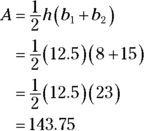
Arithmetic Reasoning
-
A. 5 yards
Let x represent the team’s progress and create an equation:

Note that it doesn’t matter which line the team was on when they lost 10 yards or when they gained 15, because the problem isn’t asking you which line they ended up on; it’s asking you about their progress.
Solve the equation:

-
C. $4.95
Remember that Cheryl bought herself a latte, too, so you need to figure out the price of 11 lattes before you determine how much she saved.
Let x equal the total original price of the lattes:

Find out how much Cheryl saved with a 10% discount by multiplying $49.50 by 0.10; let y represent the discount:

Attention to detail is important on the ASVAB. Don’t miss key words in the problem that can tip you off to the correct answer. In this case, the word save could’ve helped you rule out Choices (B) and (D).
-
D. Christina: 12; Angela: 18
Angela is 6 years older than Christina, so if you let x equal Christina’s age now, Angela’s current age is
 . Christina’s age 6 years ago would be
. Christina’s age 6 years ago would be
 , and Angela’s age 6 years ago would be
, and Angela’s age 6 years ago would be
 .
.Set up an equation showing that Angela’s age was double Christina’s age 6 years ago; then solve for x to get Christina’s current age:
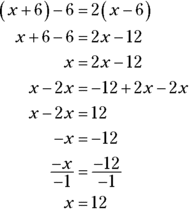
Christina is 12 years old now, and because Angela is 6 years older than Christina is, she’s 18.
-
D. $32.50
Let x represent the toy’s original price and write an equation to figure out how much the toy would’ve cost a civilian:

In this problem, you can skip the algebra and add $15 to $17.50 to find out how much the toy originally cost, but it’s a good idea to know how to perform the calculations; not all the questions you’ll encounter on the ASVAB will be easy enough to answer this way.
-
D. $5,775
You can solve this simple percentage problem with multiplication. Let x equal Perry’s profit and find 3% of the home’s price by multiplying the price by 0.03:

-
A. 2 dimes, 5 nickels, and 20 pennies
The best way to solve this problem is to create a simple chart, with one column showing the number of each coin and another column showing the monetary value. Don’t worry — you’re allowed to use as much scratch paper as you need when you take the ASVAB. Let x represent the number of dimes Kim has, and let
 represent the number of nickels she has. Finally, let
represent the number of nickels she has. Finally, let
 equal the number of pennies she has. Your chart should look something like this:
equal the number of pennies she has. Your chart should look something like this: 
Kim has a total of 65 cents, so add the values in cents and set that equal to 65. Now you can solve for x, the number of dimes:

Now that you know
 , you can determine that Kim has 2 dimes, 5 nickels, and 16 pennies in her pocket. Check your math by adding up the monetary value of her coins:
, you can determine that Kim has 2 dimes, 5 nickels, and 16 pennies in her pocket. Check your math by adding up the monetary value of her coins: 
-
A. –14
Write an algebraic equation to express the problem, and let x equal the number you don’t know:

-
B. 18 dimes, 3 quarters
Let x represent the number of quarters, and let 6x represent the number of dimes, because she has 6 times as many dimes.
Together, all the quarters are worth 25x cents, and all the dimes are worth 60x cents (remember that she has 6 times as many dimes in her piggy bank and that each dime is worth 10 cents).
To make the problem easier, deal only in cents. Therefore, she has 255 cents in her piggy bank. Create your equation based on what you know:
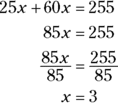
Now that you know
 , you know Amy has 3 quarters. She has a total of 21 coins in the bank, so the remaining coins must all be dimes:
, you know Amy has 3 quarters. She has a total of 21 coins in the bank, so the remaining coins must all be dimes: 
In this problem, you can deal only in the number of coins. Use the equation
 and let x represent the number of quarters in Amy’s piggy bank (she has six times as many dimes as she has quarters, and she has 21 coins). Solve the equation:
and let x represent the number of quarters in Amy’s piggy bank (she has six times as many dimes as she has quarters, and she has 21 coins). Solve the equation: 
Either way you calculate it, Amy has three quarters. The rest are dimes.
-
B. 46
Let x represent the number, and remember that is translates to an equals sign in an equation:
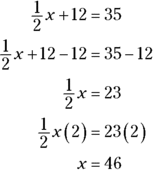
-
A. 8 hours
As with most time, rate, and distance problems, it’s often best to create a table to visualize your equations. Let x equal the time, in hours, for Danielle’s vehicle. Danielle has a 1-hour head start on Abigail, so Abigail’s time is
 . The distance formula says that
. The distance formula says that
 , so multiply the rate by the time to fill in the distance column. Your table should look something like this:
, so multiply the rate by the time to fill in the distance column. Your table should look something like this: 
When the cars are side-by-side, they’ll have traveled the same distance. You can create your equation by setting the distance values equal to each other:

The women’s cars will be at the same point on the expressway in 8 hours after Danielle left.
-
C. 2 nickels, 10 dimes
Let x equal the number of nickels Matthew has, and let y equal the number of dimes. There are a total of 12 coins, so the number of dimes is
 . Multiply the number of each coin by its worth (5 or 10 cents), and set the total equal to 110 cents ($1.10):
. Multiply the number of each coin by its worth (5 or 10 cents), and set the total equal to 110 cents ($1.10): 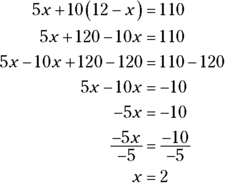
Matthew has two nickels, so the remaining 10 coins must be dimes.
When you take the ASVAB, try to rule out any answers that don’t make sense. In this case, you can rule out any answers that don’t total 12 coins (the problem tells you Matthew has “a 12-coin collection”). That means Choices (A) and (D) are automatically wrong, and if you had to guess, you’d have a 50-50 chance of getting the question right with the remaining answer choices.
-
B. $7 on bait; $14 on tackle
Determine how much Dan spent on bait and tackle together by subtracting the cost of the fishing pole from his total bill:

Between bait and tackle, Dan spent $21.00. Let x represent the amount of money Dan spent on bait and 2x represent how much he spent on tackle:

Dan spent $7 on bait, so replace x with 7 to find out that he spent $14 on tackle.
-
A. 3 hours
Let x represent the amount of time Luke spends reading, and let 2x represent the time he spends playing soccer:

That tells you that Luke will spend 1.5 hours reading. He’ll spend twice that playing soccer:

Luke will spend three hours playing soccer.
You can solve more-complex problems the same way if you convert hours into minutes.
-
C. 2 hours
Justin has a half-hour (0.5 hour) head start on Bradley because he left MacDill at 12:00 p.m.; Bradley didn’t leave until 12:30 p.m.
Let x equal the amount of time Justin flies, and remember that these types of problems are often easiest to solve using tables. Don’t forget the formula for distance is
 , with d representing distance, r representing rate (speed), and t representing time.
, with d representing distance, r representing rate (speed), and t representing time. 
Now you can determine the time (x) by making both distances equal in an equation:
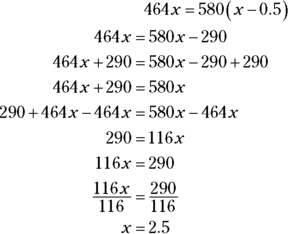
The variable x represents the amount of time Justin flies. However, the question asks how long it will take Bradley to catch up to Justin. Bradley left a half-hour after Justin did, so subtract a half-hour from Justin’s time in the air to figure out how long Bradley had to fly:

That means Bradley will catch up to Justin in 2 hours. (Don’t let little details like this trip you up on the ASVAB!)
-
C. 6 hours
Note that the question asks you “how long,” which means that time is the unknown variable.
The easiest way to solve this problem is with a chart of the trucks’ movement. In the chart, x equals the time in hours for Truck 1. Because the second truck leaves two hours later, represent its time with
 . Use the distance formula,
. Use the distance formula,
 , to figure out what goes in the distance column.
, to figure out what goes in the distance column. 
Use the two distances to create your equation:
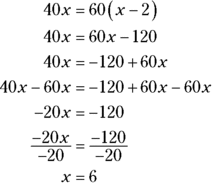
The first truck will have been on the road for 6 hours by the time the second truck overtakes it.
-
C. 45 minutes
Use the distance formula, which is
 , where d represents distance, r represents rate, and t represents time, to figure out the answer to this question. Replace the variables with what you know to isolate and solve for t:
, where d represents distance, r represents rate, and t represents time, to figure out the answer to this question. Replace the variables with what you know to isolate and solve for t: 
The units the problem gives you are hours, which means Ayla will need
 of an hour, or 45 minutes, to travel 6 miles.
of an hour, or 45 minutes, to travel 6 miles.Note: Using mental math, you can reason that 6 miles out of 8 miles is 3 out of 4, which is expressed as
 , so it should take Ayla 45 minutes to bicycle that far — no formulas required!
, so it should take Ayla 45 minutes to bicycle that far — no formulas required! -
A. 3
One-third of 18 is 6, so that’s how many Army Commendation Medals Fani will give to her troops. One-half of 18 is 9, so Fani will give out a total of 9 Army Achievement Medals.
The sum of the Army Commendation Medals and Army Achievement Medals is 15. The remaining awards are Certificates of Achievement, so subtract 15 from 18 to find out how many of those Fani will give her troops:
 .
. -
B. 2.7 hours
This is a shared-work problem because Marie and Darl are both filling the pool together. Let a represent the time it takes Marie to fill the pool, let b represent the time it takes Darl to fill the pool, and let c represent the time it will take them to fill it together:

Find the least common denominator and solve:

-
A. $29
The good news: These kinds of problems look a lot trickier than they are. The crafty ASVAB question writers try to dazzle you with loads of information; as long as you know how to pull out what you need, you’ll be in good shape.
Let x represent how much money Jesse has. Let 2x represent how much Tina has, because she has twice as much as Jesse does, and let
 represent how much David gets (he has $5 less than Tina). The sum is $80, so create an equation that looks like this:
represent how much David gets (he has $5 less than Tina). The sum is $80, so create an equation that looks like this: 
Solve the equation for x to find out how much Jesse has:

Jesse has $17, and because Tina has twice as much as he does, multiply that by 2; now you know that Tina has $34. David has $5 less than Tina, so subtract 5 from 34 to find out that David has $29.
Check your math by adding up everyone’s money:

-
B. 75 = x(x + 15)
The word product means that the problem involves multiplication, and when you see more than, you know you’re adding. Therefore, you can express this equation this way:

Here, one factor is x and the other factor is
 , and their product equals 75.
, and their product equals 75.There are several other ways to express the equation, but when you see a question like this on the ASVAB, it’s often best to go through the answer choices to see which one fits instead of creating your own formula. (It’s faster, too!)
-
D. 31
Let n equal the first odd number, and let
 represent the second number. Set up your equation based on what you know from the problem; then solve for n:
represent the second number. Set up your equation based on what you know from the problem; then solve for n: 
The first number is 29, and because the question tells you that the numbers are consecutive (in a row) odd numbers, you know the higher number is 31.
A quick check to see whether
 is wise.
is wise. -
C. $21
The unknown number is how much Noah has. Let x represent how much money Noah has, and let
 represent how much money Patrick has. (Patrick has $50, which is $8 more than twice what Noah has.)
represent how much money Patrick has. (Patrick has $50, which is $8 more than twice what Noah has.) 
Because x represents Noah’s money, you know he has $21.
-
D.

Let x represent the number you don’t know, and pick out the key terms you need from the problem. When you see the word is, think of an equals sign; when you see times or of, you know you’ll need multiplication.
Start with the solution: “four times a number.” That means 4x.
“Six more” means you need to add 6 to
 times the number:
times the number: 
Combine both parts so the whole equation looks like this:

-
C. $155
Let x represent the amount of money Beto has, and let
 represent the amount of money Pili has. Create an equation and solve for x to find out how much Beto has:
represent the amount of money Pili has. Create an equation and solve for x to find out how much Beto has: 
Beto has $155, which you can check by replacing x in the equation for Pili’s money:

-
A. $750
First figure out how much Evan is paying by determining 20% of $1,875:

Evan pays $375 in rent, which contributes to the $1,875 total. Write your equation to include what everyone pays, letting 2x represent what Andrew and Kara pay together (remember, they pay equal amounts):
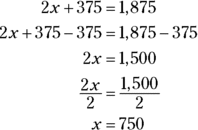
Andrew pays $750 in rent.
-
D. y = 2x + 9
To express this problem as an algebraic equation, extract all the information you need. When you see terms like more, you know you need to add. Twice means you also have to multiply.
The variable x represents the number of green marbles Divana has, so you can set up your equation this way:

-
C. $44.50
First find out how much Judi spent at the casino based on how much Janice spent. Let x represent Judi’s spending:

(If you read the problem, you could also reason that Judi spent half of $135, which happens to be $67.50, instead of creating an algebraic formula.)
Judi spent $67.50, and then she paid $23 for the taxi ride:

Janice spent $135, so subtract Judi’s spending, which was a total of $90.50, from that amount to find out how much more Janice spent than Judi did:

Janice spent $44.50 more than Judi.
-
B. 21
Pat and Gavin are two of the males waiting in line with 48 other people, so there are a total of 50 people. Let x represent the number of males, and let
 represent the number of females (remember, there are 8 fewer females than males in the line). Create an equation:
represent the number of females (remember, there are 8 fewer females than males in the line). Create an equation: 
There are 29 males, and the problem tells you that there are 8 fewer females than males. Subtract 8 from 29 to determine that there are 21 females in line.
-
D. 43.18 hours
Don’t let extra information confuse you on the ASVAB. You don’t need to know how much Glenn charges at all; you only need to know how much Charra charges, which is $110 per hour.
The problem tells you how much the project costs ($4,750), but it doesn’t tell you how long it takes to complete at $110 per hour. Let x represent the amount of time it takes Charra to complete $4,750 worth of work on a website, and create your equation with what you know:

It takes Charra about 43.18 hours to complete a website that costs $4,750.
If you needed to know how long it would take Glenn, you could use the same formula with his hourly rate.
-
A. 224
Start with the least quantity: the children. Let x represent the number of children, let 5x represent the number of men, and let 3x represent the number of women. Structure your equation this way, and then isolate x to find out how many children are in the group:
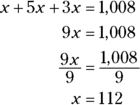
Now you know there are 112 children, so you can figure out how many men and women are in the group:

Don’t forget the rest of the problem, which asks you to find out how many more men there are than women. Subtract 336 from 560:

There are 224 more men than women in the group.
Check your math by adding all the numbers (men, women, and children) together to get 1,008:

-
C. 10 = 4x
The solution to the problem is 10, so that belongs alone on one side of the equals sign. When you read the word product, you know that you’re dealing with multiplication. Your equation should look like this:
 .
. -
B. 54 and 55
Let x represent the first number, and let
 represent the second number. Then create your equation:
represent the second number. Then create your equation: 
The first number is 54, and because the problem tells you that you need consecutive numbers (and because the second number is
 ), you know the second number is 55.
), you know the second number is 55.Sometimes on the ASVAB, running through the answer choices is a good idea. You can immediately rule out Choice (D) because the numbers aren’t consecutive, and you can rule out Choices (A) and (C) because they don’t add up to 109.
-
A. 15
Let x represent the first number,
 represent the second number,
represent the second number,
 represent the third number, and
represent the third number, and
 represent the fourth number. The sum is 54, so write your equation using the appropriate terms and then solve for x:
represent the fourth number. The sum is 54, so write your equation using the appropriate terms and then solve for x:

The first number in the sequence is 12, and the final number is
 . That means the greatest number in the sequence is 15.
. That means the greatest number in the sequence is 15. -
C. 28
Let x represent the number of pies that Steve and Stan made. Fran made twice as many as they did, so the number of pies she made equals 2x. Replace x with the number of pies that Steve and Stan made, which the problem says is 14:

This question is a good place to use mental math. Think: What is twice (or two times) 14?
-
D. $312,000
Let x represent the amount of money Stacy spent, and let
 represent what Jim spent. Create your equation and isolate x to find out how much Stacy spent:
represent what Jim spent. Create your equation and isolate x to find out how much Stacy spent: 
You know that Stacy spent $88,000, so replace the variable x in Jim’s equation to find out how much he spent:

Jim spent $312,000 of the couple’s money. You can check your math by adding $312,000 to what Stacy spent, which was $88,000, to make sure they add up to $400,000:

-
B. 24
Start with the fewest number of colored balls that Bryan bought for Roscoe. According to the problem, Roscoe has the fewest orange balls, so let x represent the number of orange balls. Let 2x represent the number of yellow balls, and let 6x represent the number of red balls. Write your equation, setting the sum of the colored balls equal to 36:
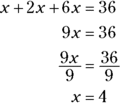
That means Roscoe has 4 orange balls. The term that represents how many red balls Roscoe has is 6x, so replace the variable with 4:
 , so Roscoe has 24 red balls.
, so Roscoe has 24 red balls. -
C. $55
Faith has the least money, so let x represent how much she has. Let 2x represent how much Chandler has, and let
 represent how much Sadie has. The total money is $106, so write your equation like this:
represent how much Sadie has. The total money is $106, so write your equation like this: 
Determine how much Faith has by isolating x:
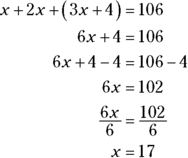
Faith has $17, and Sadie has three times that amount plus $4:

Sadie has $55. (Just for the record, Chandler has $34 because he has twice as much as Faith.)
-
D. $15
Dani has the least money, so let x represent her share. Mike has two times what Dani has, so let 2x represent Mike’s portion of the money, and let
 represent what Nicklaus has. Their money totals $33.75, so write your equation this way and solve for x, Dani’s amount:
represent what Nicklaus has. Their money totals $33.75, so write your equation this way and solve for x, Dani’s amount:

Dani has $6.25, and because the problem tells you that
 represents how much Nicklaus has, replace the variable with $6.25 (remember, x represents Dani’s share of the money):
represents how much Nicklaus has, replace the variable with $6.25 (remember, x represents Dani’s share of the money): 
Nicklaus has $15.
-
A. 47 – x = 29
When a problem tells you that someone gave something away, you know you have to subtract. Because this problem doesn’t tell you how many books Janae gave to Ellis, that’s the unknown variable in your equation. Let x represent the number of books Janae gave to Ellis:

-
D. 5, 7, and 9
Let n represent the first odd number. Because the numbers are consecutive odd numbers, let
 represent the second consecutive odd number, and then let
represent the second consecutive odd number, and then let
 represent the third consecutive odd number. Create an equation and solve:
represent the third consecutive odd number. Create an equation and solve: 
The first number is 5, which tells you that the next odd numbers in the sequence are 7 and 9.
On problems like this one, plugging in the likely answer choices may be faster. If they add up to the correct amount, you can choose quickly and move to the next problem. You have only 39 minutes to answer 16 questions on the Arithmetic Reasoning subtest of the CAT-ASVAB and 36 minutes to answer 30 questions on the paper-and-pencil version, so save time where you can.
-
C. $103
Let x represent what Traci made because she made the least. Let
 represent what Jill made, and let
represent what Jill made, and let
 represent what Donna made. Add their earnings and set the total equal to 141; then solve for x:
represent what Donna made. Add their earnings and set the total equal to 141; then solve for x: 
Traci made $27, so to determine how much Donna made, replace x in Donna’s formula with 27:

Donna made $76. The problem asks how much Traci and Donna made together, so add Traci’s and Donna’s earnings:

Together, they made $103.
-
A.

The problem tells you that the number of boys is b, and you can let x be the number of girls. The number of boys is two more than twice the number of girls, so let
 represent the number of boys. That means
represent the number of boys. That means
 .
.You can express this relationship in an equation, and as with any equation, you need to isolate the variable you want to find. Rearrange the equation to get x by itself:
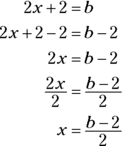
-
B. $28
Let x represent how much Private Snuffy spent on tan T-shirts. The problem tells you that Private Snuffy’s combat boots cost $14 less than twice what he spent on T-shirts, so double x to get twice the cost of the T-shirts and then subtract 14. Set this amount equal to $42, the cost of the boots, and solve for x:

Private Snuffy spent $28 on tan T-shirts (but don’t worry — the military will issue you all the combat boots and T-shirts you need).
-
C. $37.50
Write an equation that lets x represent the cost of 1 gallon of unleaded fuel. Ten gallons cost Luz $30, so

Because premium fuel costs 25% more, it costs 125% of the price of unleaded fuel, so let 1.25x represent the amount Tony spent per gallon. Unleaded gas costs $3 per gallon, so figure out how much Tony spent per gallon by replacing x in his equation with 3:

Each gallon of premium fuel costs $3.75 and Tony bought 10 gallons, so multiply 3.75 by 10 to find out how much Tony spent:

Tony spent $37.50 on fuel.
You’ll find plenty of multi-step problems on the ASVAB, and the correct answers hinge on paying attention to detail. Make sure you read every question thoroughly before you formulate your answer!
-
C.

The word quotient means you’ll be dividing. The word is translates to equals in math, so your equation will look like this:

-
A. 10:12 a.m.
It’s a good idea to convert six minutes into 0.1 hours first. Then create a table that shows each dog, its speed, and variables that represent how long it takes them to meet. To fill in the distance column, use the formula
 , in which d represents distance, r represents rate, and t represents time:
, in which d represents distance, r represents rate, and t represents time: 
Set the distances equal to each other and solve for x to determine how long Cujo ran:

One-fifth of an hour is
 minutes, which shows you that Cujo had run 1 mile by 10:12 a.m.
minutes, which shows you that Cujo had run 1 mile by 10:12 a.m.Jack left at 10:06 a.m., running at 10 miles per hour. After 6 minutes had elapsed, Jack had run 1 mile. That means Jack caught up with Cujo 6 minutes after he escaped, at 10:12 a.m.
-
A. 5.24 hours
To find out how much time something takes when you know distance and rate, use the distance formula
 , where d represents the distance, r represents the rate, and t represents the time. Fill in what you know from the question:
, where d represents the distance, r represents the rate, and t represents the time. Fill in what you know from the question: 
-
D. x = y + 35
When you see more than in a word problem, you know you need to add. The width of the field is y, and its length is 35 yards more than its width. That means
 is the correct way to express this relationship in mathematical terms.
is the correct way to express this relationship in mathematical terms. -
A. 60 minutes
Word problems are notorious for including extra information to distract you from pulling out the data you need. To slash through the sludge, find out how long it will take each journalist to arrive on the scene.
Use the distance formula
 , where d represents distance, r represents rate, and t represents time.
, where d represents distance, r represents rate, and t represents time.Channel 7:

Channel 4:

Channel 7’s journalist gets to the rally in 6 hours, while Channel 4’s journalist arrives in 7 hours (it doesn’t matter what time they left; that information is just there to distract you).
The journalist from Channel 7 arrives 60 minutes sooner than the journalist from Channel 4 does.
-
C.

When you see product in a word problem, you’re dealing with multiplication; when you see quotient, you’re dealing with division. You express the relationship in this problem with an inequality, because it uses the phrase “is greater than or equal to”:

-
B. $42
Before you tackle this problem, you must define the variable. Let x represent the amount Abbas starts with, because he starts with less money than Safir does. Let 6x represent how much money Safir starts with, and create a table so you can visualize the problem.

Set up an equation that shows the relationship between their “after” earnings. Safir will have three times as much as Abbas:

Solve for x to find out how much money Abbas started with:

Go back to your original representations of what each man had. Abbas had $6 before earning an additional $8, so now he has $14.
Safir had six times what Abbas originally had, so Safir had $36. He’s earned another $6, though, so now he has $42.
Now, Abbas has $14 and Safir has $42. Check your math by making sure that
 . (It does!)
. (It does!) -
C. 164 and 401
When you see the word sum in a word problem, you know it involves addition. Let x represent one number you’re looking for, and let
 represent the other number. Create an equation that looks like this:
represent the other number. Create an equation that looks like this: 
Solve that equation for x:

You know that one number is 237. To find the second number, add 164:

The second number is 401.
Check your math by adding 237 and 401 to make sure they add up to the original sum, which is 638:
 .
. -
B. $2,065.15
Let x represent how much money Lillian made. If Lillian’s pay is x, Ron’s pay is
 . Together, they made $4,600, so your equation should look like this:
. Together, they made $4,600, so your equation should look like this: 
Solve for x to find out how much money Lillian made:

Lillian made $2,534.86, which you represented with x. Replace x in the formula for Ron’s pay to find out how much he made:

Ron made $2,065.15.
-
A. 25 and 26
For a question like this, it’s usually faster to run through the answer choices instead of setting up formulas and equations.
However, here’s the algebraic approach. This problem deals with the addition of two unknown numbers, and you can express the problem as an equation:

Solve the equation for x to find the first number:
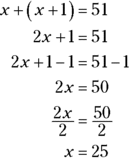
The first number is 25. Remember, you need the next number in line, which you expressed as
 . Replace x with 25 and solve for the second number:
. Replace x with 25 and solve for the second number: 
The two numbers are 25 and 26.
-
C. 654
Let x represent the number of strawberries the women can pick together in one hour. You know that Renee picks 110 strawberries each hour and Jeniece picks 108 per hour, so by adding them together, you can find the value of x.

Because you need to find out how many strawberries the women can pick together in 3 hours, represent that figure with 3x:

Together, the women can pick 654 strawberries in 3 hours.
-
B. 11
Let x represent the number of awards Omar has. That means 2x represents Chris’s awards and
 represents the number of awards Michael has. Set up an equation that looks like this:
represents the number of awards Michael has. Set up an equation that looks like this: 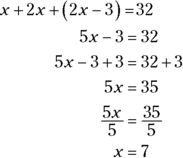
Omar has 7 military awards. You don’t have to be concerned about how many Chris has in this problem. Find out how many awards Michael has by replacing x in the expression
 :
: 
Michael has 11 military awards.
-
C. 2.4 cups
Let x represent the number of cups of coffee in the pot, and set up an equation to show how much each person drank:

Find the least common denominator, which is 12, and multiply each expression by 12 to cancel out the denominators:

Solve the equation as you normally would:
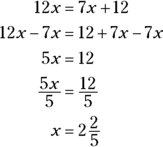
Convert the fraction to a decimal (because the answer choices are in decimal form); the answer is 2.4 cups.
-
C. $180
Let x represent the amount of money Kathleen started with. Create an equation representing the sum of her purchases and the remaining money:

The least common denominator for all those denominators is 30. Multiply each part of the equation by 30:

Solve the equation normally to find x:

Kathleen started out with $180.
-
A. 18
Let n represent the number you need to find. Then create an equation:

Find the least common denominator. The denominators are 2 and 3, so the least common denominator is 6. Multiply each term by 6 to cancel out the denominators and create a new equation:
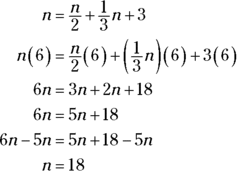
-
C. 20
The problem tells you everything you need to know to create an equation that looks like this:

Find the least common denominator, or LCD (in this case, it’s 5). Multiply each term by 5 to cancel out the denominators:
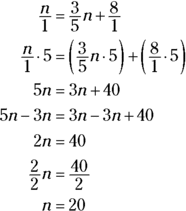
-
A. 36 tablespoons
Remember that the whole is equal to the sum of the parts. Let x represent the original amount of sugar in Sgt. 1st Class Stith’s container and create an equation that accounts for every tablespoon of sugar like this:

Get rid of all the fractions by finding the least common denominator. In this case, it’s 12, so multiply each term by 12 and cancel the denominators:

Combine like terms and solve for x, which is the original amount of sugar in Sgt. 1st Class Stith’s container:

There were originally 36 tablespoons of sugar in the container.
-
C. 3x = 39
Let x represent the number of toys Robbie has. Because Jules has twice as many, let 2x represent the number of toys Jules has. Your equation will look like this:

You can simplify the equation by expressing it this way:

-
A. 96 miles
Let x represent the boat’s speed and create a table using the distance formula, which is
 , where d represents distance, r represents rate (speed), and t represents time.
, where d represents distance, r represents rate (speed), and t represents time.You don’t know how far the boat traveled, but you do know that it went 3 hours one way and 4 hours the opposite way. You also know that it had a 4-mile-per-hour current going in its favor downstream and a negative 4-mile-per-hour current going against it upstream.

The two distances are the same, so each distance belongs on its own side of one equation. Set up the equation and solve for x:

The boat’s rate with no current is 28 miles per hour, so you can determine how far the boat went one way by using the distance formula and plugging in the facts you have. Here’s the distance using the downstream formula, though the upstream one works just as well:

The boat traveled 96 miles each way.
-
B. 21 mph
Current problems can be tough if you can’t visualize them, so it’s often a good idea to sketch out a table (test administrators will provide you with as much scratch paper as you need when you take the ASVAB) based on the formula
 , where d represents distance, r represents rate (speed), and t represents time. Let x represent the boat’s speed.
, where d represents distance, r represents rate (speed), and t represents time. Let x represent the boat’s speed. 
All you need to solve for is x, because you want the boat’s speed in calm water. (The current doesn’t matter except that it helps you understand how fast the boat is moving.)
To solve for x, base your equation on the boat’s distance. The boat traveled the same distance downstream and upstream:

The boat’s speed in calm water (without any currents acting on it) is 21 miles per hour.
-
C. 85
Let n represent an odd number. The next odd number is 2 higher than that, so let
 represent the next odd number. The next odd number is
represent the next odd number. The next odd number is
 , and the last is
, and the last is
 , because they’re all consecutive odd numbers.
, because they’re all consecutive odd numbers.Their sum is 328, so your equation looks like this:

Remove the parentheses and solve for n, the first number in the sequence:

There are four consecutive numbers that add up to 328, so you can either scrawl out the sequence on the scratch paper the test administrators will give you — 79, 81, 83, 85 — or you can work out the greatest number by replacing n in the last expression
 . Either way, you come up with 85.
. Either way, you come up with 85. -
C. 6 pounds
Mixture problems require you to define a variable before you begin. In this case, let s represent the number of pounds of salted caramel (because it costs less than the chocolate does). Create a table that allows you to visualize the problem.

Use the “Total” column to create your equation. Charlie spent $80 on candy altogether, so the other two figures belong on one side of the equation, and the amount he spent belongs on the other:
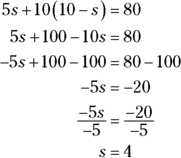
Four pounds of the candy was salted caramel, so the remaining 6 pounds was all chocolate.
-
C. 240
In this problem, you’re concerned only with the three-fourths of 400 students who go to the National Mall. There are a total of 300 students heading to the National Mall, and of those 300, there are four times as many boys as there are girls. You can express the relationship this way by letting x represent the number of girls and 4x represent the number of boys:

That means 60 girls went to the National Mall; because 4x represents the number of boys who went, substitute 60 for x and solve:

Therefore, 240 boys went to the National Mall.
-
D. $228
Define the variable first by letting x represent the first person’s share of the money. If x represents the first person’s share, 2x represents the second person’s share. Finally,
 represents the third person’s share. Create an equation that looks like this and solve for x:
represents the third person’s share. Create an equation that looks like this and solve for x: 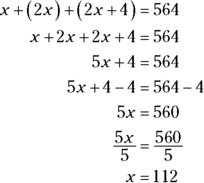
The first person has $112. Double that to find out how much the second person has:

The second person has $224, so because the third person has $4 more, the third person has $228.
-
B. 25
Define the variable first by letting x represent the number of apples Jakson can buy. Set up an equation to find out how many he can buy at $0.20 while spending $5; then solve for x:

Jakson can buy 25 apples for $5 if they’re $0.20 each.
-
D. $1,440
This problem requires you to do two things: Find the area of the floor, and find the total cost of the flooring. To find the area, multiply the length by the width:

The floor’s area is 180 square feet, so multiply that by $8 so you can determine the entire cost:

It will cost Quintin $1,440 to buy enough hardwood flooring for the room.
-
C. 14 laps
A hexagon has six sides, so figure out the entire length of the track first:

Each lap was 5,280 feet, so now you can let x represent the number of laps Heather needs to run for a total of 73,920 feet. Your equation should look like this:

Heather needs to run 14 laps to have that many feet under her belt. (Remember, too, that 5,280 feet equals 1 mile; that means Heather needs to run 14 miles, but don’t worry — you’ll probably have to do that only once or twice during your military career, unless you become a Special Forces operator.)
-
A. 270
In a problem such as this one, the first thing you need to do is define the variable. Let x represent the number of minutes Julian used on his international calling plan, because that’s the number you don’t know. Set up your equation like this (don’t forget about the $15 monthly fee) and solve for x:
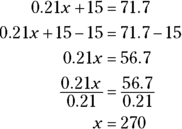
Julian used 270 international minutes if his bill was $71.70.
You may want to use quick mental calculations instead of setting up equations. For this question, if you’re a bill payer, you’ll know to subtract 15 from $71.70 and divide the difference by $0.21 to find how many minutes were used. Doing the calculations without first writing out an equation may be quicker, but you may sacrifice accuracy for speed if you’re not careful to look over your work and reread the question.
-
D. 28 + n = 412
When you see more in a word problem, you know you’ll have to add. Because the end result is 412 (“after Fred gave Omar n paperclips, Omar had 412”), you know what belongs after the equals sign.
-
C. 51 square feet
Let x represent the size of the banner Gabriela bought from Rose, because that’s the unknown. Set up an equation that looks like this, and solve for x:

The banner Gabriela bought from Rose was 51 square feet.
-
B. 57 minutes
This problem requires you to use the same variable twice, once for the car and once for the train. Let t represent how much time will pass before the car and the train are 100 miles apart. Use the distance formula, which says
 (where d is distance, r is rate, and t is time), and plug in what you know from the problem. The car traveled 45t, and the train traveled 60t, for a total of 100 miles:
(where d is distance, r is rate, and t is time), and plug in what you know from the problem. The car traveled 45t, and the train traveled 60t, for a total of 100 miles: 
Solve for t to figure out how many hours it will take the two vehicles to put 100 miles between them:
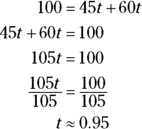
Because the answer choices are listed in minutes, you’ll need to figure out how many minutes equal 95% of an hour:

That means that it will take 57 minutes for the two vehicles to be 100 miles apart.
-
D. $60
You know that each donation sheet has room for 25 names, and you know that Nathan’s goal is $1,500. Let x represent the amount of money each donor would have to pitch in to help Nathan reach his goal. Create an equation and solve for x:

If each donor gives $60 (or if the average donation is $60), Nathan will meet his goal without having to use another donation sheet.
-
B. $15.00
The problem gives you enough information to find out how much a tie costs. Let t represent the cost of a tie, p represent the cost of a pair of pants, and s represent the cost of a shirt. Then build an equation based on what you already know:

Replace the variables with the prices listed in the problem; then isolate t:

One tie costs $15.
-
D. 12
Divide 288 by 24 to find out how many groups of kids needed supervision:
 . Because there are 12 groups of students and each group of students must be supervised by a teacher, there are 12 teachers.
. Because there are 12 groups of students and each group of students must be supervised by a teacher, there are 12 teachers. -
C. 27 hours
You can express Benjamin’s situation with an inequality, letting h represent the number of hours he needs to study. The problem says “the minimum number,” so your inequality will look like this:

Solve the inequality just as you would any other:

That tells you Benjamin needs to study at least 27 hours each week. (You can also use your own arithmetic reasoning to add 15 and 12 — the number of hours Benjamin has to work, plus the number of hours he has to study — in your head to arrive at the correct answer.)
-
D. 50 minutes
Use the distance formula, which says
 , to create your equation. Let t represent the amount of time, in hours, that each person is driving. Solve for t:
, to create your equation. Let t represent the amount of time, in hours, that each person is driving. Solve for t: 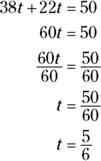
It will take
 of an hour for the two to put 50 miles between them. The answer choices are presented in minutes, so convert
of an hour for the two to put 50 miles between them. The answer choices are presented in minutes, so convert
 hour into minutes:
hour into minutes: 
That tells you it will take 50 minutes.
-
A. 34
As with most mixture word problems, it’s easiest to create a table. Let p represent the number of paperbacks Tysha bought, because they cost less than hardcovers do.

Create an equation using the “Total” column:
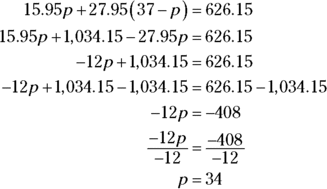
Tysha bought 34 paperbacks. The remaining three were hardcovers.
-
D. 60 gallons
Define your variable first. Let x represent the number of gallons Olivia needs from the 20% concentrate. That means
 will represent the number of gallons she needs of the 60% concentrate.
will represent the number of gallons she needs of the 60% concentrate.A table can help you visualize the problem:

You don’t know what belongs where the “Total” row and the “Total” column intersect. If you multiply across the “Total” row, the answer is 24, so that goes on one side of your equation. Add down the “Total” column and put the sum on the other side of the equation:

Olivia needs 60 gallons of the 20% concentrate to make her solution.
-
A. 17z = 340
To find out how much a certain number of items weighs, you multiply. Each loaf weighs z ounces, and there are 17 loaves, which you can represent with the expression 17z. The problem tells you that together, all 17 loaves weigh 340 ounces. Your equation looks like this:

Because the question only asks you to create an equation, you can stop there. Don’t create more work for yourself on the ASVAB — you already have plenty to do!
-
C. 44
Let x represent Sylvia’s age now. That means
 represents Robert’s age (remember, he’s 9 years older than she is).
represents Robert’s age (remember, he’s 9 years older than she is).That means that in 7 years, Sylvia’s age will be
 .
.It also means that in 7 years, Robert’s age will be
 (you need to add his original 9-year age gap to 7).
(you need to add his original 9-year age gap to 7).You know that in 7 years, their ages will equal 93. That leaves you with a simple equation to solve using the information from the problem:

Combine like terms to simplify the equation:
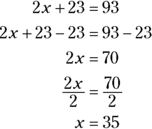
Because x represents Sylvia’s age, and you know
 represents Robert’s age, solve by replacing the variable with the value for x:
represents Robert’s age, solve by replacing the variable with the value for x:
 .
. -
B. 30 boxes
Many mathematicians find it’s helpful to create a table to figure out a problem like this one. Let x equal the number of boxes of candy Deb bought and enter what you know into a table:

Deb’s profit was $15 per box, because she purchased them for $15 but sold them for $30. Now you know that your equation must look like this:

When you solve for x, you’ll have the number of boxes of candy she bought originally:

Deb bought 50 boxes of candy. You know from the problem that she sold all but 20 boxes, so she sold 30 boxes.
-
B. 1,600 bacteria
Use the exponential equation
 , with a representing the beginning number of bacteria and b representing the growth factor (which is 4, because the number of bacteria quadruples). Let t represent the time Connor is running the experiment, and let p represent the time in which the bacteria population quadruples:
, with a representing the beginning number of bacteria and b representing the growth factor (which is 4, because the number of bacteria quadruples). Let t represent the time Connor is running the experiment, and let p represent the time in which the bacteria population quadruples: 
To find
 without using a calculator, reduce the fractional exponent:
without using a calculator, reduce the fractional exponent: 
When you read the fractional exponent, you know to find the square root of 4 and cube that answer:

Continue solving the problem:

-
A. 22 hours
Define the variable first. Let x represent the number of hours Dorothy needs to groom the horses. Because the problem says “at least,” you know that you’re dealing with an inequality with a solid minimum; that means you’ll use
 in the problem. Your inequality should look like this:
in the problem. Your inequality should look like this: 
Dorothy needs to groom the horses for at least 22 hours per week.
Although this explanation shows you the algebra involved in solving, you may be able to calculate the correct answer in your head by adding 10 and 12. (If you can answer questions without writing equations when you take the ASVAB, you’ll save time.)
-
A. 46
Cats and dogs each have four legs, and chickens have two. Let x represent the number of cats and dogs together, and let y represent the number of chickens. Let z represent the total number of legs among all the animals. Your formula looks like this, because you know how many legs each animal has:

Now replace the variables with what you know about the number of cats and dogs (there are 10 total) and the number of chickens:

The animals have a total of 46 legs.
-
C. 500
Let x represent the number of balloons that Rossalyn originally bought. She sold all but 10, so the number she sold is
 . Set up a table so you can find the appropriate formula:
. Set up a table so you can find the appropriate formula: 
To get the profit, subtract the spending (total bought) from the income (total sold). Set the profit equal to $1,225 and then solve for x:
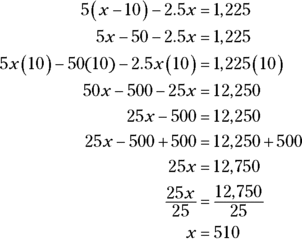
Rossalyn originally bought 510 decorative balloons, but she didn’t sell 10 of them. That means she sold 500 balloons to make a profit of $1,225.
-
D. 99
Let x represent what Kathy needs to score on the final exam. There are six tests that count toward her grade — the four she has already taken and the final exam, which is worth two test grades — which means you’re dealing with a weighted average problem. Your equation should look like this:

Simplify the equation and solve for x:
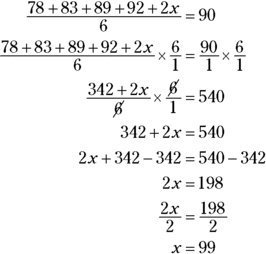
Kathy needs to score 99 on both tests to get an A in her geometry class. Fortunately, she’s been using this book to study for the ASVAB, so she’ll be in great shape.
-
C. 3.5
A good way to solve this problem is to use matrices because there are so many inputs. Put Jazmine and Jeneva in the same matrix, and then create a matrix that represents how much each portion of the class is worth. Your final matrix will show you each girl’s total:

Jazmine’s average is

And Jeneva’s average is

Subtract Jeneva’s final score from Jazmine’s to find out how many percentage points Jazmine came out ahead:

Jazmine beat Jeneva by 3.5 percentage points.
If matrices confuse you, you can organize the data in a table, which will allow you to write the same calculations you would with a matrix:

Convert each percent into a decimal and complete the calculations as before.
Matrices and tables are both great ways to organize data, so when you take the ASVAB, do what works best for you.
-
D. $110.29
The shirt cost Alejandra $34.20, but she sold it at a 5% loss. To find out Alejandra’s loss, multiply $34.20 by 0.05:

Now subtract her loss, $1.71, from the total she had to start with (she recouped all her money except that amount, which she lost in the sale to Tatiana):

Alejandra now has $110.29.
-
D. 7
Let q equal the number of quarters Bonnie has. Because she has 15 coins and those that aren’t quarters are dimes, let
 represent the number of dimes Bonnie has. A quarter is worth $0.25 and a dime is worth $0.10, so you can create an equation that reflects Bonnie’s change this way:
represent the number of dimes Bonnie has. A quarter is worth $0.25 and a dime is worth $0.10, so you can create an equation that reflects Bonnie’s change this way: 
Solve for q to find out how many quarters Bonnie has (it’s easier if you multiply both sides by 100 so you can get rid of all the decimals):

That tells you that Bonnie has 8 quarters. The remaining coins are dimes, and you know she has 15 coins altogether. That means she has 7 dimes.
-
B. 2
This scenario lets you create a simple system of equations that you can solve using substitution. To get your equations, let s represent the number of single-layer cakes Bobby will buy, and let d represent the number of double-layer cakes he’ll buy. He needs to buy six cakes and has $200 to spend:

Solve the first equation for s:

Substitute the value of s in the second equation:

Bobby can buy 2 double-layer cakes, but he must leave with 6 cakes. That means he needs to buy 4 single-layer cakes.
-
A. $1,460
With so many factors at play, you may want to organize a chart to solve this problem.

Set up and solve an equation that allows you to calculate the resale value of the mats:

The total value of all the mats is $1,460.
-
B. $9,450
Use the formula
 for exponential decay, with P representing the principal (starting amount), r representing the depreciation rate, and t representing the time in years.
for exponential decay, with P representing the principal (starting amount), r representing the depreciation rate, and t representing the time in years. 
The car will be worth approximately $9,450 after one year.
It’s helpful to know the math for these types of problems when you take the ASVAB, but in this case, you could’ve skipped the formula by subtracting 10% of the car’s purchase price ($1,050) from the purchase price:
 . (You’re dealing with only one year of depreciation.)
. (You’re dealing with only one year of depreciation.) -
D. $11,250
$15,000 is 75% of $20,000, so you know the car has depreciated at a rate of 25% in one year.
Your new starting amount is $15,000 (that’s how much the car was worth after it had depreciated 25% from its original purchase price).
Use the formula
 , with P representing the principal (starting amount), r representing the depreciation rate, and t representing the time in years:
, with P representing the principal (starting amount), r representing the depreciation rate, and t representing the time in years: 
The vehicle is worth $11,250 after another year has elapsed because it depreciates at a rate of 25% per year.
-
D. 385 miles
To find out how far Captain Mike has traveled, let t represent the number of hours he’s been on the go. Use the distance formula,
 , where d represents distance, r represents rate (speed), and t represents time. You know that Captain Mike leaves the dock at 10 a.m. and is traveling until 5:00 p.m., so he’s on the move for 7 hours.
, where d represents distance, r represents rate (speed), and t represents time. You know that Captain Mike leaves the dock at 10 a.m. and is traveling until 5:00 p.m., so he’s on the move for 7 hours. 
After 7 hours, Captain Mike has logged 385 miles in his boat.
-
C. $1,790.67
Use the formula
 with P representing principal (the beginning investment), r representing the growth rate per year, n representing the number of times interest is compounded per year, and t representing the number of years that have passed. Replace the variables in the formula to find out how much money Matt will have after one year has passed:
with P representing principal (the beginning investment), r representing the growth rate per year, n representing the number of times interest is compounded per year, and t representing the number of years that have passed. Replace the variables in the formula to find out how much money Matt will have after one year has passed: 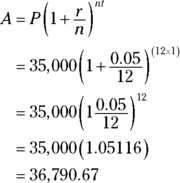
Remember that the question asks you how much Matt had earned in interest, which automatically makes Choices (A) and (D) incorrect, so subtract his original amount from his total amount at the end of the year:

Matt earned $1,790.67 in interest.
-
B. 1 ounce
This problem requires you to use the formula
 because you’re working with a time period during which the lemonade divides in two. Let a represent how much lemonade Bill started with (8 ounces), and let b represent the rate of decay (in this case, evaporation), which is 0.5. Let t represent how much time has elapsed, and let p represent the period of time in which half the lemonade evaporates.
because you’re working with a time period during which the lemonade divides in two. Let a represent how much lemonade Bill started with (8 ounces), and let b represent the rate of decay (in this case, evaporation), which is 0.5. Let t represent how much time has elapsed, and let p represent the period of time in which half the lemonade evaporates. 
Bill must live in the desert! He’ll have only 1 ounce of lemonade left after 18 hours. (Note: This formula also works to find the half-life of radioactive materials.)
You may have noticed that there are 3 sets of 6-hour periods in an 18-hour period, so you can use mental math to halve the quantity three times: 8 halved to 4, 4 halved to 2, and 2 halved to 1 ounce.
-
C. 36
This problem looks tough, but it doesn’t have to be. First, define the variable by letting m represent Melanie’s age now. Right now, Jeanne is three times Melanie’s age, so let 3m represent Jeanne’s age.
You have to add 12 years to both ages because the problem tells you that in 12 years, Melanie will be half Jeanne’s age. Your equation looks like this:

To find out how old Melanie is right now, solve for m, working your way through the equation as you normally would. Start by multiplying both sides by 2 to get rid of the fraction (and save some time):
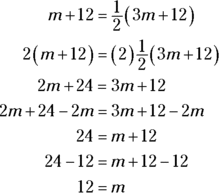
Melanie is 12 now. Jeanne is three times Melanie’s age, so multiply 12 by 3 to discover that Jeanne is 36.
-
C. $76
Let c represent the total cost and create an equation that multiplies the total cost of membership and visits by 2; then solve:

The total cost for Starla and Phoenix to buy museum memberships and each visit 31 times throughout the year is $76.
You can work out this problem without creating an equation. Add 31 and 7 (the total cost of membership and 31 visits), and then multiply by 2 to figure out how much it costs for both people.
If you can solve ASVAB problems such as this one quickly, you’ll have more time to work on others.
-
A. $25.80
You can figure out exactly how much money Emmanuel has based on the information in the problem. Make a quick chart so you can keep track:

Add the total worth together to find out how much Emmanuel has:

Emmanuel has $124.20, but he needs $150 to purchase the software program. Subtract $124.20 from $150:

Emmanuel still needs $25.80 to buy the program.
-
A. 12 pounds
It may be helpful to create a table so you know what equation to use. Let c represent the amount of cheese you’re buying:

Use the “Total” column on the right to create your equation, and then solve for c:
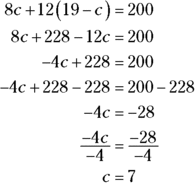
That tells you that you’ll need 7 pounds of cheese in your 19-pound mixture. The remaining 12 pounds must be turkey.
-
D. Both A and C are correct.
Let x be the variable and create an equation that looks like this:

You can also simplify the equation so it looks like this:

Therefore, both Choice (A) and Choice (C) are correct.
Remember, when the ASVAB asks you to express an equation, key words tell you what to do. A reciprocal is the opposite of a number (the reciprocal of
 is
is
 ). Equal means you need to use an equals sign, and sum means you’ll be adding.
). Equal means you need to use an equals sign, and sum means you’ll be adding. -
D. 2 hours
Let x equal the number of hours both Marines need to work together to fill 56 sandbags. Create an equation that looks like this and solve for h:
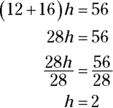
The two Marines can fill 56 sandbags in 2 hours.
-
B.

Let
 represent the time it takes the new machine to fill a mold, because in one hour,
represent the time it takes the new machine to fill a mold, because in one hour,
 of the job will be done. Let
of the job will be done. Let
 represent the amount of time it takes the old machine to fill a mold, because in one hour,
represent the amount of time it takes the old machine to fill a mold, because in one hour,
 of the job will be done.
of the job will be done.Your equation looks like this, with t representing the amount of time the two machines working together need to fill a full set of crayon molds:

Find the least common denominator for the entire equation. In this case, it’s 24t. Solve for t:
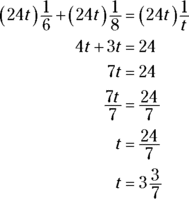
The two machines can fill up one full set of crayon molds in
 hours.
hours. -
C.

Watch for the word quantity. It indicates that more than one term will be involved. The word increased is the first clue that you’ll need to add. When you see times and equals, you know that you’ll multiply and use the equals sign. Quotient means division (which you may represent as a fraction or a fractional expression). Therefore, your equation looks like this:

-
C. 2.1 seconds
This is a classic distance word problem that you can solve by using the distance formula, which is
 , with d representing distance, r representing rate (speed), and t representing time.
, with d representing distance, r representing rate (speed), and t representing time.Create a table that shows you how to set up your equations:

Distance equals rate times time, so use the formula for each runner to find out how quickly she’ll reach her team’s second participant over a 500-meter distance.
Navy runner:

Army runner:

Remember that the problem wants to know how much sooner the Army runner will reach her team’s second participant, so subtract the Army runner’s time from the Navy runner’s time:

The Army runner will reach her team’s second participant 2.1 seconds before the Navy runner will.
-
D. –9
All the clues you need to create your equation are in the problem. Let x represent the number you’re trying to find:

Solve for x to find the number:

Check your work by replacing x in the original equation with –9:

-
C. 6
Let x represent the unknown number (the number of pounds of apples Shane is going to buy). The total cost equals the number of pounds times the price per pound. Because you know apples sell for $4.50 per pound, and because you know he’ll spend $27.50 on apples, your equation looks like this:

Solve for x:

Shane will buy 6 pounds of apples.
-
D. $960
Because the computer depreciates by 20% each year, after the first year it’s worth only 80% of its original price ($1,500). You can find out how much the computer is worth after one year by multiplying 0.8 (for 80%) by the original price:

The problem asks you to figure out how much the computer is worth after two years, so multiply 0.8 by the first depreciated price to find out:

The computer is worth $960 after two years.
-
D. 30
When you see sum in a word problem, that means you’ll be adding. Another tip-off is the word is, which you can express mathematically with an equals sign. Because the problem says twice a number, you’ll also have to use multiplication.
Let n represent the number you need to find. Your equation looks like this:

Solve for n:

Sometimes it’s easiest to plug-and-play the answer choices to find out which is correct. In this case, you need to figure out which of the answer choices times 3 equals 90.
-
B. 1 hour, 20 minutes
Let t represent the amount of time Nichole can spend on English and history. Let 2t represent how much time she needs to spend on chemistry and physics, and add them together so they total 2 hours. Solve for t:

Nichole needs
 of an hour, or 40 minutes, to study English and history. She has two hours total to study, so subtract 40 minutes from two hours, or 120 minutes:
of an hour, or 40 minutes, to study English and history. She has two hours total to study, so subtract 40 minutes from two hours, or 120 minutes: 
Eighty minutes is 1 hour, 20 minutes.
-
C. $2,375
Let x represent John Q. Private’s gross pay, before taxes and other deductions were taken out. Remember that 20% of his gross pay comes out, and he takes home $1,900.
Set up an equation that reflects John Q. Private’s situation:

Solve for x to find out how much his gross pay is, remembering that the coefficient of x alone is 1:
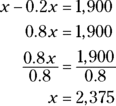
You can double-check your math by finding 20% of $2,375 and subtracting that figure:

John Q. Private makes $2,375 per paycheck before taxes and deductions.
-
A. $2,093
There are at least two ways to solve this problem.
First, you can multiply the original amount by 1.15
 to reflect the new price. Let x represent the new price and convert your percentages to decimals:
to reflect the new price. Let x represent the new price and convert your percentages to decimals: 
The second way to solve this problem requires another step. First find 15% of the original amount by multiplying 15% by $1,820; then add it to the old price:

Either way, you know that the piano now costs $2,093.
-
B. 40 milliliters
If you’re a visual learner, you’ll probably find it helpful to create a table so you can see what you’re doing. Let x represent the number of milliliters you need from the 15% concentrate. Let
 represent how much you need of the 45% concentrate (remember, you need a total of 100 milliliters of the mixture).
represent how much you need of the 45% concentrate (remember, you need a total of 100 milliliters of the mixture). 
When you create your table, you need to fill in the box where the “Total” column and “Total” row intersect so you can create your equation. You get that number by multiplying the amount of concentrate by the percentage (in this case, it’s
 ).
).Your equation should look like this:

Solve by isolating x:
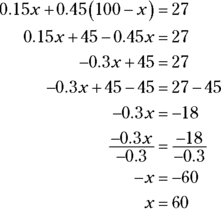
That means you need 60 milliliters of the 15% concentrate in your solution. However, the problem asks you how much of the 45% concentrate you need — but don’t worry. You already know that the expression
 represents the amount of 45% concentrate you and your lab partner need to create the new mixture. Subtract 60 from 100, and you’ll find out that you need 40 milliliters of the 45% concentrate to make your new solution with 27% concentrate.
represents the amount of 45% concentrate you and your lab partner need to create the new mixture. Subtract 60 from 100, and you’ll find out that you need 40 milliliters of the 45% concentrate to make your new solution with 27% concentrate. -
A. About 71.5 hours
The problem is asking you how many hours Rod needs to work, so let h represent the necessary hours. To find out how much his salary is, you multiply h by his hourly wage; that’s 20h. You have to subtract the 30% he pays in taxes and insurance, so convert that to a decimal and multiply it by his salary. Create an equation that looks like this:

Solve the equation to find out how many hours Rod needs to work:

You can see that Rod needs to work about 71.43 hours to make $1,000 after taxes and insurance are paid.
Look back at your answer choices; 71.43 isn’t one of them, so round up and settle on Choice (A), which is about 71.5 hours.
-
C. 10 mph
Create a table that helps you use the formula
 , where d represents distance, r represents rate (speed), and t represents time. Let p be the plane speed, and let w be the wind speed.
, where d represents distance, r represents rate (speed), and t represents time. Let p be the plane speed, and let w be the wind speed. 
When you use the distance formula, your equation looks like this for the tailwind:

Your equation for headwind looks like this:

The first thing you need to do is get rid of one of the variables, so solve the first equation for p (the plane’s speed):

Now that you know
 , replace the variable p in the second equation with that expression:
, replace the variable p in the second equation with that expression: 
The wind speed is 10 miles per hour.
-
D. 60 miles
You need to find out how many miles each recruiter drove, but there’s extra information that can throw you off; it doesn’t matter how long either recruiter was on the road.
Let x represent how far the second recruiter drove. Write an equation that reflects how far they drove and the total miles they drove, like this:

Solve the equation:

Because x represents how far the second recruiter drove, double it to find out how far the first recruiter drove:

The first recruiter drove 60 miles.
-
A. 280
Let t represent the number of female airmen going on the field training exercise. Let
 represent the number of male airmen who are also going on the field exercise. Because the total number of airmen is 490, your equation looks like this:
represent the number of male airmen who are also going on the field exercise. Because the total number of airmen is 490, your equation looks like this: 
There are 210 female airmen on the field exercise, so you can solve the mystery of how many males are going in one of two ways. You can subtract 210 from the total (490 airmen) to find out that there are 280 male airmen, or you can replace t in the expression
 :
: 
No matter how you look at it, there are 280 male airmen going on the field training exercise.
-
B. 58
Consecutive integers require you to assign the variable n to the least number in the sequence. Because n represents the least number, and because you need to find the next three even numbers, let
 represent the next number in the sequence, let
represent the next number in the sequence, let
 represent the next number, and let
represent the next number, and let
 represent the final number. Create an equation that looks like this:
represent the final number. Create an equation that looks like this: 
Remove the parentheses and solve for n to find the least number:
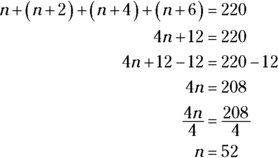
The least number is 52. Because the greatest number is represented by
 , replace n with 52 to find out what it is:
, replace n with 52 to find out what it is: 
The largest number in the sequence is 58.
You can use a shortcut that can save you time when these types of questions pop up on the ASVAB. If you have four consecutive even numbers, each one will contribute about a quarter of the sum. In this case,
 . Two of the numbers in the sequence will be above 55, and two will be below. The next two even numbers above 55 are 56 and 58, so the largest number is 58.
. Two of the numbers in the sequence will be above 55, and two will be below. The next two even numbers above 55 are 56 and 58, so the largest number is 58. -
A. 13
Let d represent the number of dimes in Misty’s purse. You know that she has 21 coins, so represent the number of nickels as
 (because the coins that aren’t dimes must be nickels).
(because the coins that aren’t dimes must be nickels).The total value, $1.70, equals the value of all the dimes plus the value of all the nickels. Each dime is worth $0.10, and each nickel is worth $0.05. Create an equation that looks like this:

Solve the equation for d to find out how many dimes are in Misty’s purse. Remember that in money problems, it’s often helpful to multiply by 100:
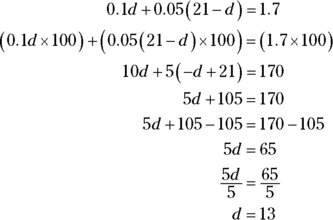
Misty has 13 dimes in her purse. (If the question had asked you how many nickels she had, you would just subtract 13 from 21. That tells you that Misty has 8 nickels.)
-
B. 2.17 hours
Distance equals rate times time, so let t represent the number of hours it will take for the station wagon and the motorcycle to be 250 miles apart. Figure out the distances separately, and then add the two distances together to reach the total distance (250 miles).
Let 40t represent the station wagon’s distance, and let 75t represent the motorcycle’s distance to create your equation. Isolate t to solve:

The two vehicles will be 250 miles apart in about 2.17 hours.
C.

Don’t get mixed up on the two instances of “less than” in this word problem. Create an inequality that looks like this, letting x represent the number you don’t know, and then solve. Don’t forget to reverse the inequality sign whenever you multiply or divide both sides by a negative number.

Your graph will look like this:

-
C.

The formula for the circumference of a circle is
 , where C represents the circumference and r represents the circle’s radius. The problem gives you the radius, so create your equation and solve for C:
, where C represents the circumference and r represents the circle’s radius. The problem gives you the radius, so create your equation and solve for C: 
-
D. 18 cm
The formula for the area of a circle is
 , where A represents the area and r represents the radius. The radius is half the length of the diameter, which you want to find. Set up the area formula:
, where A represents the area and r represents the radius. The radius is half the length of the diameter, which you want to find. Set up the area formula: 
The radius is 9, so double that to find the circle’s diameter:

The circle’s diameter is 18 centimeters.
-
B. 93 feet
The formula for perimeter is
 , where P represents perimeter, l represents length, and w represents width. The formula for area is
, where P represents perimeter, l represents length, and w represents width. The formula for area is
 . You have a system of equations:
. You have a system of equations: 
Solve using substitution: That is, solve one equation for one variable so you can put its value into the other equation. It’s simpler to solve the first equation than the second. Here’s how to solve for l. You can divide everything by 2 to make the calculations simpler (and so you’re working with like terms when you solve the second equation):
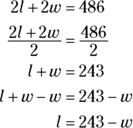
Replace l in the second equation so you can solve for w:
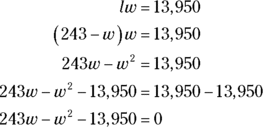
Now you have a quadratic equation that you can solve by factoring:

Solve each expression:

The problem tells you that the narrower side of the garden faces the street, so you know that Woody’s Fences Inc. will need to send 93 feet of white fencing with the workers.
-
D. 5 meters
The formula for the area of a square is
 , where A represents the area and s represents the length of a side. Replace the variable A with what you know, and then solve:
, where A represents the area and s represents the length of a side. Replace the variable A with what you know, and then solve: 
-
A. 85,408 sq. ft.
This question is asking you for the surface area of the water tank. Don’t forget that the cylinder has two ends as well. You can find the surface area of a right cylinder with the formula
 , where SA represents the surface area and r represents the radius. Fill in the variables with what you know and solve:
, where SA represents the surface area and r represents the radius. Fill in the variables with what you know and solve: 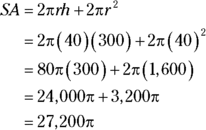
Pi is approximately equal to 3.14, so to find the answer, multiply 27,200 by 3.14:

The surface area of this massive cylinder is approximately 85,408 square feet.
(In the military, you’ll hear the expression, “It’s good enough for government work!” That means you’re close enough to the right answer, and on the ASVAB, 3.14 is good enough for pi. However, it can’t hurt to learn that pi is also approximately equal to
 .)
.) -
A. 12 m
When you take the ASVAB, you get unlimited scrap paper. You may find it helpful to draw a diagram to help you visualize the problem:

The formula for the perimeter of a rectangle is
 , where P represents perimeter, l represents length, and w represents width. The problem gives you the perimeter, and you can figure out the width based on the information given:
, where P represents perimeter, l represents length, and w represents width. The problem gives you the perimeter, and you can figure out the width based on the information given: 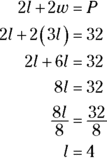
The field’s length is 4 meters, so multiply 4 by 3 to find out how wide the field is:

The field is 12 meters wide.
-
C. 50.24 cm
The formula to find the circumference of a circle is
 , where C represents the circumference and r represents the radius. Replace the variables in the formula with what you know from the problem, recalling that pi is approximately equal to 3.14:
, where C represents the circumference and r represents the radius. Replace the variables in the formula with what you know from the problem, recalling that pi is approximately equal to 3.14: 
-
D. 162 cm2
There’s some extra information in this problem that you don’t need. It doesn’t matter that the wire is 8-gauge, so ignore that part of the problem. What does matter is that the formula for the perimeter of a rectangle is
 , where P represents perimeter, l represents length, and w represents width. The problem tells you that the rectangle’s width is twice its length, so you know that
, where P represents perimeter, l represents length, and w represents width. The problem tells you that the rectangle’s width is twice its length, so you know that
 . Put everything you know into the formula to find the answer:
. Put everything you know into the formula to find the answer: 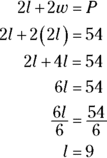
The length of one of the sides is 9 cm. Remember that a rectangle has four sides. If two of them are each 9 cm and the total perimeter is 54 cm, you can subtract 18 from 54 to find the length of the two remaining sides:

Two sides together are 36 centimeters, so each is 18 centimeters.
The dimensions of the rectangle are 9 centimeters by 18 centimeters, so now you can find the area:

The rectangle’s area is 162 square centimeters.
-
C. 2 feet
You may want to create a diagram to help you visualize the problem:

The swimming pool has a radius of 14 feet (the radius is half the diameter), and the width of the concrete surface is c. This problem requires you to find the area of the pool:

Knowing the area of the pool
 lets you find the area of the pool plus the concrete surface. Remember, the problem tells you the concrete surface’s area is
lets you find the area of the pool plus the concrete surface. Remember, the problem tells you the concrete surface’s area is
 square feet:
square feet: 
Find the whole area’s radius:

The whole area’s radius is 16 feet, so subtract 14 feet (the radius of the pool) from that to find out how wide the concrete surface is:

The concrete surface is 2 feet wide.
-
C. 7 cm
The formula to find the area of a square is
 , where A represents the area and s represents the length of one side. Replace A in the formula and solve for s:
, where A represents the area and s represents the length of one side. Replace A in the formula and solve for s: 
-
D. 729 cubic feet
To find the volume of a cube when you know its edge length, use the formula
 , where V represents volume and s represents edge length.
, where V represents volume and s represents edge length. 
The cube’s volume is 729 cubic feet.
-
B. 22 millimeters
The formula for the area of a circle is
 , where A represents the area and r represents the diameter. Find the radius with the area formula:
, where A represents the area and r represents the diameter. Find the radius with the area formula: 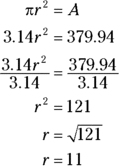
The diameter is twice the length of the radius, so if the circle’s radius is 11 millimeters, its diameter must be 22 millimeters.
-
B. 4 in.2
The problem describes a triangle that looks like this:

You know the base measures 2 inches and the height measures 4 inches. With this information, use the area formula for a triangle, which is
 , where A is the area, b is the base, and h is the height:
, where A is the area, b is the base, and h is the height: 
The triangle’s area is 4 square inches.
-
C. 9 inches
When you see hypotenuse in a word problem, dust off the Pythagorean theorem, which says
 . The variable c represents the hypotenuse — the longest side of the triangle — and a and b represent the shorter sides, which are the legs.
. The variable c represents the hypotenuse — the longest side of the triangle — and a and b represent the shorter sides, which are the legs.First, solve for a in terms of b (you could instead solve for b in terms of a, if you wanted to):

Now you have what you need to use the Pythagorean theorem; replace the variables with what you know:
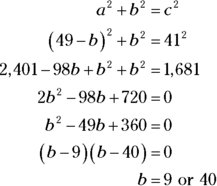
Solving this quadratic equation gives you both legs of the triangle, although the variable is only b. The shortest is 9 inches.
-
D. 8 in.
The formula to find the perimeter of a rectangle is
 , where P represents the perimeter, l represents the length, and w represents the width.
, where P represents the perimeter, l represents the length, and w represents the width.Find the lengths by using the perimeter formula:
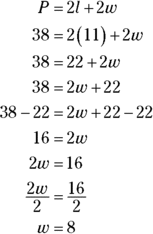
The other interior side of the picture frame is 8 inches long.
-
A. 100°
At first, you may think there isn’t enough information to find the answer — but there is, so Choice (D) is out of the question.
You already know that a triangle’s angles must add up to 180°. Let
 represent the greatest angle and create a formula that looks like this:
represent the greatest angle and create a formula that looks like this: 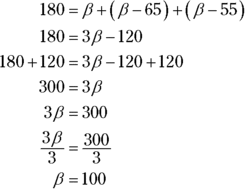
The greatest angle measures 100°.
-
D. 15 cm
Based on what the problem tells you, you can create a sketch to help you visualize the problem:

The square’s area is
 , and you can find the rectangle’s area by multiplying the length times the width. Create your formula for the area of the rectangle,
, and you can find the rectangle’s area by multiplying the length times the width. Create your formula for the area of the rectangle,
 , and solve for the length of one side of the square first:
, and solve for the length of one side of the square first: 
Now you have a quadratic equation to solve. In this case, factoring is the simplest way to solve it:

You know that the length of a side can’t be negative, so solve
 :
: 
The length of one side of the square is 5 centimeters. Now you can find the longest side of the rectangle, represented by 3s:

The longest side of the rectangle is 15 centimeters.
-
A. 9 feet
You have enough information to create an equation and solve for the garden’s width. Remember that area equals length times width, and solve:

Emil needs to build an 18-foot-by-9-foot garden to cover enough space to make Bertha happy.
-
A. 10 meters
If drawing diagrams helps you visualize problems, here’s what yours should look like:

The formula for the area of a triangle is
 , where A represents area, b represents the length of the base, and h represents height. The problem tells you that
, where A represents area, b represents the length of the base, and h represents height. The problem tells you that
 , so fill in the formula and replace the variables you know:
, so fill in the formula and replace the variables you know: 
Notice that –20 isn’t a solution, because the base of a triangle can’t be negative.
The base of the triangle is 20 meters, and the problem says that the height is half that, so the triangle’s height is 10 meters.
-
C. 283.39 square inches
The question is asking you to find the area of a circle with a diameter of 19 inches. You know that because it needs to have a
 -inch overlap all around.
-inch overlap all around.To find the area of a circle, use the formula
 . A circle’s radius is half its diameter, so in this case, it’s 9.5 inches:
. A circle’s radius is half its diameter, so in this case, it’s 9.5 inches: 
The manhole cover’s area is approximately 283.385 square inches, which you can round up to 283.39 square inches because it’s one of the answer choices.
-
A. 20 cu. ft
The problem deals with the volume of rectangular prisms. To find the volume, use
 , where V represents the volume, l represents the length, w represents the width, and h represents the height.
, where V represents the volume, l represents the length, w represents the width, and h represents the height. 
Each box holds 5 cubic feet of sand, but there are four boxes. Multiply 5 by 4 to find that the soldiers will have to put 20 cubic feet of sand into the boxes.
-
D. 942 in.3
To find the volume of a right cylinder, use
 , where V represents volume, r represents radius, and h represents height. The canister has a diameter of 10 inches, so its radius is 5 inches.
, where V represents volume, r represents radius, and h represents height. The canister has a diameter of 10 inches, so its radius is 5 inches.Plug in the values you know from the question and solve:

Using 3.14 for pi, you can tell that the canister holds approximately 942 cubic inches of pesticide.
-
C. 1,099 cm3
To find the volume of the soda in the can, use the formula
 , where V represents volume, r represents the radius, and h represents the height. Remember that 1 centimeter of space is left at the top of the can, so the actual height of the soda in the can is only 14 centimeters.
, where V represents volume, r represents the radius, and h represents the height. Remember that 1 centimeter of space is left at the top of the can, so the actual height of the soda in the can is only 14 centimeters. 
The volume of the soda is approximately 1,099 cubic centimeters.
-
B. 25 cm
The perimeter of any figure is the sum of all its sides, so create an equation that represents each side of the triangle, letting x represent the length of the shortest side. Let the second side be
 and the longest side be 4x. Set the sum of the sides equal to 162 and solve for x:
and the longest side be 4x. Set the sum of the sides equal to 162 and solve for x:

The triangle’s shortest side is 25 centimeters.
-
D. 33 cm2
This problem requires you to take a few steps to arrive at the answer. Create a table that lets you visualize what to use in your equation, letting x represent the length of one side of the square:

The problem gives you the perimeter of the rectangle, so use the perimeter formula to find the dimensions — you’ll need them to find the rectangle’s area. Remember that
 , where P represents perimeter, l represents length, and w represents width:
, where P represents perimeter, l represents length, and w represents width: 
Now you know that the original square’s sides each measured 5 centimeters. As the problem tells you, one side was increased by 6 centimeters to create the rectangle, while the other was decreased by 2 centimeters. That makes one side 11 centimeters and the other 3 centimeters. You can find the area of the rectangle with the formula
 , where A represents the area, l represents the length, and w represents the width:
, where A represents the area, l represents the length, and w represents the width: 
The rectangle’s area is 33 square centimeters.
-
B. 88°
Let
 represent the measure of the largest angle in the triangle, and remember that all the angles in a triangle add up to 180°. Create expressions that represent the other angles:
represent the measure of the largest angle in the triangle, and remember that all the angles in a triangle add up to 180°. Create expressions that represent the other angles: 
The measurement for the largest angle is
 because the sum of 18 and 33 is 51, and the smallest angle therefore has a measure that is 51° less than the largest angle.
because the sum of 18 and 33 is 51, and the smallest angle therefore has a measure that is 51° less than the largest angle.Create an angle-sum formula and solve for
 :
: 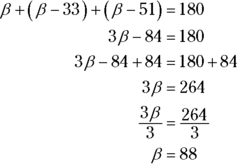
The largest angle is 88°.
You can check your work by finding the smallest and second angles and then adding them together to make sure the sum is 180°:

-
D. 95°
All the angles in a triangle must add up to 180°, so you can solve this problem with a little algebra:

The missing angle, angle C, is 95°.
-
A. 4,250 square feet
Don’t be distracted by extra information in an ASVAB word problem. What time each soldier started sweeping doesn’t matter, because the problem only asks you to identify the motor pool’s area.
You can draw a sketch of the motor pool so you can visualize the part that each specialist swept:

You know that Wolley’s portion of the motor pool was 50 feet by 35 feet (the problem tells you that his portion was 15 feet shorter than Vasquez’s area).
Figure out the area each soldier swept and add them together:

-
A. 96 ft2
This problem asks you for the number of square feet Deedee will have swept, which is the tip-off that you need to find area. The area of a rectangle can be expressed with the formula
 , where A represents area, l represents length, and w represents width. Replace the variables in the formula with the numbers from the problem:
, where A represents area, l represents length, and w represents width. Replace the variables in the formula with the numbers from the problem: 
Deedee will have swept 96 square feet, or 96 ft2.
Remember that area is always measured in square units, which makes Choice (C) a no-go right off the bat. (Any time you can automatically rule out answers on the ASVAB, do it.)
-
D. 36
One foot equals 12 inches, and the area of a square is the length of a side squared; that means a 1-foot square’s area is 144 square inches
 .
.Each block that Carson and Jolie stack has an area of 4 square inches
 . Divide 144 square inches by 4 square inches to find out how many blocks Carson and Jolie must stack:
. Divide 144 square inches by 4 square inches to find out how many blocks Carson and Jolie must stack:
 .
.You can check your work by finding the number of blocks they use on each side:

They’ll use 6 2-inch blocks on each side, which adds up to 1 foot on each side.
-
B. 161.25 cm2
To solve for the area of a kite, use
 , where d
1 represents the first diagonal and d
2 represents the second diagonal. The problem gives you both measurements, so plug them into the formula and solve:
, where d
1 represents the first diagonal and d
2 represents the second diagonal. The problem gives you both measurements, so plug them into the formula and solve: 
The kite’s area is 161.25 square centimeters.
-
B. 109.8 in.
To find the perimeter of a kite, use
 , where P represents perimeter, a represents one side, and b represents the adjacent side. Replace the variables in the equation with what you know from the problem to solve for the kite’s perimeter:
, where P represents perimeter, a represents one side, and b represents the adjacent side. Replace the variables in the equation with what you know from the problem to solve for the kite’s perimeter: 
The kite’s perimeter is 109.8 inches.
Be sure you read the answer choices carefully when you take the ASVAB, because attention to detail is incredibly important on the test (and in the military)! Two of the choices for this question simply have the numbers transposed.
-
D. 216 square inches
Sketch the two rectangles and assign variables. Let x represent the original width of the rectangle:

The formula for the area of a rectangle is
 , where A represents the area, l represents the length, and w represents the width. Figure out the area of the second rectangle by using the values from your sketch:
, where A represents the area, l represents the length, and w represents the width. Figure out the area of the second rectangle by using the values from your sketch: 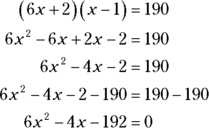
You can solve this quadratic equation by factoring:

Set each factor equal to zero (the zero factor principle says that if the product of two terms is zero, at least one of the original terms was zero):

Because you know that the width of a rectangle can’t be negative, you don’t have to solve the other equation (but if you did, you’d come up with
 ).
).The width of the original rectangle is 6 inches, and you know that the rectangle is six times as long as it is wide. Multiply 6 by 6, and you find that the original rectangle measures 36 inches long by 6 inches wide; then find the area:
 square inches.
square inches. -
C. 120 m2
The garden is square, so find its dimensions by finding the square root of its area:

Each side of the garden is 13 meters long.
The walkway needs to measure 2 meters across, so add 2 meters to each side to get the size of the garden and walkway together; each side is 17 meters long.
You can find the area of the entire project — the garden plus the walkway — by squaring 17:
 .
.Now subtract the smaller area (the garden) from the area covering the walkway and the garden:
 . The walkway’s area is 120 square meters.
. The walkway’s area is 120 square meters. -
B. 6.28 cm
The problem is asking you to find the circumference of two circles: one with a radius of 5 centimeters and one with a diameter of 12 centimeters.
It’s always a good idea to save time when you’re taking the ASVAB, so leave the answer in terms of pi until you need to solve with it. You can use the formula
 , where d represents diameter, or the formula
, where d represents diameter, or the formula
 , where r represents radius, to solve this problem. Start with the first circle; its circumference is
, where r represents radius, to solve this problem. Start with the first circle; its circumference is
 , or 10π. The second circle’s circumference is
, or 10π. The second circle’s circumference is
 .
.The difference between the two circles is
 . Now solve by replacing
. Now solve by replacing
 with 3.14:
with 3.14:
 . The difference is 6.28 centimeters.
. The difference is 6.28 centimeters. -
C. 18 cm
The problem tells you that you’re dealing with three consecutive integers (n,
 , and
, and
 ) and that the triangle’s perimeter is equal to eight more than twice the shortest side (n); therefore, your equation will look like this (remember, the perimeter of a triangle is the sum of all its sides):
) and that the triangle’s perimeter is equal to eight more than twice the shortest side (n); therefore, your equation will look like this (remember, the perimeter of a triangle is the sum of all its sides): 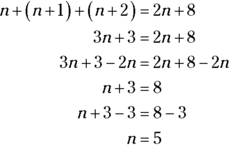
The triangle’s shortest side (n) measures 5 centimeters, and the second side
 is 6 centimeters. That means the final side
is 6 centimeters. That means the final side
 is 7 centimeters. (Because you know they’re consecutive integers, you can count to figure out the next two numbers.) Then add the three sides to find the triangle’s perimeter:
is 7 centimeters. (Because you know they’re consecutive integers, you can count to figure out the next two numbers.) Then add the three sides to find the triangle’s perimeter: 
The triangle’s perimeter is 18 centimeters.
-
A. 4 in.
The formula to find the area of a trapezoid is
 , where A represents the area, b
1 represents length of the first base, b
2 represents the length of the second base, and h represents the height. Replace the variables in the formula and solve:
, where A represents the area, b
1 represents length of the first base, b
2 represents the length of the second base, and h represents the height. Replace the variables in the formula and solve: 
The trapezoid is 4 inches high.
-
A. 24 cm2
The formula to find the area of a triangle is
 , where A represents area, b represents the length of the triangle’s base, and h represents the triangle’s height. Replace the variables and solve the problem:
, where A represents area, b represents the length of the triangle’s base, and h represents the triangle’s height. Replace the variables and solve the problem: 
The triangle’s area is 24 square centimeters.
-
B. 12 feet
You can use the area formula for a right triangle to figure out the mat’s height, because you know that the mat needs to fit in a 90° corner. The area formula for a right triangle is
 , where A represents area, b represents the length of the base, and h represents the triangle’s height. Your equation looks like this:
, where A represents area, b represents the length of the base, and h represents the triangle’s height. Your equation looks like this: 
Multiply both sides of the equation by 2 to simplify, and then solve:

Ms. Ruiz’s mat needs to have a 12-foot height.
-
C. 140 square feet
The formula to find the area of a trapezoid is
 , where A represents area, b
1 represents one base, b
2 represents the other base, and h represents the height. Replace the variables in the formula and solve:
, where A represents area, b
1 represents one base, b
2 represents the other base, and h represents the height. Replace the variables in the formula and solve: 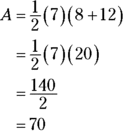
The trapezoid’s area is 140 square feet.
-
B. 180°
Create a sketch and assign variables that represent what the question is asking. Let x represent the measure of the smallest angles (your sketch doesn’t have to be to scale; after all, you don’t know the measure of the angles):

The sum of all the angles in a quadrilateral is 360°, so write your equation based on the values in your sketch:
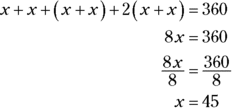
The smallest angles in the quadrilateral measure 45°, and the problem tells you that the fourth angle is twice the sum of the third angle. The third angle is equal to the sum of the two equal angles. That means
 is
is
 . Therefore,
. Therefore,
 is
is
 .
. -
D.

The formula to find the circumference of a circle is
 , where C represents the circumference and r represents the radius. Replace the variable r in the equation with the radius from the problem (12) and solve using pi:
, where C represents the circumference and r represents the radius. Replace the variable r in the equation with the radius from the problem (12) and solve using pi: 
-
C.

Use the formula to find the volume of a cylinder, which is is
 , where V represents the volume, r represents the radius, and h represents the height. Replace the variables in the equation and solve:
, where V represents the volume, r represents the radius, and h represents the height. Replace the variables in the equation and solve: 
You can also find the area of the base of the cylinder, which you can multiply by the cylinder’s height to get its volume.
To find the area of the base of the cylinder, use the formula to find the area of a circle:
 , where A represents the area and r represents the radius:
, where A represents the area and r represents the radius: 
The base’s area is
 cm2.
cm2.Multiply the base’s area by the cylinder’s height to find the volume:
 .
. -
D. 28.26 square feet
Draw a diagram that shows the horse’s grazing area:

From the diagram, you can see that the horse’s grazing area is part of a circle with a radius of 6 feet — that’s the length of the rope tying the horse to the post. You can also see that because the fence cuts into the circle at a 90° angle, the grazing area takes up 25%, or one-fourth, of the circle.
Find the area of one-fourth of the circle, remembering that
 (and that 25% of 36 is 9):
(and that 25% of 36 is 9): 
If you want to take the long route, find
 (remember,
(remember,
 ) to find that the area of the entire circle is approximately 113.04 square feet. Because the horse is confined to only a quarter of that circle, multiply the circle’s area by 0.25 to find the horse’s grazing area:
) to find that the area of the entire circle is approximately 113.04 square feet. Because the horse is confined to only a quarter of that circle, multiply the circle’s area by 0.25 to find the horse’s grazing area:
 square feet.
square feet. -
B. 1,944 cm2
The formula to find the surface area of a cube is
 , where SA represents surface area and s represents the length of one side. Replace the variables in the formula and solve:
, where SA represents surface area and s represents the length of one side. Replace the variables in the formula and solve: 
The cube’s surface area is 1,944 square centimeters.
-
C. 30.25 feet
The angle-angle similarity postulate lets you solve this problem because when you’re dealing with two right triangles that have a shadow cast at the same angle, the proportions of the triangles are the same.
Sketch the problem so you can assign variables and create an equation:

Because the triangles are similar, and because 5.5 is divisible by 11, you can set up a proportion that says 5.5 is to 11 as x is to 60.5, letting x represent the short leg of the larger triangle:

Isolate x to solve:

Vicki’s office building is 30.25 feet tall.
-
C. 198 sq. ft
To find the area of a parallelogram, use
 , where A represents the area, b represents the length of the base, and h represents the height.
, where A represents the area, b represents the length of the base, and h represents the height. 
The billboard covers 198 square feet.
-
A. 14 feet
The formula to find the area of a parallelogram is
 , where A represents the area, b represents the length of the base, and h represents the height. You can use this formula to find the missing height; replace the variables with what you know:
, where A represents the area, b represents the length of the base, and h represents the height. You can use this formula to find the missing height; replace the variables with what you know: 
The vegetable garden is 16 feet long and 14 feet high.
-
C. 42 in.2
You can find the area of a triangle with the formula
 , where A represents the area, b represents the length of the base, and h represents the triangle’s height. Replace the variables in the formula and solve:
, where A represents the area, b represents the length of the base, and h represents the triangle’s height. Replace the variables in the formula and solve: 
The triangle’s area is 42 square inches.
-
A. 35°
You know that all the angles in a triangle must add up to 180°, so you can create an equation that looks like this, where x represents the measure of the third angle:

The third angle measures 35°.
-
B. 34.54 feet
You can start solving this problem with a sketch that represents Cherina’s patio with the greatest possible hot tub in place:

You know that the hot tub can’t exceed 11 feet in diameter, because that’s the shortest side of Cherina’s patio. That means the maximum radius is 5.5 feet, which you can use to determine the circumference of the hot tub. The formula to find the circumference of a circle is
 , where C represents circumference and r represents radius:
, where C represents circumference and r represents radius: 
The maximum circumference Cherina’s hot tub can have is 34.54 feet.
-
B. 255 in.2
The formula to find the area of a triangle is
 , where b represents the length of the base and h represents its height. The triangle’s base, in this case, is two times the triangle’s height plus 4 inches:
, where b represents the length of the base and h represents its height. The triangle’s base, in this case, is two times the triangle’s height plus 4 inches:
 , and
, and
 . Replace the variables in the triangle area formula and solve:
. Replace the variables in the triangle area formula and solve: 
The triangle is 255 square inches.
-
B. 73°
Sketch the problem, remembering that opposite angles inside a quadrilateral are supplementary; they must add up to 180°. Your sketch doesn’t have to be to scale — it’s just a visual aid. You know the two angles in the problem can’t be opposite each other because they add up to more than 180°.
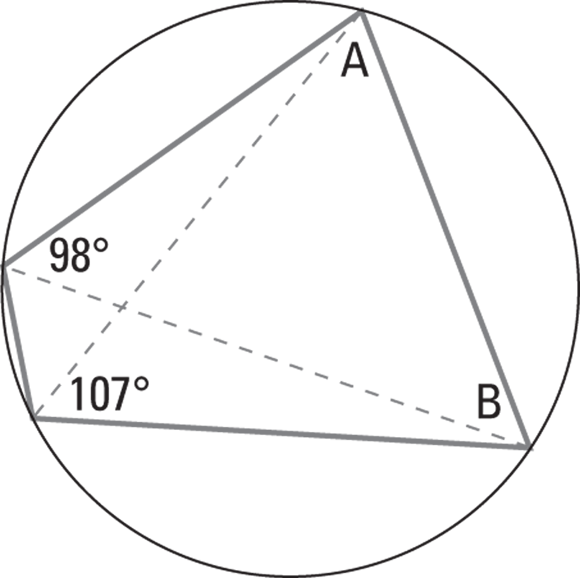
Figure out the missing angles A and B.

The smallest angle in the quadrilateral is
 , measuring 73°.
, measuring 73°. -
A. 78.5 m2
Find the area of the annulus — the area of the larger circle, minus the area of the smaller circle — by using the formula
 , where R represents the radius of the large circle and r represents the radius of the small circle. It’s just a spin on the formula you already know (
, where R represents the radius of the large circle and r represents the radius of the small circle. It’s just a spin on the formula you already know ( for the area of a circle). Remember, pi is approximately equal to 3.14.
for the area of a circle). Remember, pi is approximately equal to 3.14. 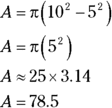
The area of the annulus is 78.5 square meters. (Make sure you’re handling like terms before you solve; if you didn’t do that on this problem, you’d reach Choice (D).)
-
D. 18 square yards
The formula to find the area of a rectangle is
 , where A represents the area, l represents the length, and w represents the width. Replace the variables in the formula to find the rectangle’s area:
, where A represents the area, l represents the length, and w represents the width. Replace the variables in the formula to find the rectangle’s area: 
The rectangle’s area is 18 square yards.
-
B. complementary.
When two angles add up to 90°, they’re considered complementary angles. The term supplementary refers to angles that add up to 180°, and congruent refers to angles that have the same measure in degrees or radians.
-
B. 3 in.2
Find the area of a triangle with the formula
 , where A represents the area, b represents the length of the base, and h represents the height:
, where A represents the area, b represents the length of the base, and h represents the height: 
The note’s area is 3 square inches, so Mandy is safe … this time.
-
A. 384 in.2
A cube has six sides, so to find its surface area, use the formula
 , where A represents the area and s represents the length of one side:
, where A represents the area and s represents the length of one side: 
Remember to take care of the exponent first; don’t try to multiply 6 by 8 and square the product. The cube’s surface area is 384 square inches.
-
C. 432 in. 2
You get all the scrap paper you can handle when you’re taking the ASVAB, so if it’s helpful, sketch the box. It’s a rectangular prism that looks like this:

The formula to find the surface area of a rectangular prism is
 , where SA represents surface area, w represents width, h represents height, and l represents length. Replace the variables in the formula to solve Nathan’s wrapping paper problem:
, where SA represents surface area, w represents width, h represents height, and l represents length. Replace the variables in the formula to solve Nathan’s wrapping paper problem: 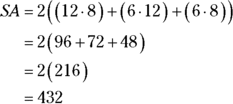
The surface area of the box is 432 square inches.
-
B. 523.33 in.3
The formula for the volume of a sphere is
 , where r represents the radius. Divide the diameter given in the problem by 2 to find that the sphere’s radius is 5 inches. Then replace the variables in the formula and solve:
, where r represents the radius. Divide the diameter given in the problem by 2 to find that the sphere’s radius is 5 inches. Then replace the variables in the formula and solve: 
The approximate volume of the sphere, using 3.14 for pi, is 523.33 cubic inches.
-
C. 6 in.
The formula to find the area of a parallelogram is
 , where A represents the area, b represents the length of the base, and h represents the height. You can find out how high the parallelogram stands in this problem by filling in what you know and solving for h:
, where A represents the area, b represents the length of the base, and h represents the height. You can find out how high the parallelogram stands in this problem by filling in what you know and solving for h:

The parallelogram is 6 inches high.
-
A. 50°
You can find the measurement of an inscribed angle with the formula
 , where m represents the measure of the angle. You know that
, where m represents the measure of the angle. You know that
 , so put that in the formula:
, so put that in the formula: 
The measurement of the inscribed angle — the vertex that is on the circle — is 50°.
-
D. 289 cu. in.
The formula to find the volume of a square pyramid is
 , where B represents the area of the base and h represents the height. Replace the variables in the formula and solve:
, where B represents the area of the base and h represents the height. Replace the variables in the formula and solve: 
The pyramid can hold 289 cubic inches of colored sand.
-
C. 23°
All the angles in a quadrilateral must add up to 360°, so you can subtract each of the angles from 360 to find out what’s left:
 .
.If you’re more comfortable with algebra, you can set up an algebraic equation:

Either way, you find that the missing angle,
 , is 23°.
, is 23°. -
A. 9,000 square feet
The problem describes a trapezoid (you can tell because there are two parallel lines, or bases, of different lengths that are connected by a perpendicular border), which you can visualize like this:

To find the area of a trapezoid, use the formula
 , where A represents the area, b
1 represents the length of one base, b
2 represents the length of the second base, and h represents the trapezoid’s height. Replace the variables in the formula with what you know from the problem and solve:
, where A represents the area, b
1 represents the length of one base, b
2 represents the length of the second base, and h represents the trapezoid’s height. Replace the variables in the formula with what you know from the problem and solve: 
The customer’s lawn is 9,000 square feet.
-
A. 30°
Remember that when you’re dealing with angles formed outside a circle,
 is the intersection of two secants outside of a circle. You can find the angle outside the circle by finding half the difference of the intercepted arcs, so your formula looks like this:
is the intersection of two secants outside of a circle. You can find the angle outside the circle by finding half the difference of the intercepted arcs, so your formula looks like this: 
The measure of
 is 30°.
is 30°.If you need to visualize this problem, draw a sketch that looks like this:
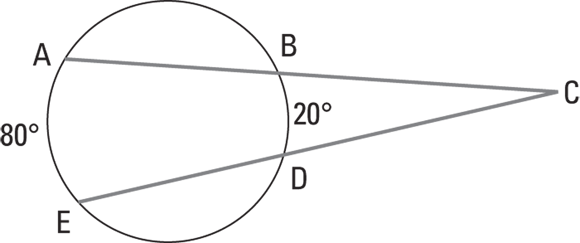
-
B. 399 ft2
This problem asks you to find facts, do some arithmetic, and then use the formula for the area of a rectangle, which is
 , where A represents area, l represents the length, and w represents the width.
, where A represents area, l represents the length, and w represents the width.First figure out the new rectangle’s dimensions by adding 13 to each original side:

Now put the new dimensions into the area formula:

The new rectangle has an area of 399 square feet.
-
B. 3.4 quarts
Find the square footage of Josie’s room, and remember to subtract some space for the door. Each wall is 80 square feet (they’re all 10 feet long and 8 feet high, and the area formula for a rectangle is
 , where A represents the area, l represents the length, and w represents the width):
, where A represents the area, l represents the length, and w represents the width): 
Subtract the area of the door (14 square feet):

Each quart of paint covers about 90 square feet, so divide the total answer by 90 to find out how many quarts Josie needs:

-
C.

The formula to find the circumference of a circle is
 , where C represents the circumference and r represents the radius. Because the question asks you to find the exact circumference, leave
, where C represents the circumference and r represents the radius. Because the question asks you to find the exact circumference, leave
 in your answer:
in your answer: 
-
A. 28.26 in.2
There’s a lot of extra information to sift through in this problem. The bottom line: You need to find the approximate area of a circle with a radius of 3 inches. The formula for the area of a circle is
 , where A represents the area and r represents the circle’s radius:
, where A represents the area and r represents the circle’s radius: 
Each coaster that Mr. Gray carves has an approximate area of 28.26 square inches.
-
C. 4,936 feet
This problem is really only asking you to find the perimeter of a square. To find the perimeter, add the lengths of the sides together; in this case, because each side is the same length, you can just multiply one side by 4 (there are four sides on a square):

You’ve walked 4,396 feet. (Now run around the same city block at least two more times so you’re in shape for your first physical fitness test in the military!)
Tip: If you’re running out of time on the ASVAB, here’s a neat shortcut for this problem (and others like it, provided the answer choices aren’t rounded): Multiply the ones digits first:
 . That tells you that the answer has to end in 6, so Choice (C) is most likely correct.
. That tells you that the answer has to end in 6, so Choice (C) is most likely correct. -
D. 400 feet
You know that the city can lay 1,200 square feet of concrete each month and that the sidewalks are all 3 feet wide. Use the area formula, which is
 , where A represents the area, l represents the length, and w represents the width, to find out how long each stretch of sidewalk will be:
, where A represents the area, l represents the length, and w represents the width, to find out how long each stretch of sidewalk will be: 
The city can install a 400-foot-long stretch of sidewalk each month.
-
B. 19.6 in.2
First find out the diameter of the puddle after an hour and a half; it loses 1 inch each half hour, so after an hour and a half, it has lost 3 inches.
The puddle’s diameter is now 5 inches, and you can use that to solve for area using
 , where A represents the area and r represents the radius (remember that a circle’s radius is half its diameter):
, where A represents the area and r represents the radius (remember that a circle’s radius is half its diameter): 
The puddle’s area is about 19.6 square inches.
-
D. 80°
All angles in a triangle must add up to 180°, so use algebra to create an equation. Let a represent the smallest angle in the triangle:

The smallest angle in the triangle measures 25°, but the problem asks you for the measurement of the largest angle. In the equation, you represented the largest angle with the expression
 , so replace the variable and solve:
, so replace the variable and solve: 
The largest angle in the triangle measures 80°.
You can double-check your work by figuring out the value of the second angle, which you represented with the expression 3a:
 . Add all the angles together to make sure they add up to 180°:
. Add all the angles together to make sure they add up to 180°:
 .
. -
D. Both A and B are correct.
The formula for the area of a triangle is
 , which can also be expressed as
, which can also be expressed as
 . In both formulas, A represents the area, b represents the length of the base, and h represents the triangle’s height. Therefore, Choice (D) is correct.
. In both formulas, A represents the area, b represents the length of the base, and h represents the triangle’s height. Therefore, Choice (D) is correct. -
B. 180°
Davy completed half a circle, which is 180°.
-
A. 31.4 square inches
First, find the area of the cherry pie. Because the cherry pie’s pan measured 9 inches across, it has a radius of 4.5 inches. Use the area formula for a circle, which is
 , where A represents area and r represents radius, and leave the answer in terms of pi until the last step to save time:
, where A represents area and r represents radius, and leave the answer in terms of pi until the last step to save time: 
Do the same with the area of the apple pie:

Now find the difference by subtracting the cherry pie’s area from the apple pie’s area:
 .
.Solve, remembering that pi is approximately equal to 3.14:

The apple pie is 31.4 square inches greater than the cherry pie.
-
D. 1,805 square feet
The formula to find the area of a trapezoid is
 , where A represents the area, b
1 represents the length of the first base, b
2 represents the length of the second base, and h represents the trapezoid’s height.
, where A represents the area, b
1 represents the length of the first base, b
2 represents the length of the second base, and h represents the trapezoid’s height.Fill in what you know from the problem and solve for area:

Jesse’s soon-to-be laser tag field is 1,805 square feet.
-
B. 6.25 m2
The perimeter of any shape is the distance around it. If a square, which has four equal sides, has a perimeter of 10 meters, each side must measure 2.5 meters (divide 10 by 4, and the answer is 2.5).
To find the area of a square, use the formula
 , where A represents the area and s represents the length of one side:
, where A represents the area and s represents the length of one side: 
The square’s area is 6.25 m2.
-
B. 90°
A circle has 360°, and when you look at a clock in terms of 3, 6, 9, and 12, you’re dividing it into four parts, or quadrants. Each quadrant has a measure of 90°, which is how far the minute hand will have to travel between the number 9 and the number 12.
-
C. 120°
Supplementary angles must add up to 180°. Let x represent the measure of
 (the smaller angle) and let 2x represent the measure of
(the smaller angle) and let 2x represent the measure of
 . Create an equation:
. Create an equation: 
Angle B measures 60°, so the measure of
 is twice that; it’s 120°.
is twice that; it’s 120°. -
B. 49°
The term congruent means that both angles have the same measure. That means both artists drew 49° angles.
-
A. –0.2
When two lines are perpendicular, you know that
 — in other words, the slopes are negative reciprocals of each other. In that equation, m
1 represents the slope of the first line, and m
2 represents the slope of the second line.
— in other words, the slopes are negative reciprocals of each other. In that equation, m
1 represents the slope of the first line, and m
2 represents the slope of the second line.Replace the variable in the equation and solve:

Convert
 to the decimal –0.2; that’s Line A’s slope.
to the decimal –0.2; that’s Line A’s slope. -
B. $1,560
First find the area of the room using
 , where A represents the area, l represents the length, and w represents the width:
, where A represents the area, l represents the length, and w represents the width: 
The room’s area is 234 square feet. Now convert that to yards, remembering that because
 , a square yard is
, a square yard is
 :
: 
The room is 26 square yards, so now figure out the cost by multiplying 26 by $60:

It will cost $1,560 to put hardwood floors in the room.
-
C. 65 cm2
Figure out the area of the larger square by using
 , where A represents the area and s represents the length of a side:
, where A represents the area and s represents the length of a side: 
The larger square has an area of 81 cm2, so subtract the smaller square’s area:

-
A. 35 miles
Sergeant Jones rides his bicycle 5 miles each day, and there are 7 days in a week. Multiply:

In one week, Sergeant Jones will ride his bicycle 35 miles.
-
C.

The sample size is 99 (remember, either a motorcycle or pickup truck has already left the parking lot). Let C represent the event of a sports car leaving.

The probability of a sports car leaving next is
 , which you can reduce to
, which you can reduce to
 .
. -
D. All of the above are correct.
A ratio is a way to compare two or more different things. You can express a ratio in three ways: using a colon, using a fraction, or using the word “to” between the numbers.
Make sure the numbers in the ratio appear in the same order as they appear in the question. If the question had asked, “What is the ratio of birthday cakes to wedding cakes,” you’d flip the numbers (24:16, and so on).
-
C. 7.2 cups
This problem requires you to set a proportion using ratios. (Forget the baking powder — the question asks you how much flour the baker needs.)
Out of 24 cups of flour, the baker can make 10 cakes. You can express that this way:

To find out how much flour he needs to make only three cakes, create an expression that looks like this:

Put your two ratios together, cross-multiply, and solve for x:

The baker will need 7.2 cups of flour to bake three cakes.
Alternatively, you can solve this problem by figuring out that the baker needs 2.4 cups of flour per cake (he needs 24 cups to bake 10). Multiply that by 3 to find out how much flour he needs in this problem:
 .
. -
D. 49°
You may find it helpful to draw a quick diagram that looks like this (in the military, this diagram is called a strip map):

Angles on the same line must be supplementary, which means they need to add up to 180°.
Because the problem asks you to find the measure of the angle on the southwest corner of Notting Hill and Van Dorn, and it tells you the measure of the angle of the northwest corner (131°), subtract that from 180° to find the right measurement:
 .
.The angle at the southwest corner of Notting Hill and Van Dorn is 49°.
-
A.

Gordon spent
 of
of
 hours actually cooking. Convert
hours actually cooking. Convert
 into an improper fraction. Now multiply the fractions:
into an improper fraction. Now multiply the fractions: 
Gordon spent
 of an hour cooking.
of an hour cooking. -
C. 6.76 million
There are 26 letters in the alphabet, and there are 10 possible numbers for each of the last four digits of the password, which you can express this way:

Multiply each of the figures in the diagram:

There are 6.76 million possible passwords.
-
C. $6.88
To figure out what fraction is
 of
of
 , multiply the fractions:
, multiply the fractions: 
Amira spent
 of the her allowance money on pens, so multiply to find out how much
of the her allowance money on pens, so multiply to find out how much
 of $11 is:
of $11 is: 
Now divide 55 by 8 to find out how much money Amira spent:
 . Because the problem asks for a dollar amount, round up to $6.88.
. Because the problem asks for a dollar amount, round up to $6.88. -
C. 888
To find out how many games the hockey player won, multiply 1,200 by 0.74:

The hockey player won 888 games over the course of his career.
-
B. 8%
This week, potatoes sell for $0.06 more than they did last week (last week, they were $0.75, and this week, they’re $0.81). Find the percent increase over the original price by dividing that $0.06 by $0.75:

That’s an 8% increase in the price of potatoes.
-
B. 108
Set up a ratio to express the original quantity:

You need to figure out how many dogs there will be if there are 192 horses, so create a proportion that uses d to represent the number of dogs while ensuring that both ratios are equal to each other:

Cross-multiply and solve for d:

If there were 192 horses, there would be 108 dogs.
-
D. $35.00
The markup is 40% of the original cost of clothing. The problem tells you that the retailer spent $25 on jeans, so find 40% of $25:

The retailer will mark up the price on the jeans by $10, so customers must pay a total of $35 for the jeans (
 ).
).You can also multiply $35 by 1.4 to find the total cost.
 means the customer will pay 140% of the original price.
means the customer will pay 140% of the original price. -
B. $55
Let x represent how much the shoe salesman spends on the shoes wholesale, and let 0.45x represent the markup (the salesman marks up the shoes based on the price he pays for them).
Create an equation that reflects the problem and solve for x:

The salesman spends $55 on each pair of shoes he sells.
-
C. $352.75
Multiply $415 by 0.15 to find out how much money a buyer will save on the TV:

Now subtract $62.25 from the TV’s original price, $415:

The TV is on sale for $352.75.
A faster method is to multiply $415 by 0.85, because the price paid is 85% of the normal price (
 ).
). -
B. 10 pounds of white flour at $1.49 each and two 8-ounce bags of wheat flour at $0.90 each
You can immediately rule out Choice (A), because if Mrs. Stevens buys 6 bags of white flour and 4 bags of wheat flour, she’ll have only 10 pounds of flour; she won’t have enough flour to bake rolls for every student. Now find the costs of the other choices:
- Choice (B) would cost the school $16.70 (
 and
and
 ).
). - Choice (C) would cost the school $17.83 (
 and
and
 ).
). - Choice (D) would cost the school $19.69 (
 ), making it the most expensive option. (You could rule out this answer immediately because $1.79 is a high price, second only to the pound of wheat flour in Choice (B), so you know the other choices will cost less.)
), making it the most expensive option. (You could rule out this answer immediately because $1.79 is a high price, second only to the pound of wheat flour in Choice (B), so you know the other choices will cost less.)
Choice (B) is the least expensive option, so Mrs. Stevens should choose 10 pounds of white flour and two 8-ounce packages of wheat flour.
- Choice (B) would cost the school $16.70 (
-
C. 6
When the candy bin is full, it contains 36 candy bars (a dozen is 12, and
 ). Find
). Find
 of a dozen:
of a dozen: 
Then multiply by the number of dozens Nuan will have when the bin is full to get the number she’ll have when she needs to reorder:

Nuan needs to reorder the candy bars when there are 6 left.
-
C. 23
Sachi isn’t a very good roommate.
The alarm clock chimes every five minutes, or 12 times per hour. Sachi’s alarm sounded from 6:25 a.m. until 8:15 a.m. That’s 1 hour and 50 minutes, or
 hours. Multiply the number of alarms by the number of hours:
hours. Multiply the number of alarms by the number of hours: 
Don’t forget to add one more; the alarm clock rang at 6:25 as well, which means Sachi’s alarm went off 23 times before he got up.
(Military Tip: Turn up your alarm clock’s volume to its maximum setting and sleep with the clock across the room. The old military saying “If you’re 10 minutes early, you’re 5 minutes late” has been known to get plenty of new recruits into trouble.)
-
D. 260
There are 10 possibilities on the first reel (remember, 0 is a possibility). There are 26 possibilities on the second reel. Multiply the first set of possibilities by the second set of possibilities:

There are 260 possible combinations standing between Robbie and his birthday presents.
-
B. 81.28 cm
One foot is equal to 12 inches, so your ratio will look like this:

Let c represent the number of centimeters you’re trying to find and set up a proportion using the information you have from the problem:

(You could say, “12 inches is to 30.48 centimeters as 32 inches is to c centimeters.”)
Cross-multiply and solve for c:

There are 81.28 centimeters in 32 inches.
-
C. 108
Sketch a diagram that represents the least fraction in the problem, which is
 (you’ll have nine equal parts):
(you’ll have nine equal parts): 
Now you know that
 of the books are new. Because there are 81 new books and three blocks in your diagram represents that number, divide 81 by 3 to find out how many books each block represents:
of the books are new. Because there are 81 new books and three blocks in your diagram represents that number, divide 81 by 3 to find out how many books each block represents: 
Five of the blocks in your diagram represent used books, so multiply 27 by 5 to find out how many used books the bookstore has:

Because only one block in your diagram represents audiobooks, you know that the store has 27 audiobooks. Subtract the number of audiobooks from the number of used books to find the answer to the original question:

The bookstore has 108 more used books than audiobooks.
-
B. 800 miles
This problem is asking you to multiply two separate expressions. First, multiply the speed and the time Javier and Gloria drove the first day:

Next, multiply the speed and the time the pair drove the second day:

Add the distances together:
 , so the beach is 800 miles from Gloria and Javier’s home.
, so the beach is 800 miles from Gloria and Javier’s home. -
D. 160
This ratio problem is simple to solve with a diagram. You have a total of nine parts (4 for females and 5 for males), so sketch two rows:

All 9 parts together equal 360 (there are 360 recruits in this cycle). Divide 360 by 9 to figure out how many recruits each block in your diagram represents:

Because there are four blocks in your diagram that represent females, and because each block represents 40 recruits, multiply 40 by 4 to find out how many females are in this cycle:

There are 160 females.
You can check your work by simplifying a fraction:

One hundred sixty recruits out of 360 are females, so reduce that as far as you can; you’ll end up with
 , which is the original part-to-total ratio.
, which is the original part-to-total ratio. -
D. $2,158.20
The ring cost $1,199, so find out what Oroka’s annual insurance costs by finding 15% of the ring’s value and multiplying it by 12 (because there are 12 months in a year):

Work through the calculations:

Insurance over the course of a year will cost $2,158.20, which means Oroka would probably better off buying an extra ring and skipping the insurance.
-
A. 100
Sketch out a diagram to help you visualize the problem. You need 12 equal blocks to represent Micah’s entire music collection:

You can see that seven of the blocks represent Micah’s 175 alternative music CDs, so divide 175 by 7 to find out how many CDs each block in the diagram represents:

Four blocks represent classic rock, so multiply 25 by 4 to find out how many classic rock CDs are in Micah’s collection:

Micah has 100 classic rock CDs.
-
C. 35 feet
For many people, it’s easier to convert the fraction
 into the decimal 1.75 in problems such as this one.
into the decimal 1.75 in problems such as this one.You know that the perimeter formula is
 (where P represents the perimeter, l represents the length, and w represents the width) and that the chicken coop’s length is 1.75 times its width. Set up an equation and solve for width:
(where P represents the perimeter, l represents the length, and w represents the width) and that the chicken coop’s length is 1.75 times its width. Set up an equation and solve for width: 
The chicken coop is 35 feet wide.
-
D. 336
Multiply 42 cups by 8 ounces:

You can hold 336 ounces of liquid in 42 cups.
-
C. $720
Divide the total cost by 52 weeks to find out how much it costs each week:

You can then multiply 60 by 12 to find out how much housekeeping will cost for 12 weeks:

It will cost $720 for 12 weeks’ worth of housekeeping services.
-
D. 3.5 hours
Assuming that Diana keeps up the same pace, figure out how long it takes Diana to run 15 miles by dividing 15 by 7.5 (it’s often easier to convert fractions into decimals):

Diana can run 15 miles in 2 hours. Now you need to figure out how long it takes her to run 1 mile. Divide 2 hours (or 120 minutes) by 15 miles:

She’s running a mile every 8 minutes, so multiply that by 26:

Diana can run 26 miles in 208 minutes, which translates into about 3.5 hours (
 ).
).Just a note on running: The military has strict requirements on running times, and they’re based upon gender and age groups. The Navy, Coast Guard, and Air Force require you to run 1.5 miles for your semiannual physical fitness tests, the Army requires you to run 2 miles, and the Marines require you to run 3 miles.
-
A. 72
Divide 36 cups by
 to find out how many servings are in the bag:
to find out how many servings are in the bag: 
There are 72 servings in a 36-cup bag of rice if each serving is
 cup.
cup.Some people can quickly work out this problem mentally, without going through the steps of division and multiplication. If you can do that on the ASVAB, you should. You have only a few minutes to spend on each question, so the more quickly you can answer easier questions, the better you’ll do.
-
D. 12
You have three different categories: beverages, entrées, and desserts. Each is an independent event, so first sketch out the different ways each event could occur:

Multiply all the possible combinations:

There are 12 different meal combinations with this menu.
-
C. 7:09 p.m.
Divide 72 pages by 8 (the printer can print 8 pages per minute):

It will take the printer 9 minutes to complete the print job, so because Pascual started printing at 7:00 p.m., he’ll be finished at 7:09 p.m.
-
A. $650
You have the sale price and the markdown price, but you need to find the markdown amount to find the original price.
Assign variables so you can solve this problem. Let x represent the laptop’s original price, and let 0.25x represent the markdown of the original price (the new price is 25% off the original price).
Create an equation using the information you have:
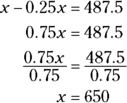
The laptop’s original price was $650.
-
A. 2,400 square feet
Figure out the area of the driveway by multiplying 20 by 30:

The driveway is 600 square feet.
That 600-square-foot driveway represents 25% of the yard, so let x represent the original area of the yard, write an equation, and solve for x:

The yard’s original size was 2,400 square feet.
-
D. 2 hours
Don’t let the extra information in this word problem throw you off. You’ll find plenty of questions on the ASVAB that require you to dive in and pull out the facts.
An average giant tortoise moves at 0.17 miles per hour. Divide the giant tortoise’s distance (0.34 miles) by its speed (0.17 mph):

It would take the average giant tortoise 2 hours to move 0.34 miles.
-
B. 8
To find out how many tables Kim and Gerry’s wedding planner needed to set up, divide 96 by 12:

There were 8 guest tables at the wedding.
-
D. 11,893
First find 5% of the population by multiplying 11,327 by 0.05:

Now add that to South Lyon’s current population:

The new population is the old population plus the increase.
One of the town’s residents isn’t 35% of a person, so round down to 11,893. At the next census, if the growth rate in South Lyon is 5%, that’s what the population will be.
-
B. 6,190 meters
This is a multiplication problem. Multiply Mount Everest’s height (8,848 meters) by 0.7 (the decimal equivalent of 70%):

Rounded to the nearest ten, Denali stands at 6,190 meters high. (Interestingly, it’s precisely 6,190 meters, or 20,310 feet, above sea level.)
-
A. 70 gallons
First find out how much water the sprinkler puts out in 35 minutes by multiplying the number of minutes by 12:

In 35 minutes, the sprinkler puts out 420 gallons of water.
Now find out how much water the hose puts out in 35 minutes using the same method:

The hose puts out 490 gallons of water over a 35-minute period.
Subtract the amount of water the sprinkler uses from the amount of water the hose uses to find the answer:

The hose puts out 70 more gallons of water than the sprinkler does.
A quicker way to work this problem is to find the difference per minute (
 ) and multiply that by the total time. In 35 minutes, the hose puts out
) and multiply that by the total time. In 35 minutes, the hose puts out
 more gallons than the sprinkler.
more gallons than the sprinkler. -
B.

The problem tells you there are 16 marbles in the jar and that 6 of them are blue. You have a 6 out of 16 chance of pulling out a blue marble, which you can express as the fraction
 . Reduce the fraction to
. Reduce the fraction to
 — that’s the probability of pulling a blue marble out of the jar.
— that’s the probability of pulling a blue marble out of the jar. -
D. 550 megabits
Multiply the amount of data your Internet connection can transmit (50 mbps) by the number of seconds (11):

Your Internet connection will transfer 550 megabits in 11 seconds.
If you’re choosing an IT or communications field in the military, you should know that megabits are different from megabytes; it takes eight megabits to make up a megabyte.
-
D. 125
The problem tells you that
 , or 75%, of the children attending a particular school are engaged in extracurricular activities. Find out how many kids are part of these activities by multiplying 500 by 0.75:
, or 75%, of the children attending a particular school are engaged in extracurricular activities. Find out how many kids are part of these activities by multiplying 500 by 0.75: 
The remaining children are not participating in extracurricular activities, so to find that number, subtract 375 from the total number of students:

One hundred twenty-five kids aren’t participating in extracurricular activities.
You can also think of the problem this way: If 75% are participating, then 25% are not, so
 . Or you can find the answer by dividing 500 by 4.
. Or you can find the answer by dividing 500 by 4.
